Reviewing American’s best 777-200 business class on the new nonstop to Tel Aviv
Before last summer, the world’s largest airline hadn’t flown to Israel in over five years.
That changed on May 6, when American Airlines landed in Tel Aviv (TLV) once again, with a brand-new route from New York-JFK. Since then, the carrier has added a second route from Miami (MIA) and has plans to launch a third from Dallas-Fort Worth (DFW) on March 5, 2022.
American inherited US Airways’ longest route from Philadelphia (PHL) to Tel Aviv during the merger, but cut the flight just months after absorbing the airline, noting “the route had not been profitable.”
This time around, American’s New York flight is buoyed by the Northeast Alliance with JetBlue, which is designed to provide additional domestic feed through JFK. As for service from Miami and Dallas-Fort Worth, the former is an “opportunistic move,” while the latter has been in the works for a while.
When I first heard the news that Israel was reopening to vaccinated tourists, I knew which airline I needed to try: American.
In the past, I’ve flown with American’s three competitors in the New York-Tel Aviv market (Delta, United and Israel’s flag carrier, El Al), and I even had the opportunity to try US Airways’ Philly flight before it ended in January 2016.
How would American’s Israel relaunch stack up against the incumbents? I couldn’t wait to find out.
For more TPG news delivered each morning to your inbox, sign up for our daily newsletter.
In This Post
Booking
American’s New York to Tel Aviv flight is available for purchase through all the traditional booking channels.
A note about availability: Since the flight launched — and especially in recent weeks with Israel’s reopening — it’s been full.
Case in point: My Saturday night departure was sold out in business class, had one empty premium economy recliner and just seven empty coach seats.
There’s lots of pent-up demand for travel to Israel, and that’s been translating to higher fares in both business and premium economy.
I booked two weeks before departure, and when I did, there was just one business-class seat left for purchase in the full-fare “J” class. I monitored availability in the days leading up to the flight and one more seat became available in a discounted fare class, so I grabbed it.
I ended up ticketing a round-trip with American – one way in business and the return in premium economy – for roughly $3,700, booked with TPG’s Business Centurion Card from American Express, which offers a 50% rebate on points redeemed toward paid travel.
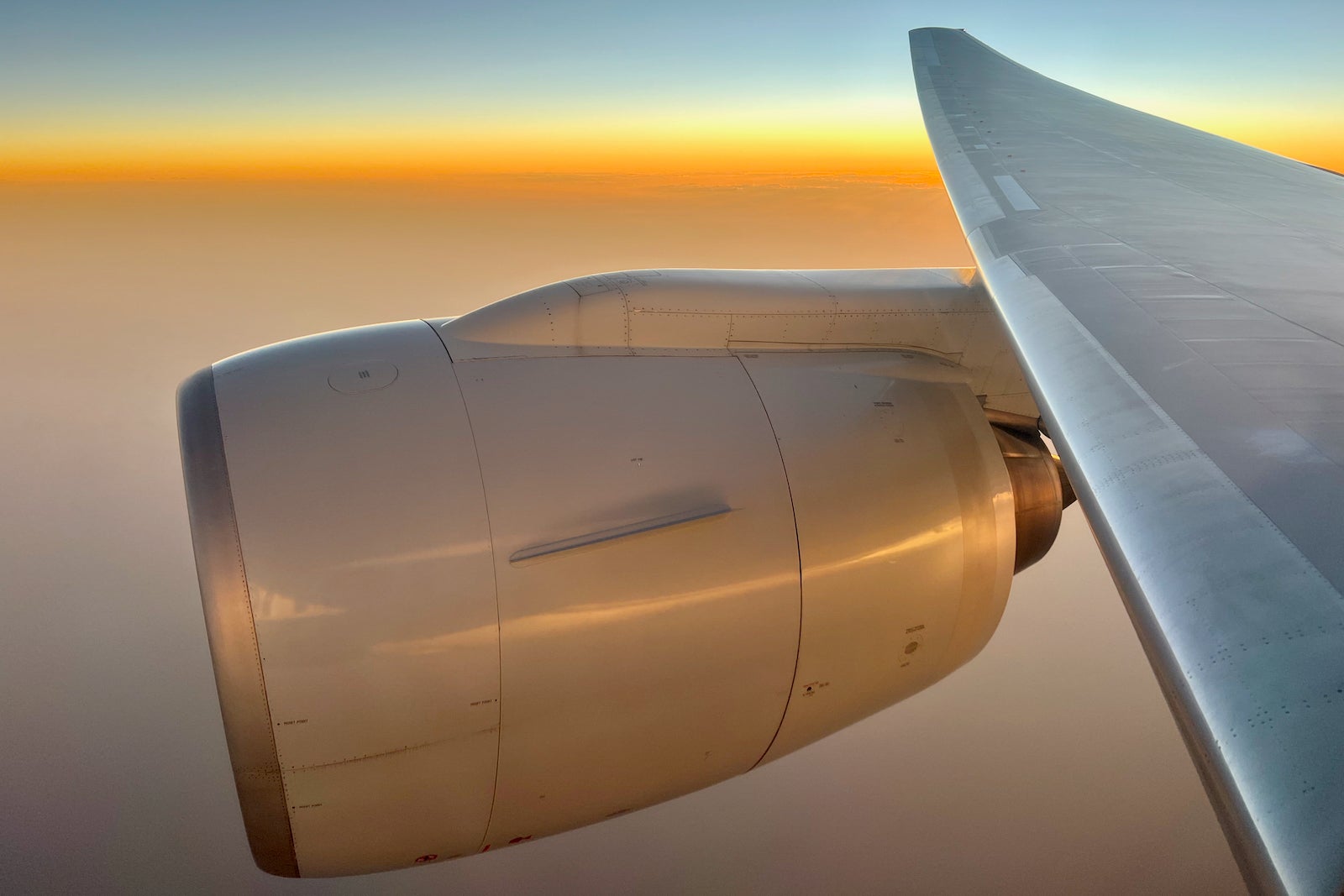
I then managed to confirm a bump to business class on the return using a systemwide upgrade, which I earned as a top-tier elite member. The flight had three open business-class seats for purchase, so I was quite surprised that the upgrade was instantly confirmed.
For now, round-trip business-class fares on American’s flight hover between roughly $4,000 and $7,500-plus. Premium economy and coach are more affordable, with round-trip fares starting at $750 and $1,400, respectively.
As expected for the high demand, saver award availability is nearly nonexistent in business class. American instead prices its awards dynamically, and mileage requirements on this route range between 66,000 and 180,000 AAdvantage miles each way.
Had saver awards been available, they’d cost 70,000 miles when booked through American’s AAdvantage program. As a Oneworld member, you could also redeem miles with one of American’s partners, though the best bet for most people will likely be booking directly through American.
If you’re planning to travel in the short term, I’d recommend locking in your tickets as soon as possible, especially if you’d like a prime seat – whether that’s an aisle or window in coach or a solo business-class pod in the pointy end.
This increased demand isn’t limited to American’s new route to Tel Aviv: Nonstop flights on other airlines from New York, especially during peak periods, are filling up.
Ground experience
Of the airlines operating in the New York to Israel market, American’s business-class ground experience is one of the best.
My time with American began when I arrived at the curb at Terminal 8, the airline’s home at JFK.
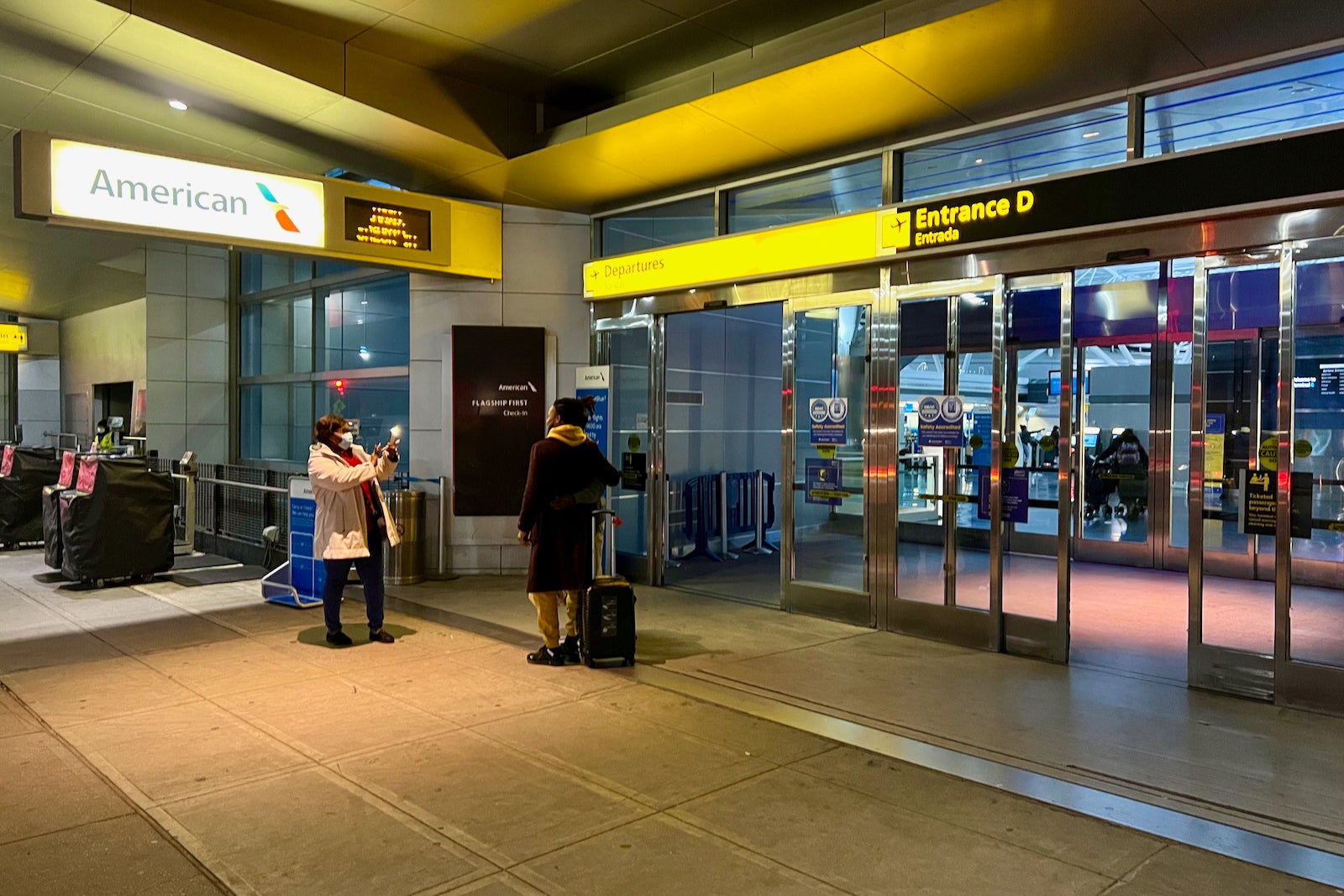
I quickly walked inside and made my way to the dedicated Flagship First check-in area, which is open to top-tier Executive Platinum members flying on long-haul routes, along with invite-only Concierge Key elites and a few others.
This check-in area is separate from the kiosks and Priority area in Terminal 8.
Once inside, I was welcomed and addressed by name throughout the check-in process. My entry documents and COVID-19 test certificate were then thoroughly examined, including a consult with a manager, and I was issued a boarding pass shortly thereafter. (Online check-in for Tel Aviv flights is unavailable due to the required document checks.)
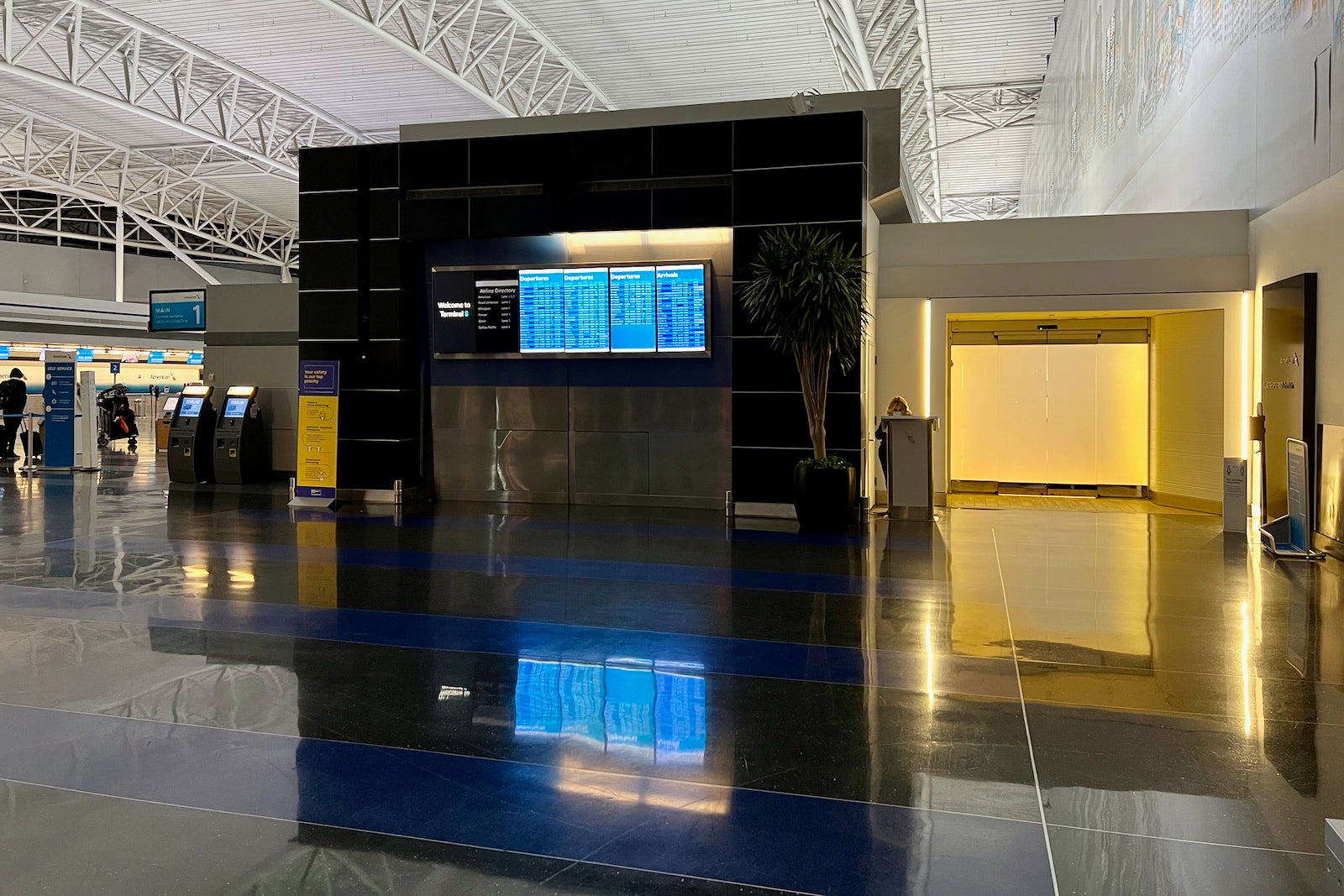
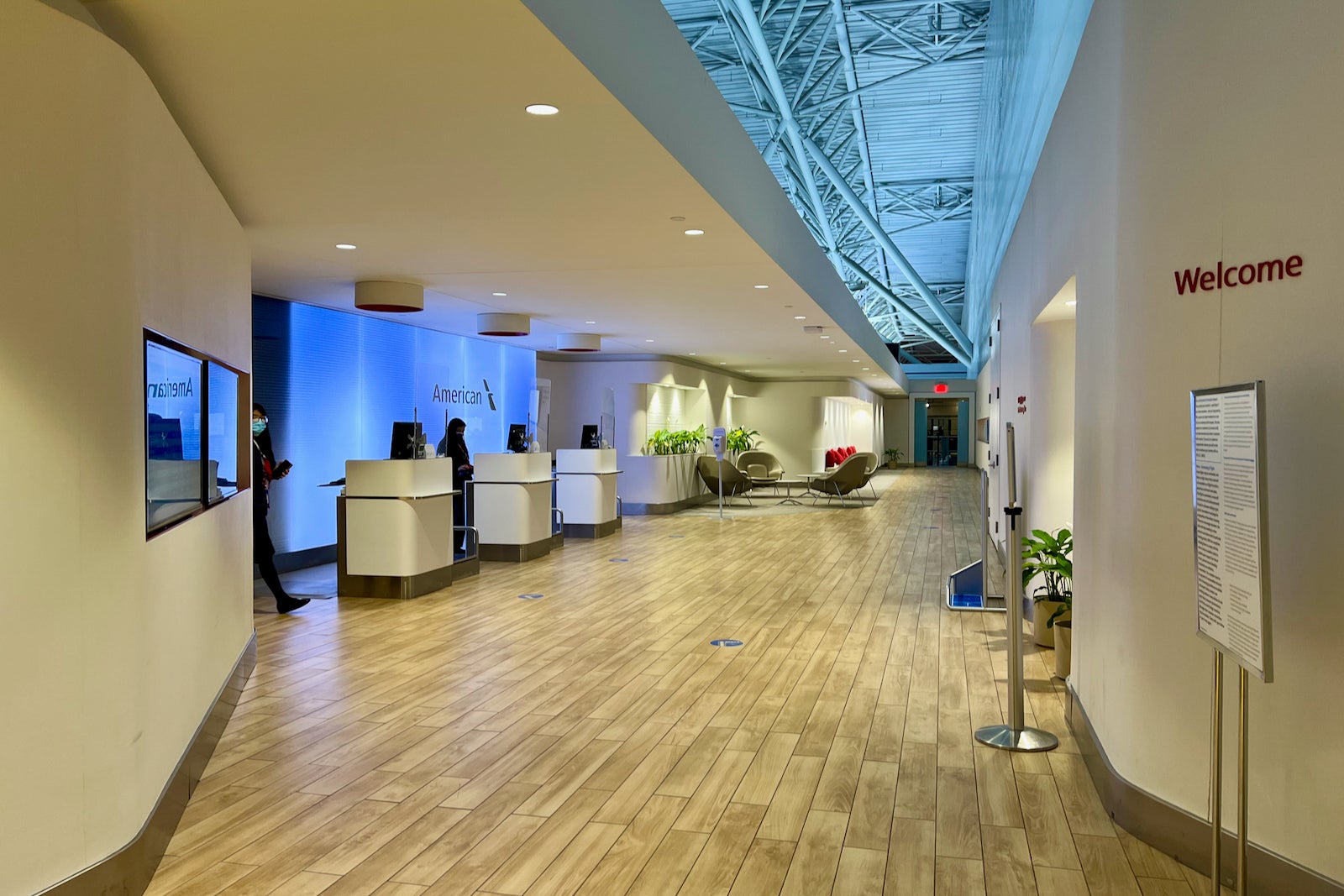
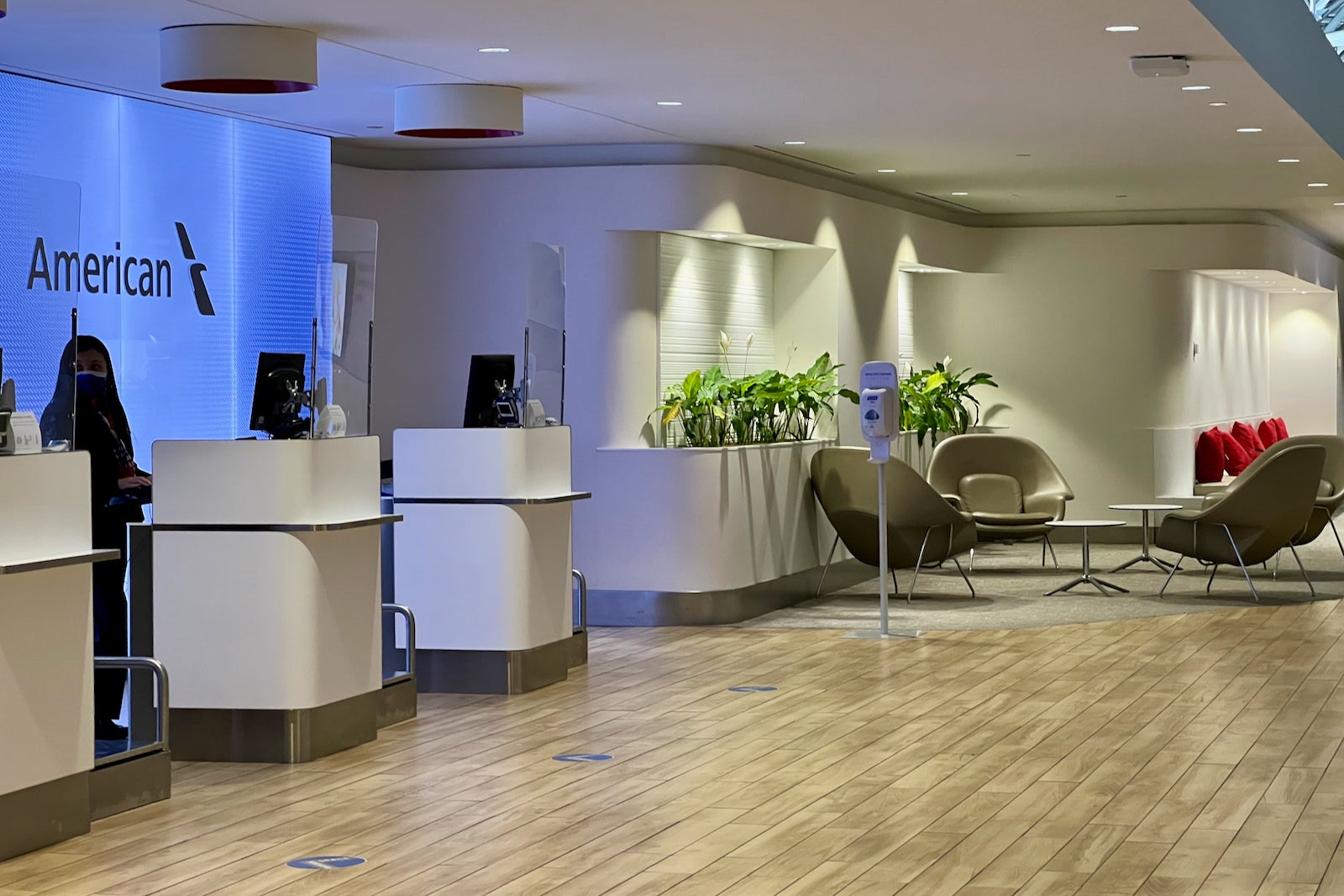
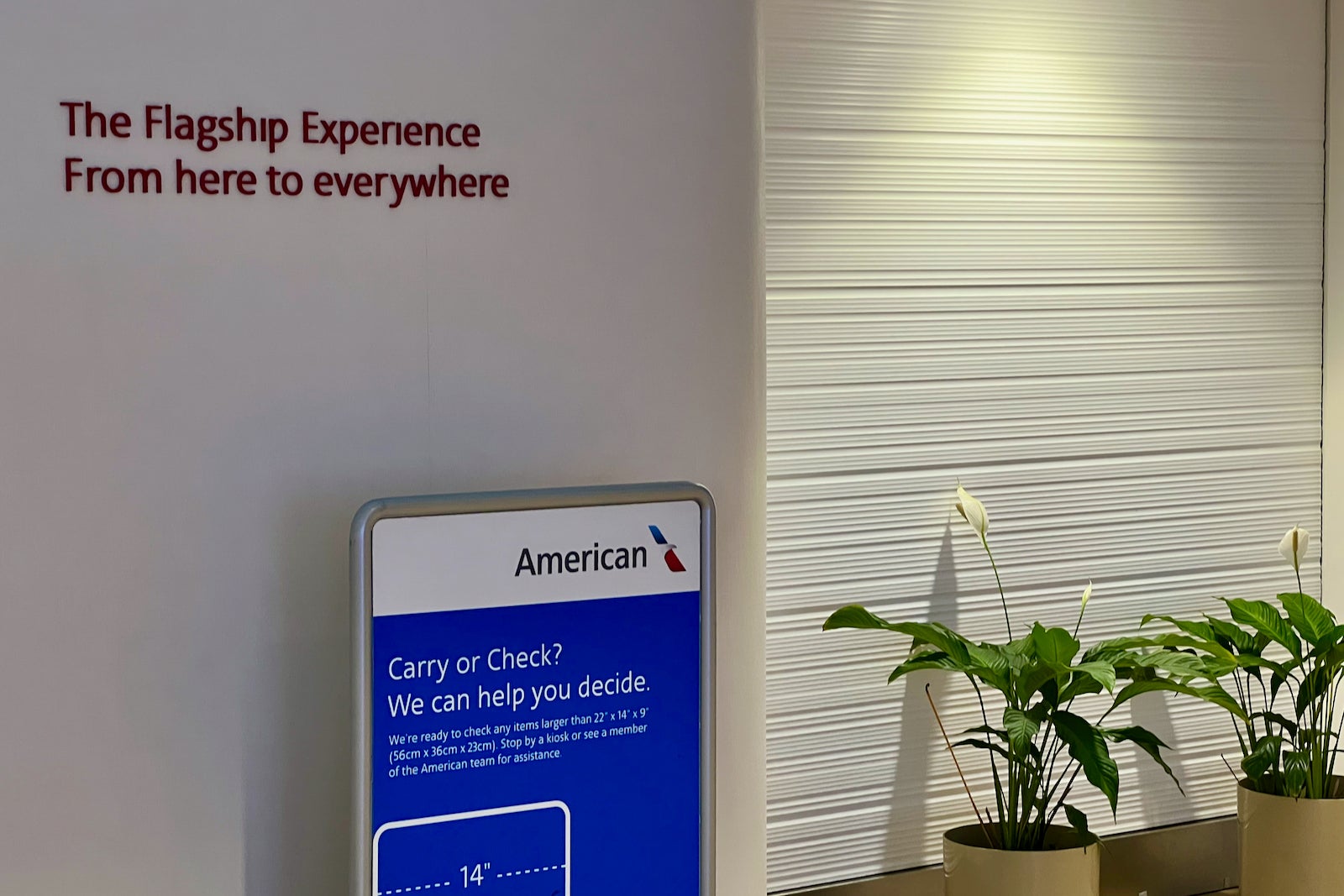
From there, I was escorted through the security checkpoint by the check-in agent. She brought me to the front of the line and bid me farewell after I cleared.
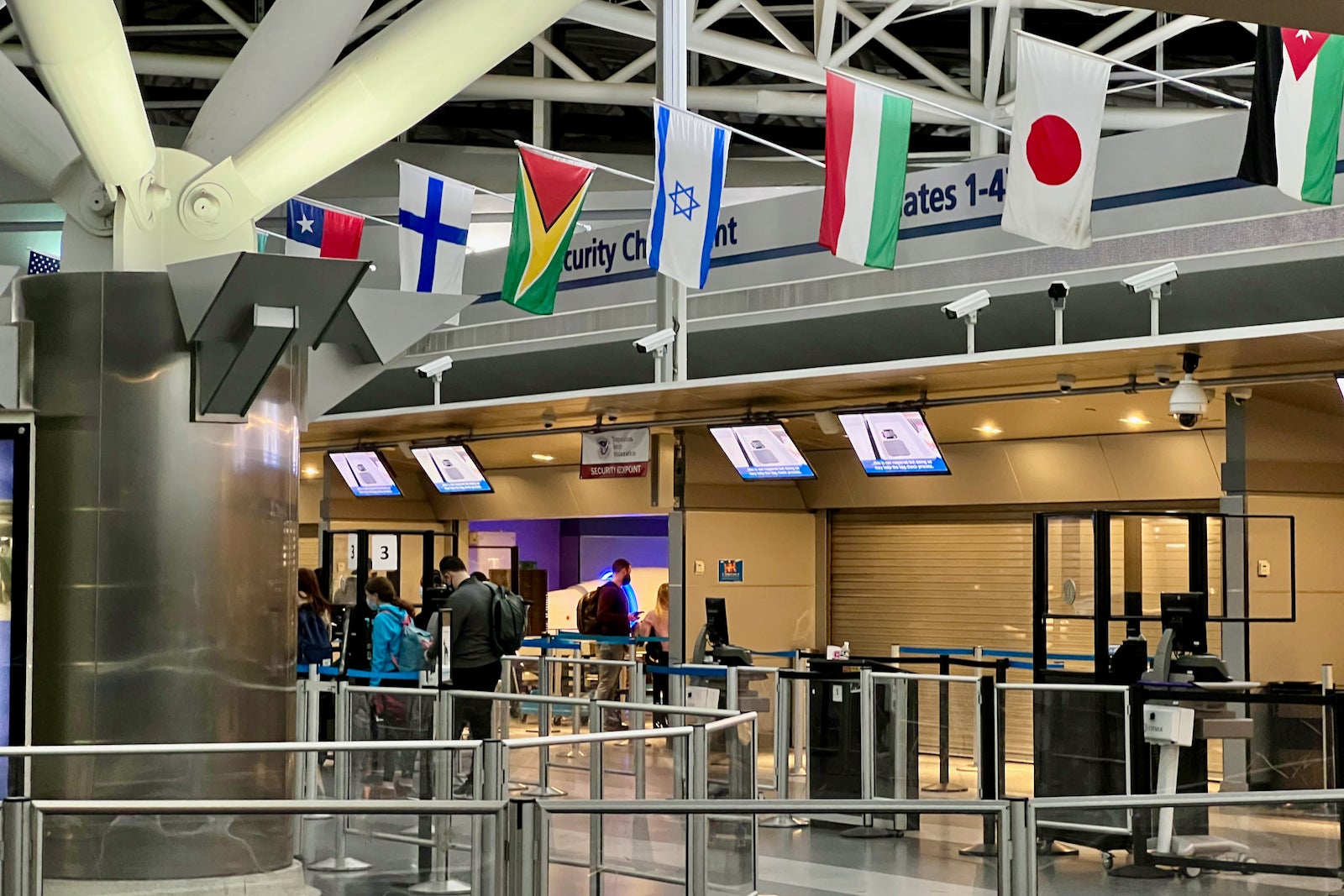
For non-elite business-class flyers, check-in is processed at the Priority counter, and there’s no escort through security.
From TSA, I headed to the Flagship Lounge located on the upper level, just steps from the security checkpoint.
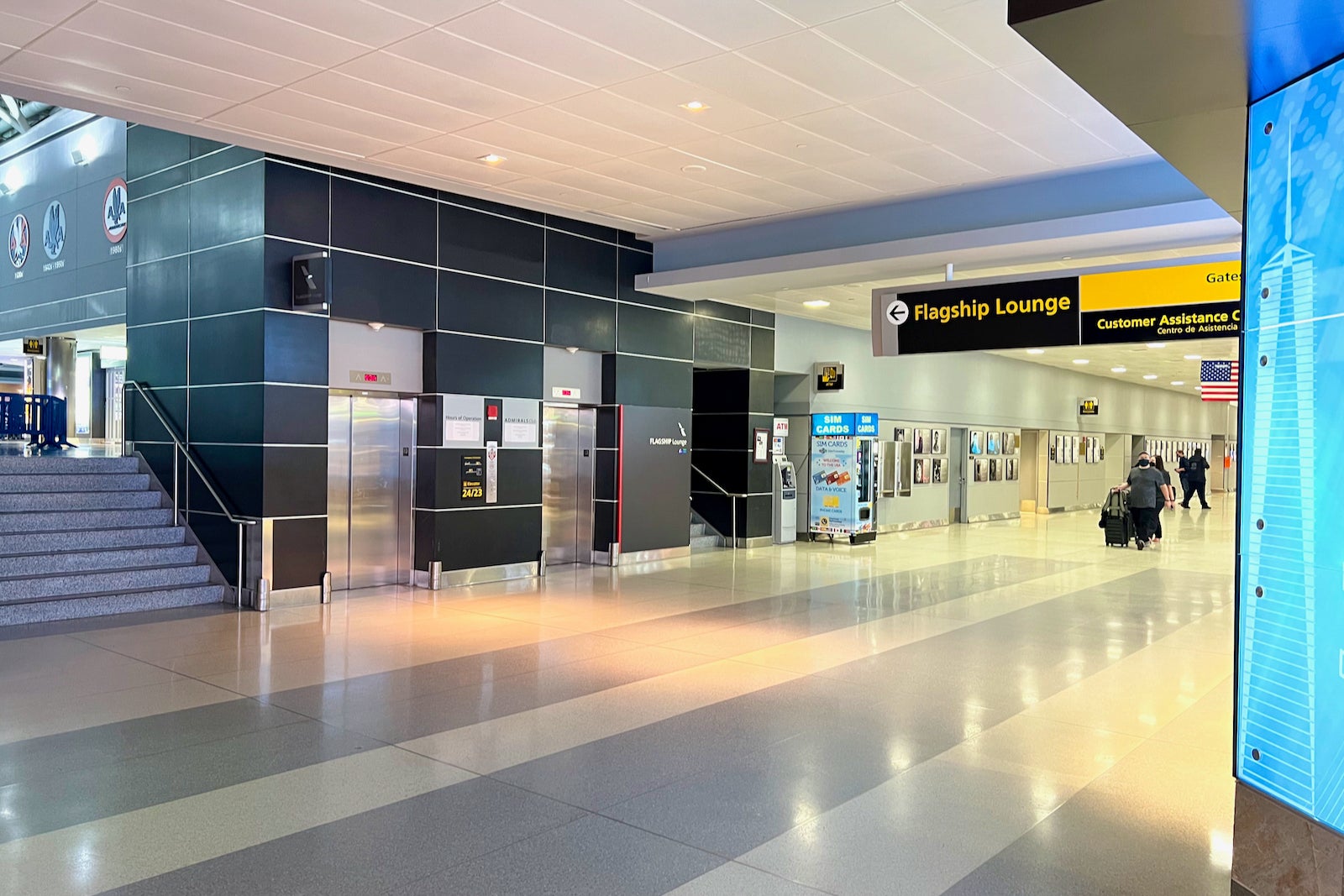
The Flagship Lounge recently reopened after an 18-month-long closure. All long-haul business-class travelers, as well as certain top-tier elites, can enter this lounge.
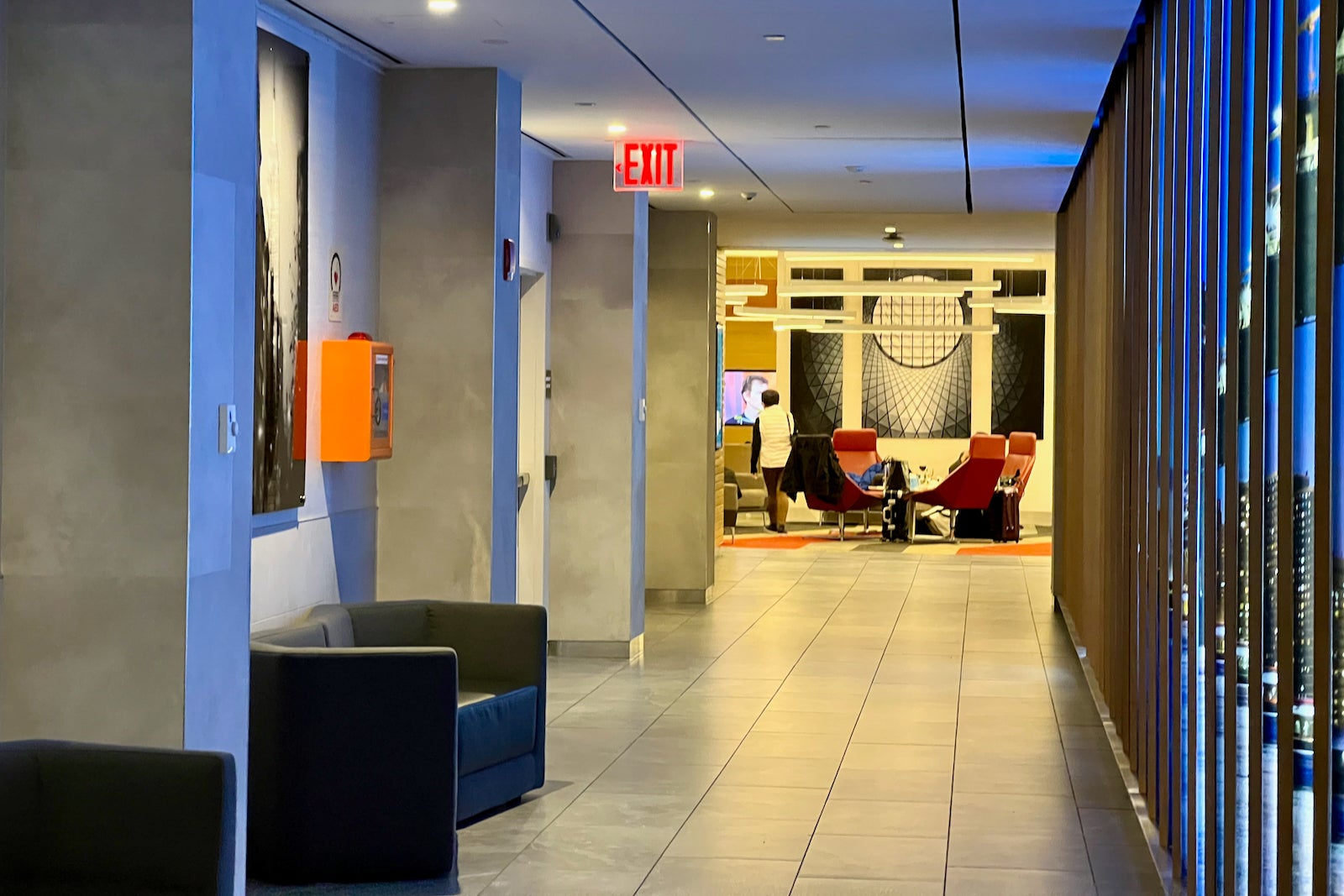
I was welcomed inside with a glass of Louis Roederer 242 Brut Champagne, one of the key changes in American’s overhauled Flagship Lounge experience.
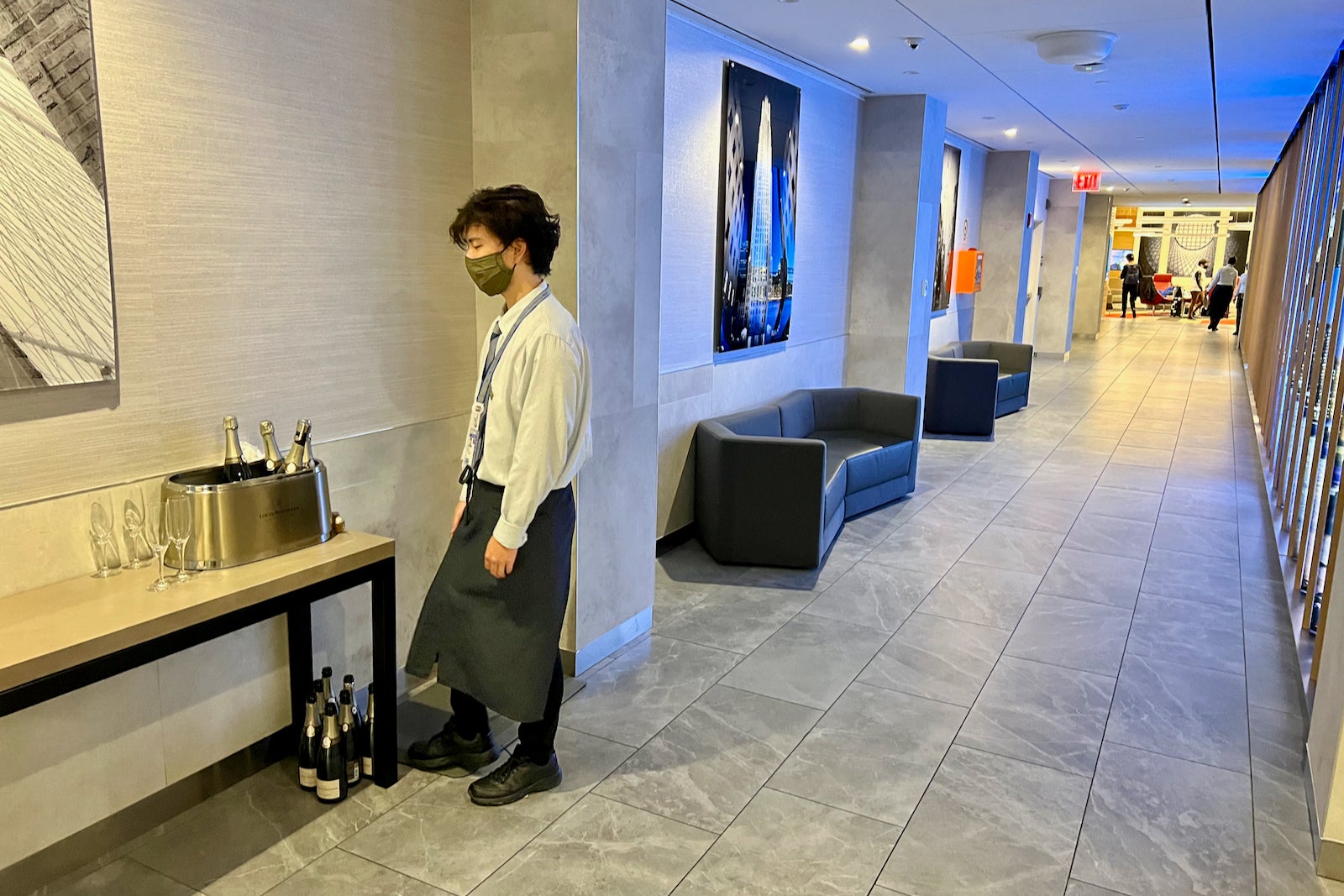
Despite being a Saturday night, it was packed inside. Nearly every seat was taken, and the buffet area was busy.
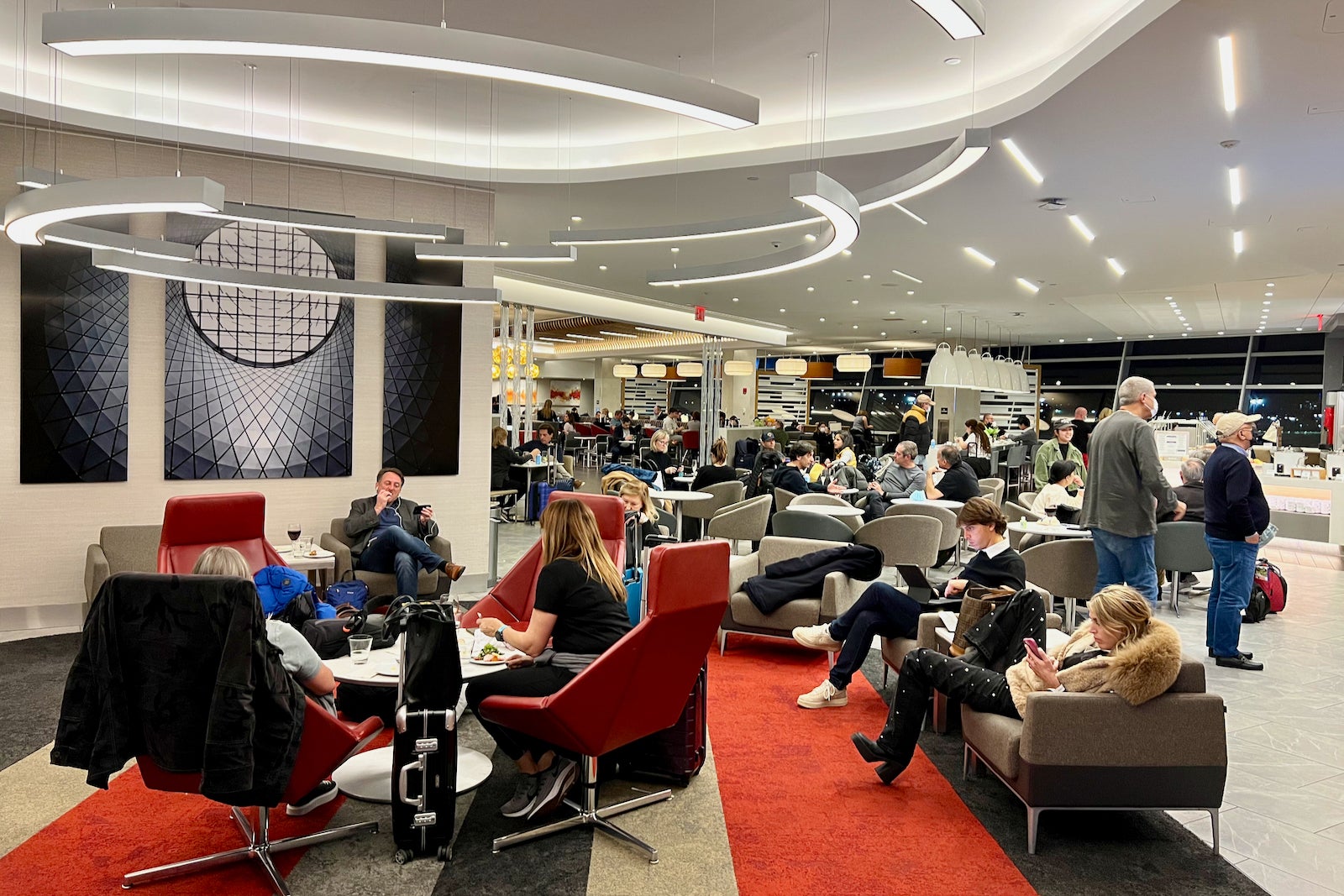
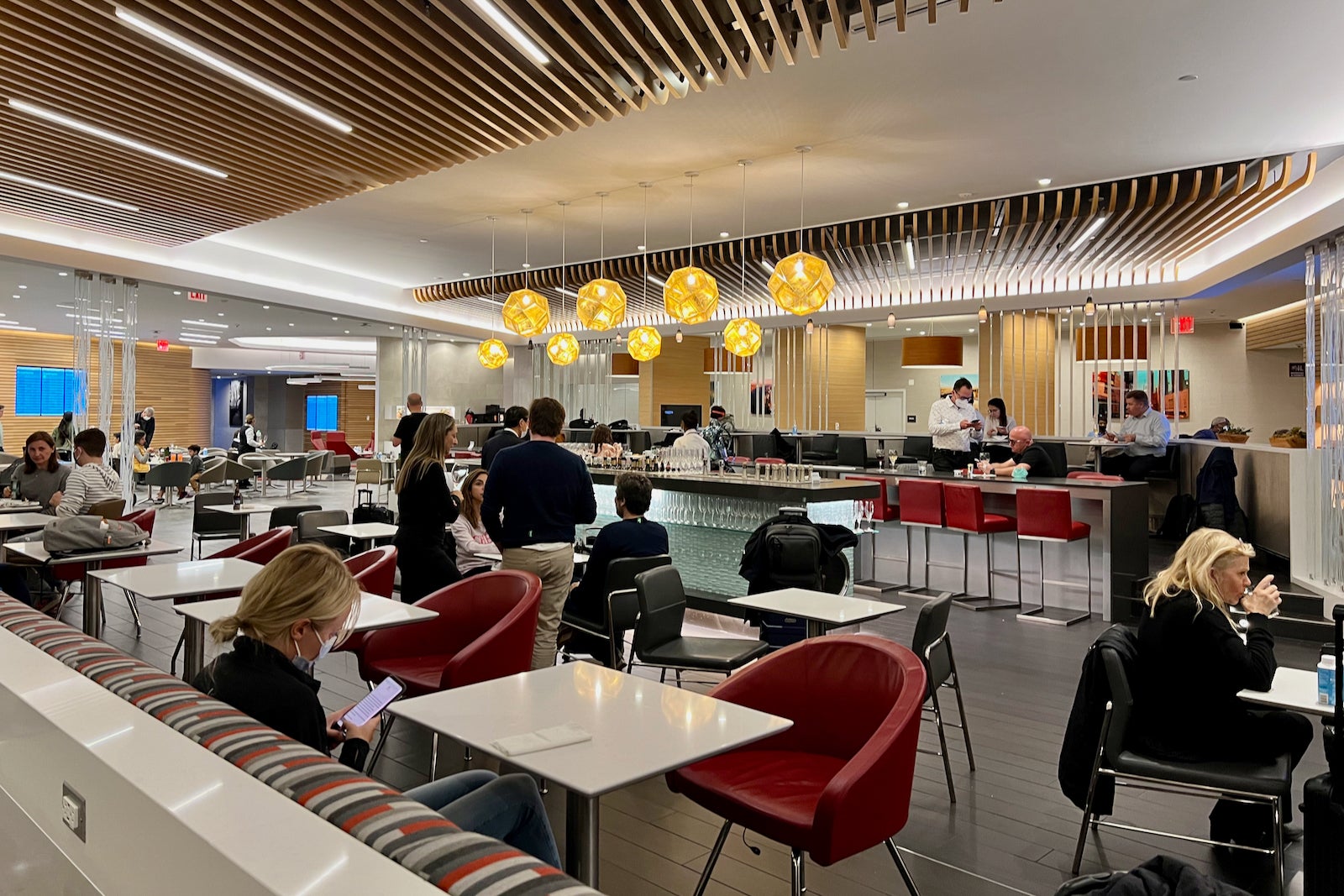
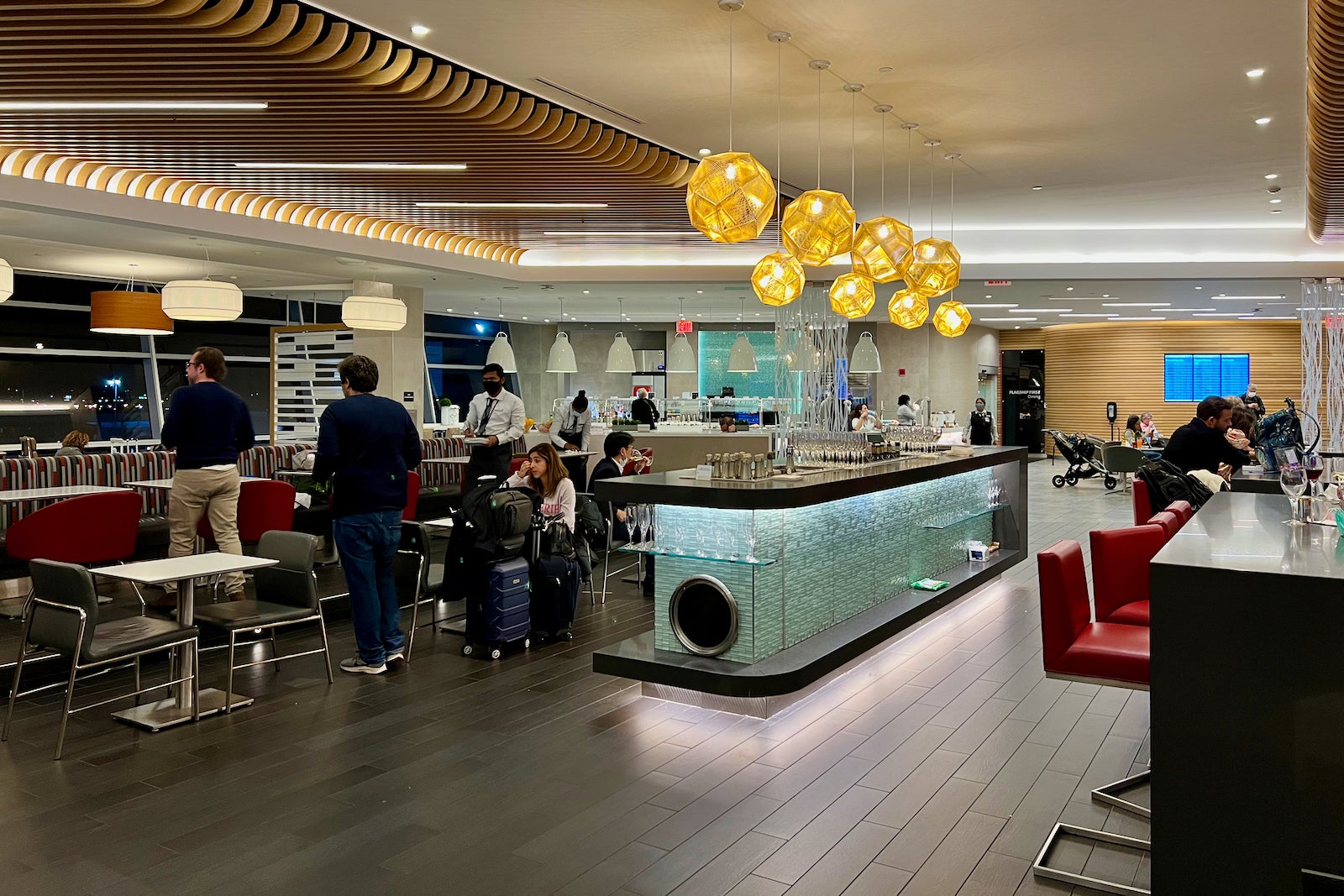
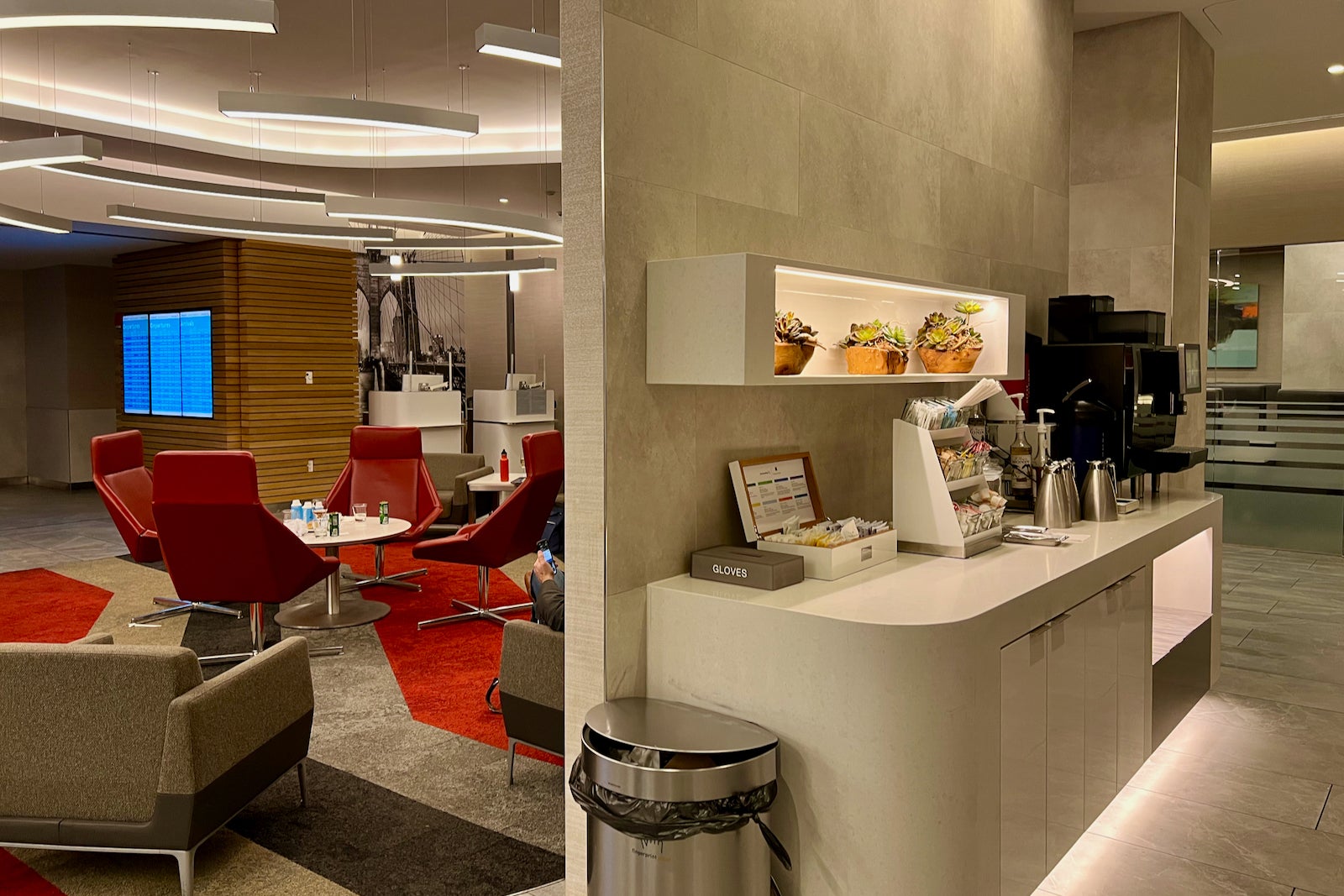
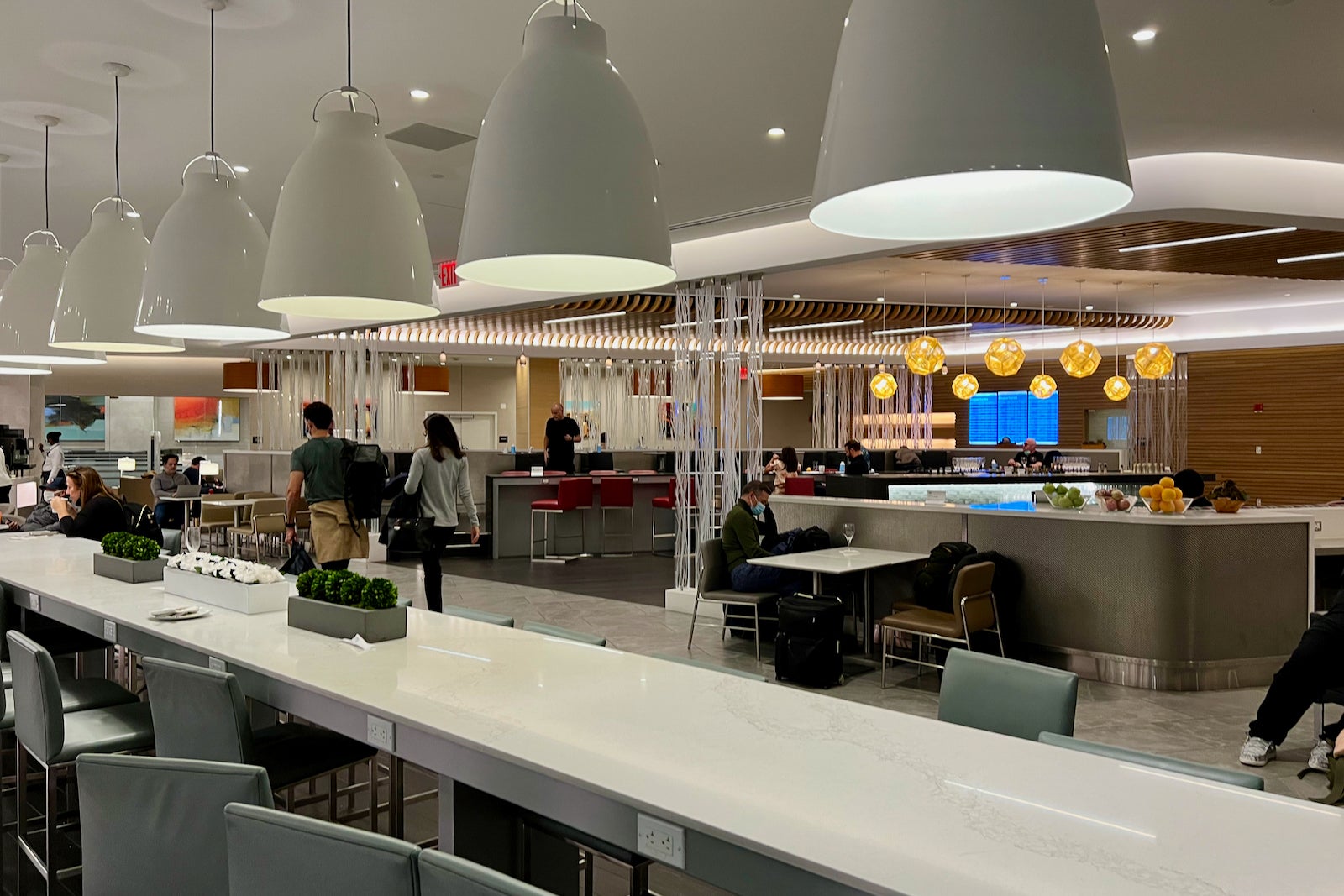
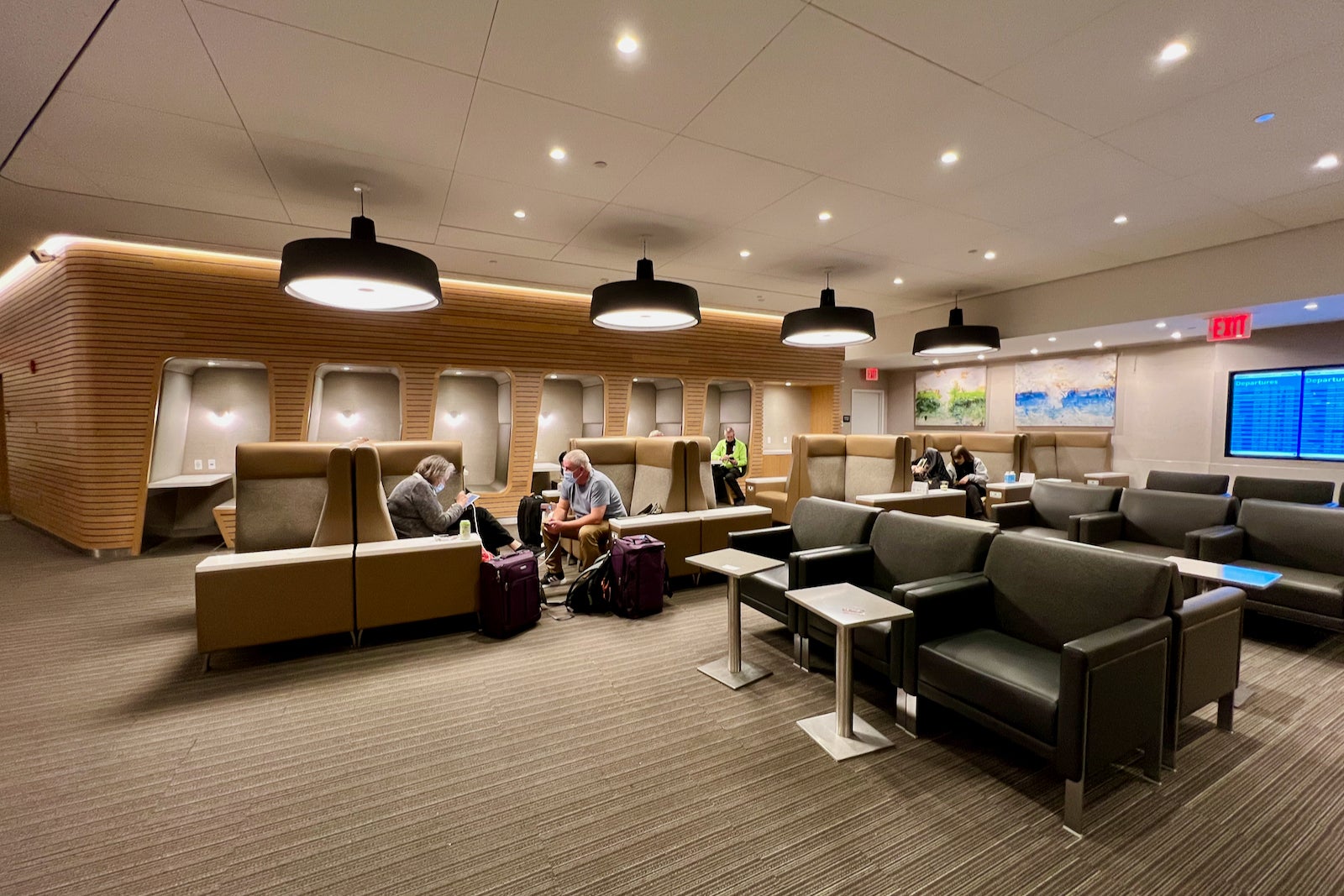
Waiters couldn’t keep up with the mess created by all those travelers, and the few empty seats and tables remained dirty for quite some time.
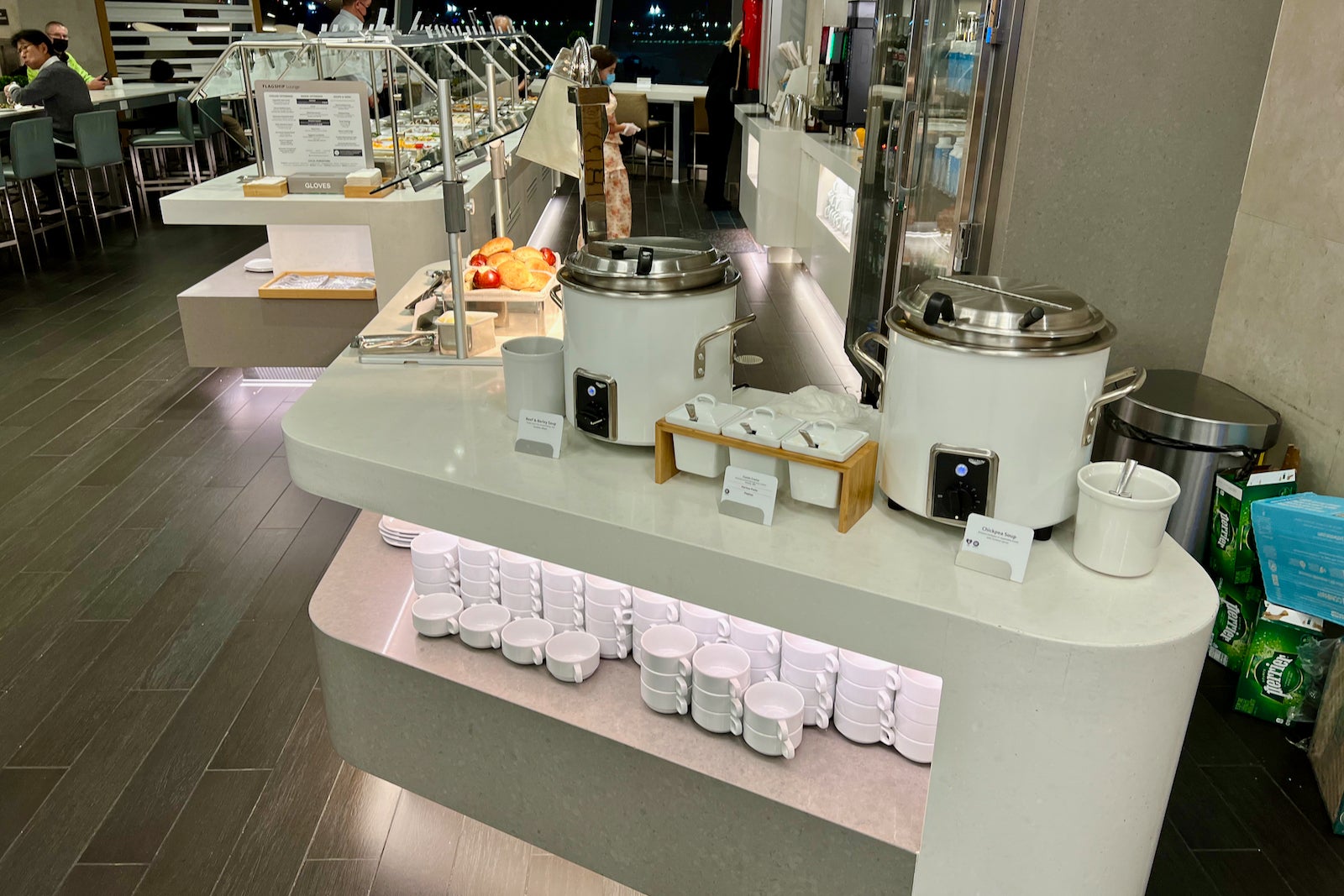
Even the bathrooms were dirty.
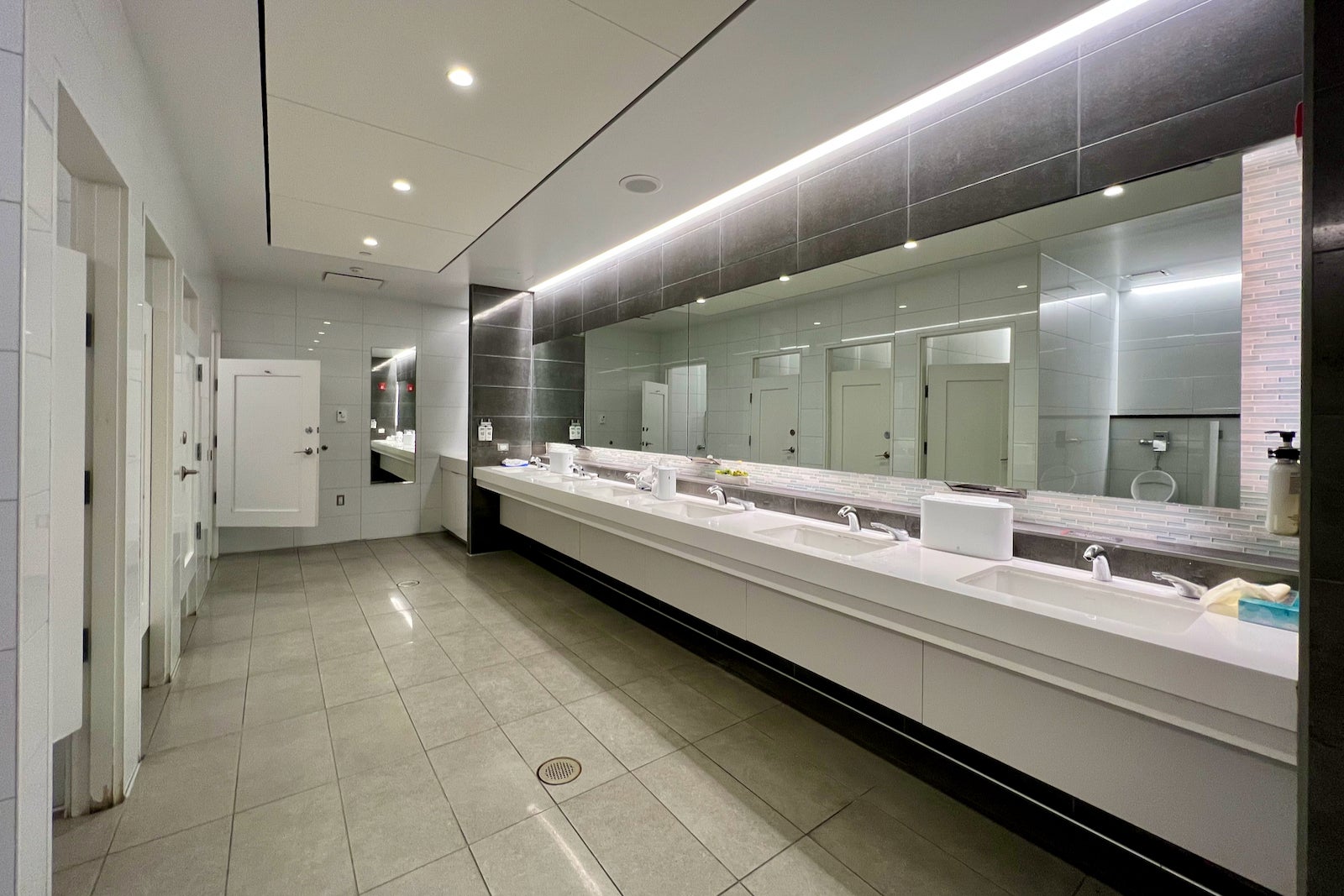
Take a look at my photos during my recent media tour to get a better sense of what the Flagship Lounge looks like without any passengers inside.
I managed to find the only empty area — the quiet zone — and I enjoyed a few bites of food there.
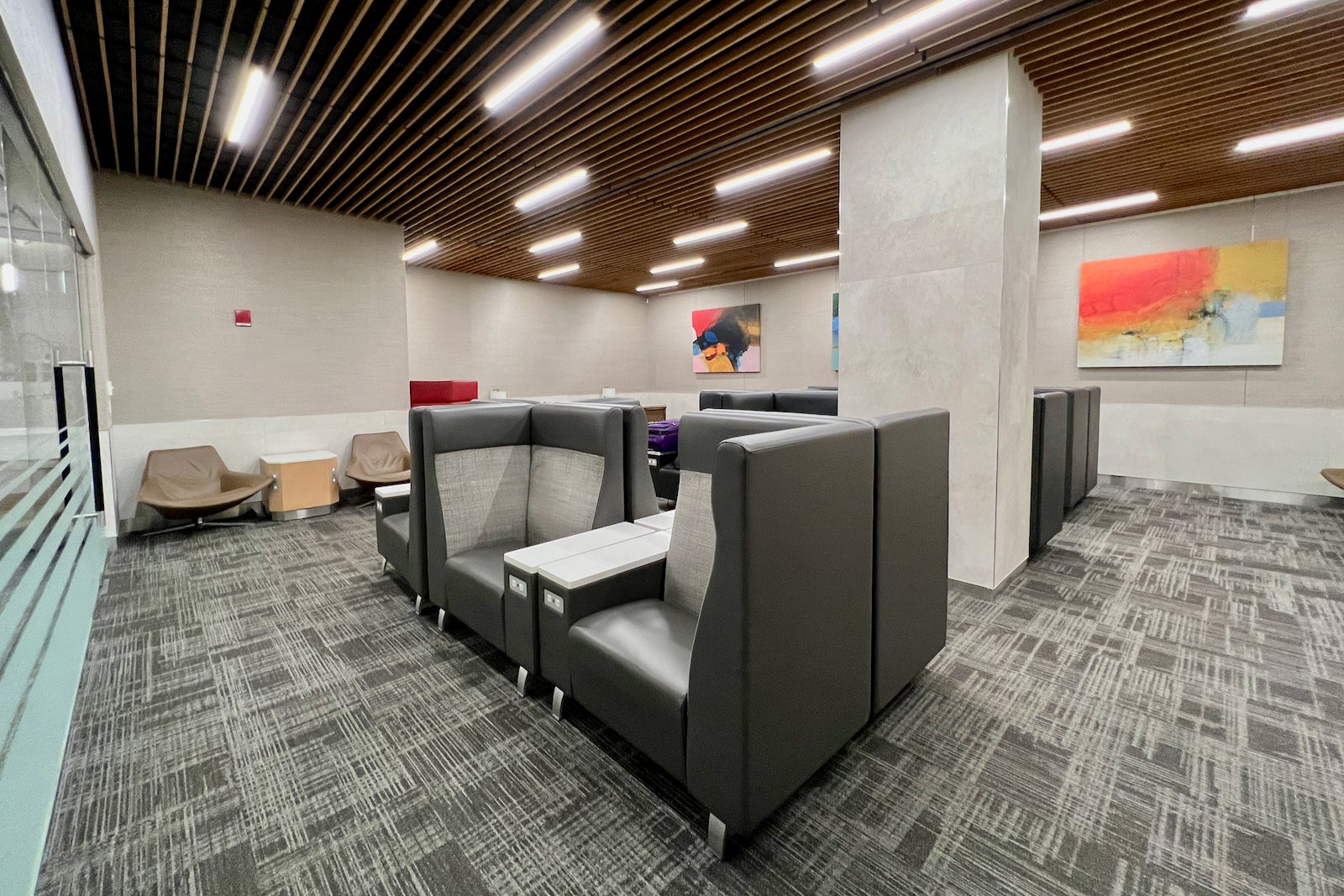
The buffet had a large menu card on either end, with allergen information for those with dietary sensitivities.
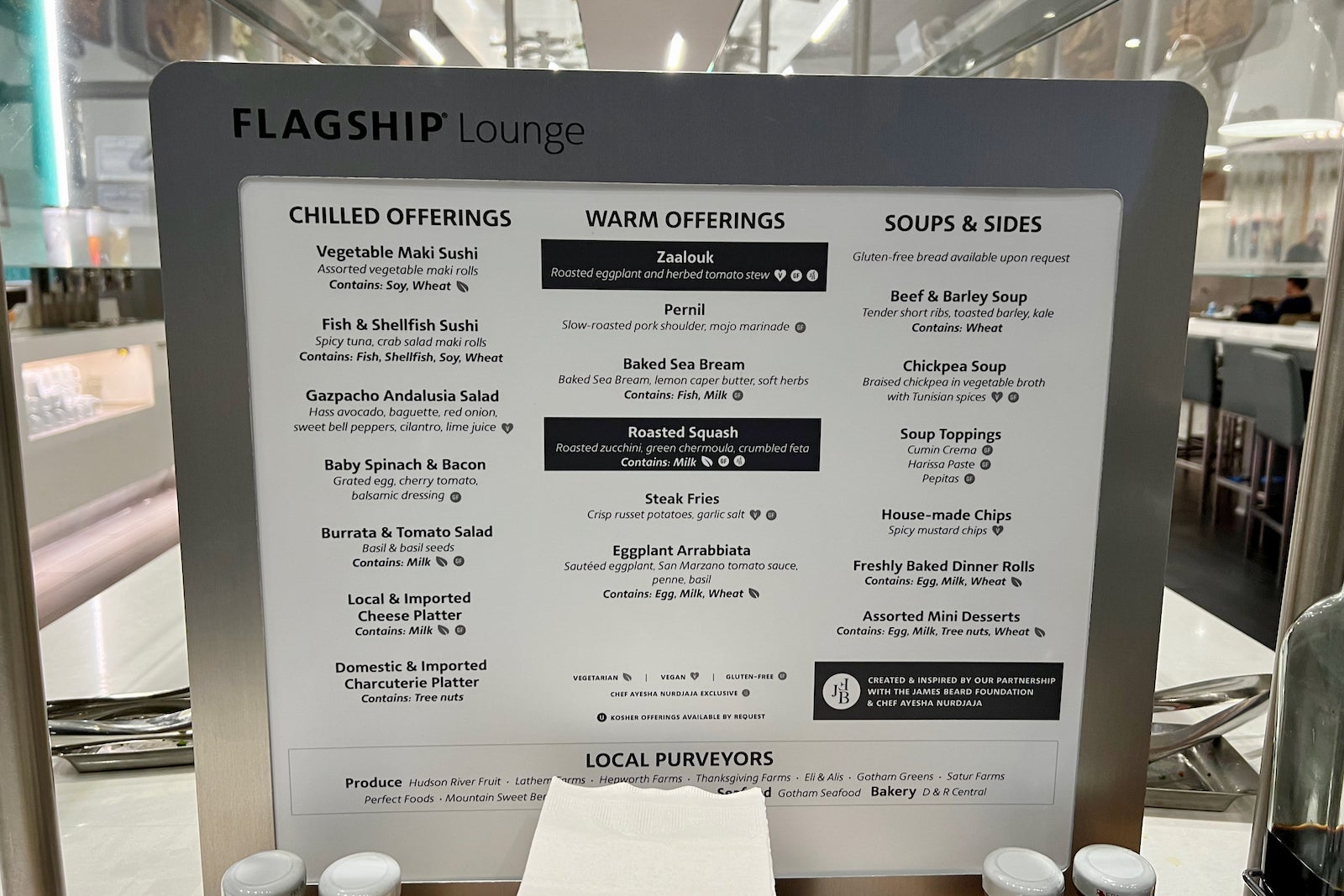
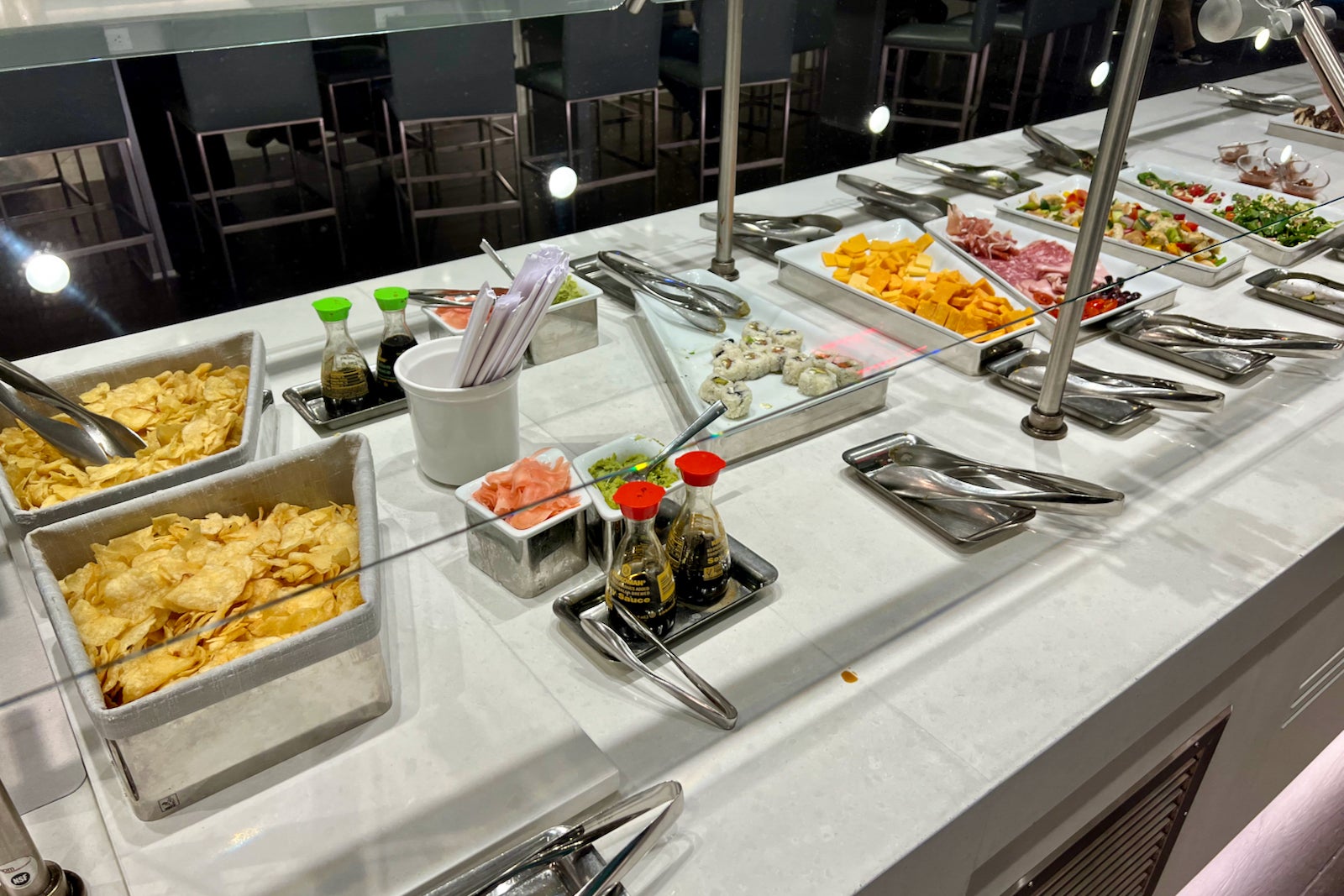
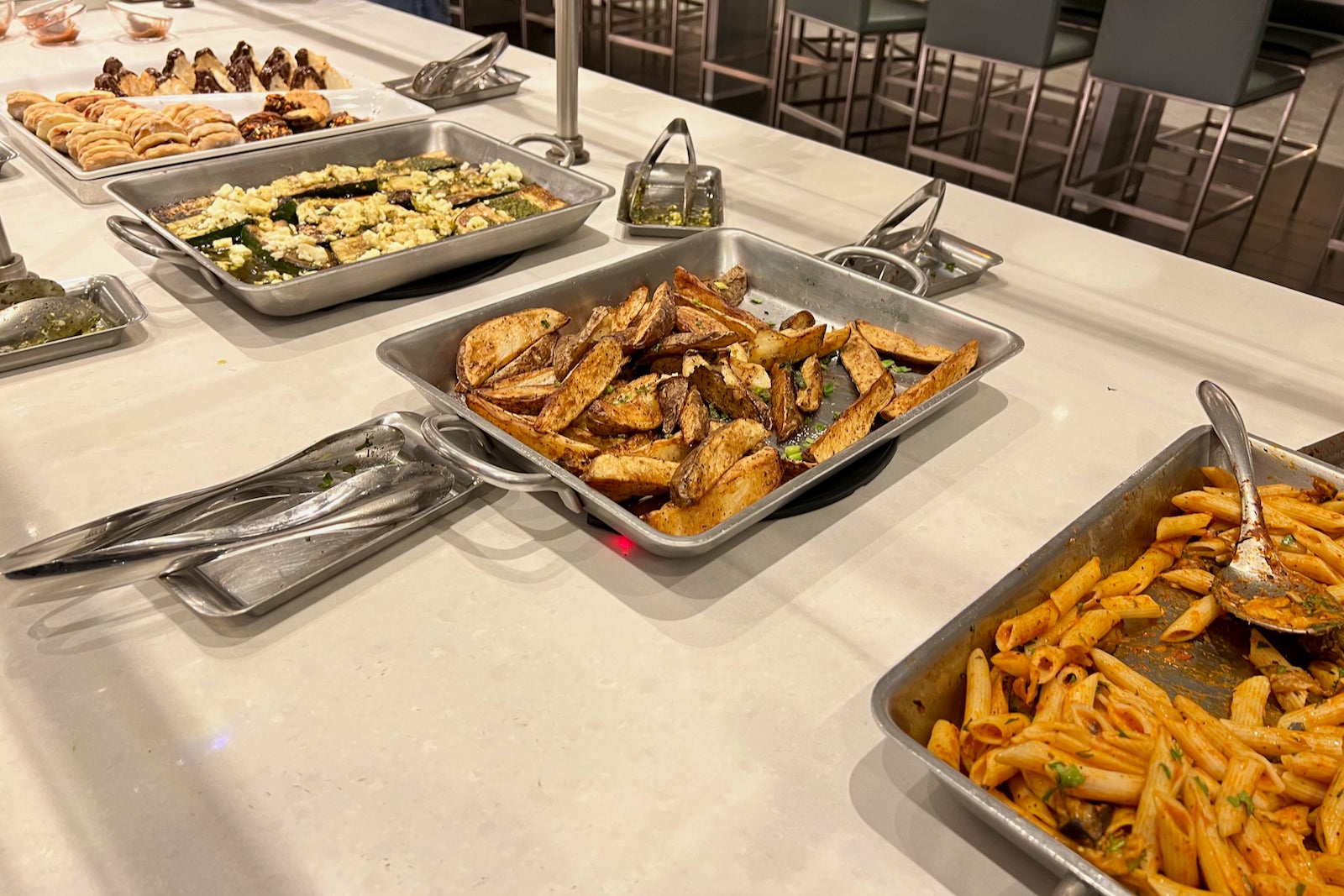
The food itself was delicious, even though the display wasn’t particularly polished.
I enjoyed a chickpea soup and a roasted squash entree, one of the lounge’s signature dishes in partnership with Chef Ayesha Nurdjaja, who’s at the helm of New York City’s popular Shuka and Shukette restaurants.
Drinks were self-serve from the walk-up bar. The Coca-Cola Freestyle machine was out of order, but there were plenty of canned beverages in the fridges, including a range of Coke-branded products, boxed Just Water and sparkling Perrier water.
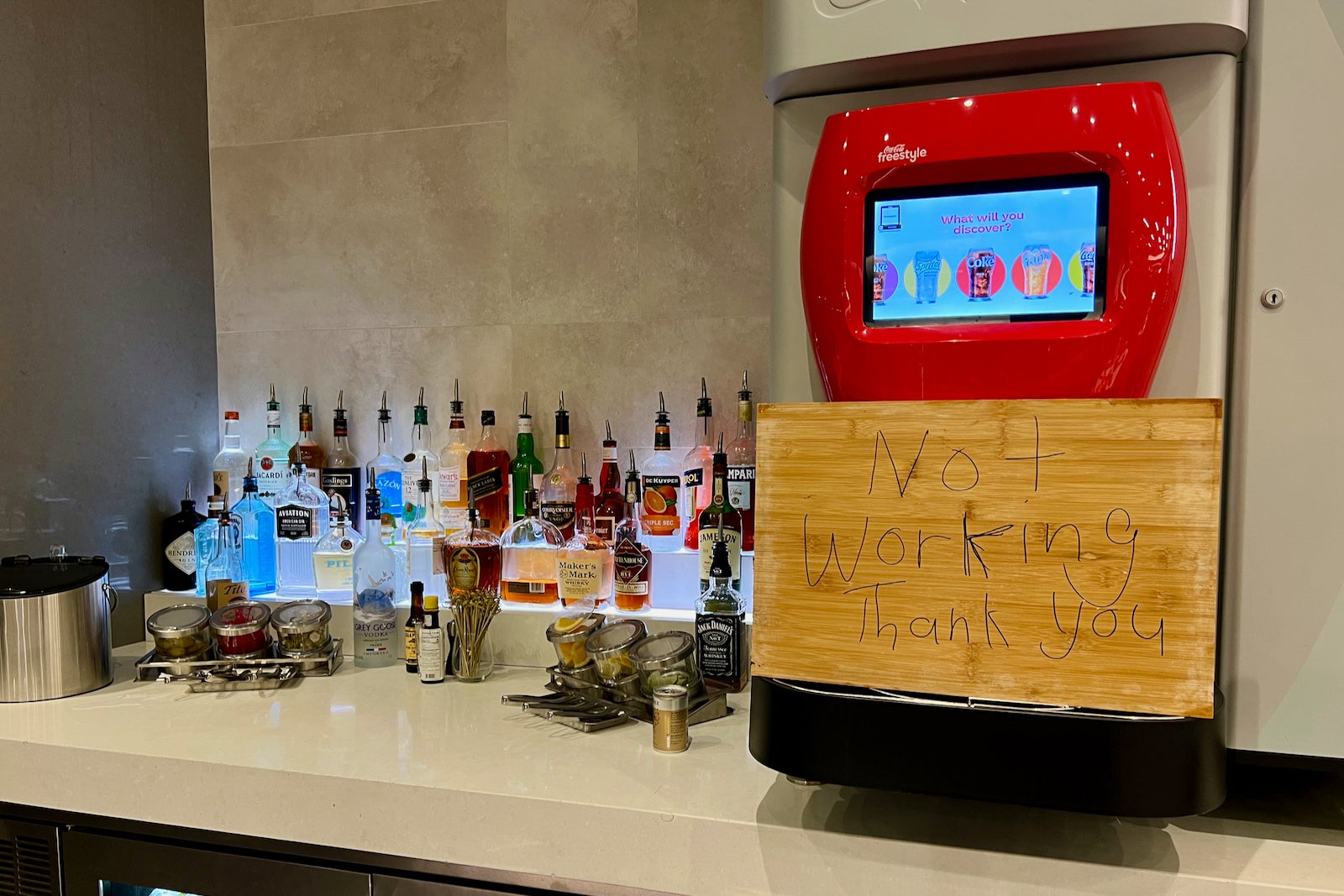
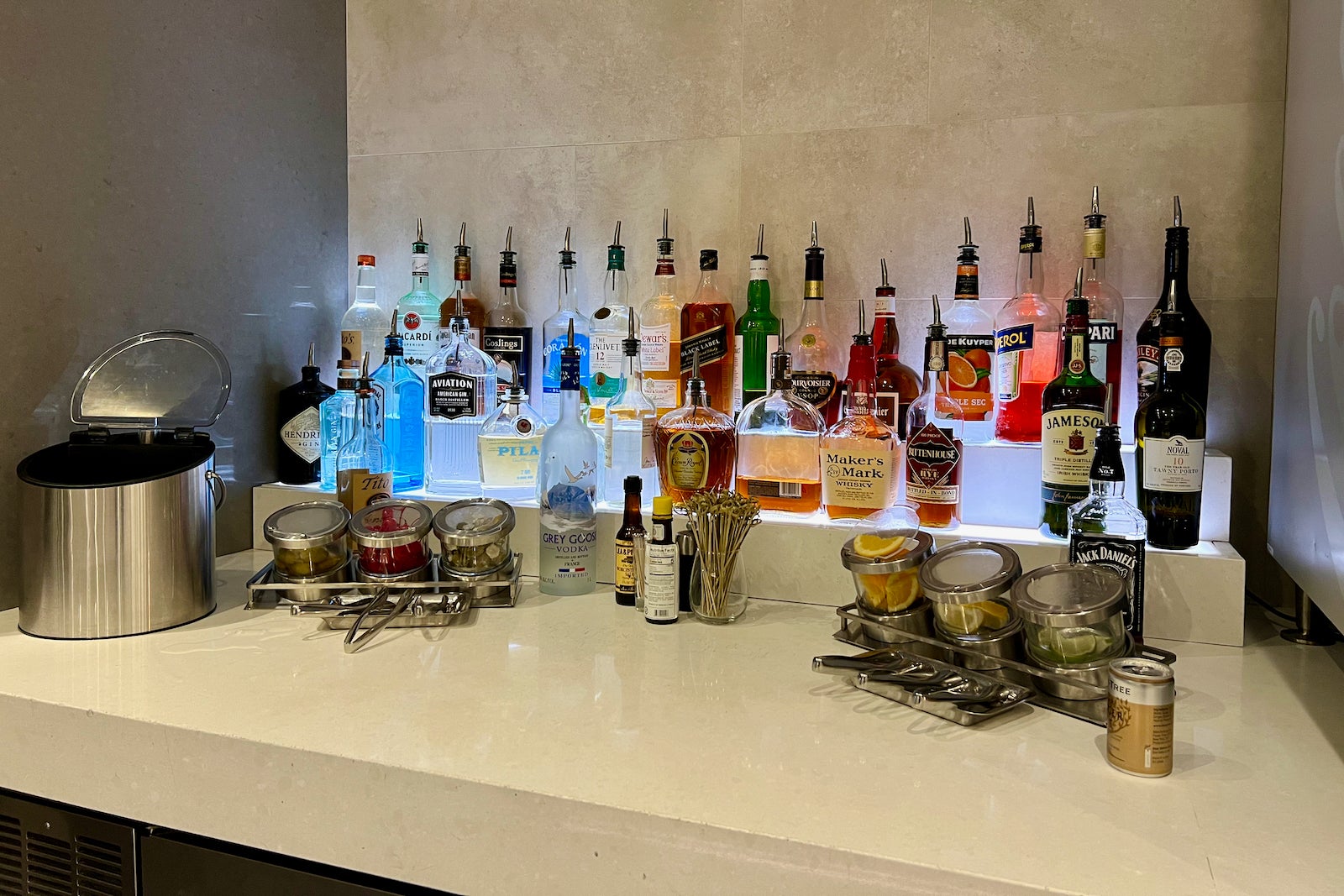
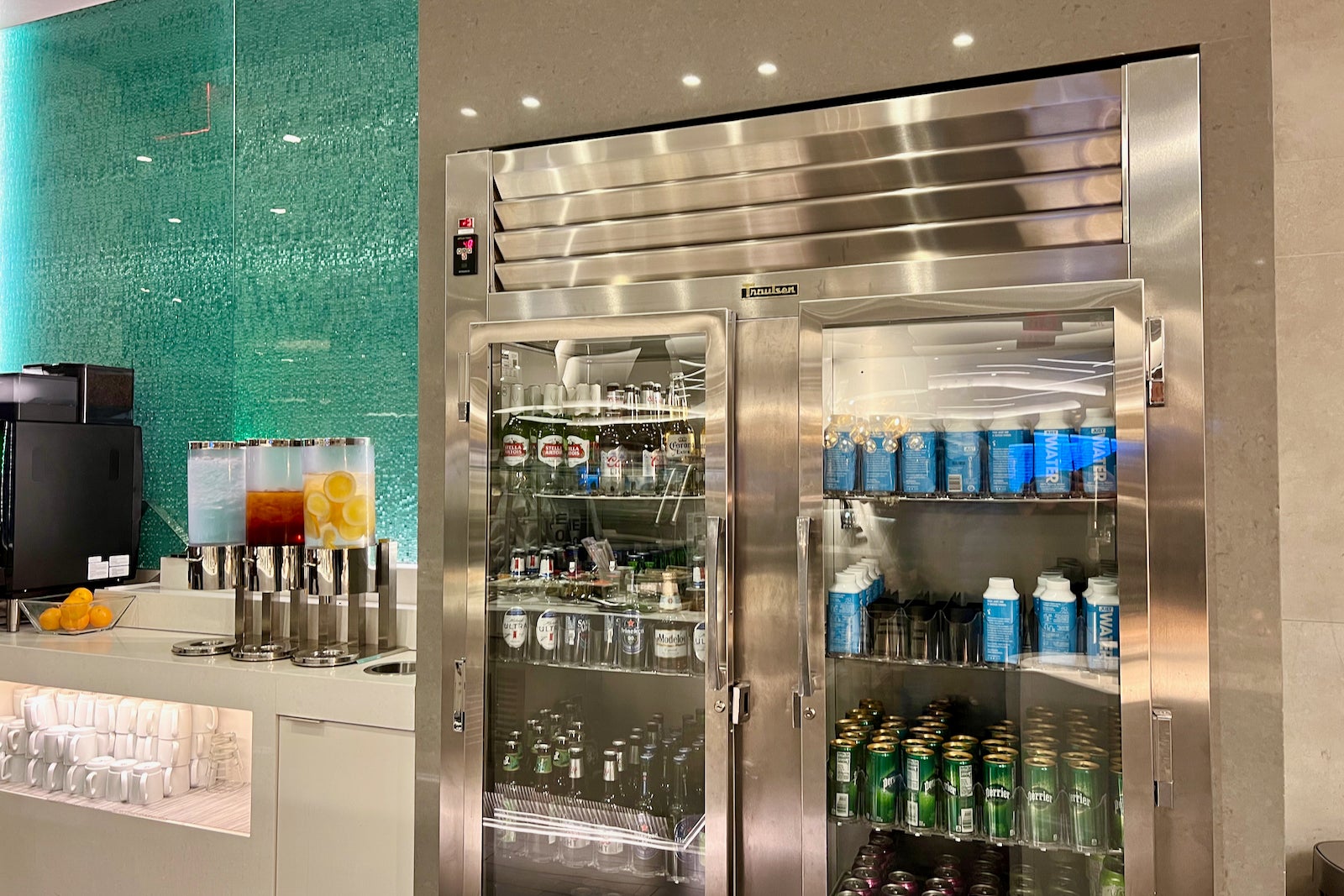
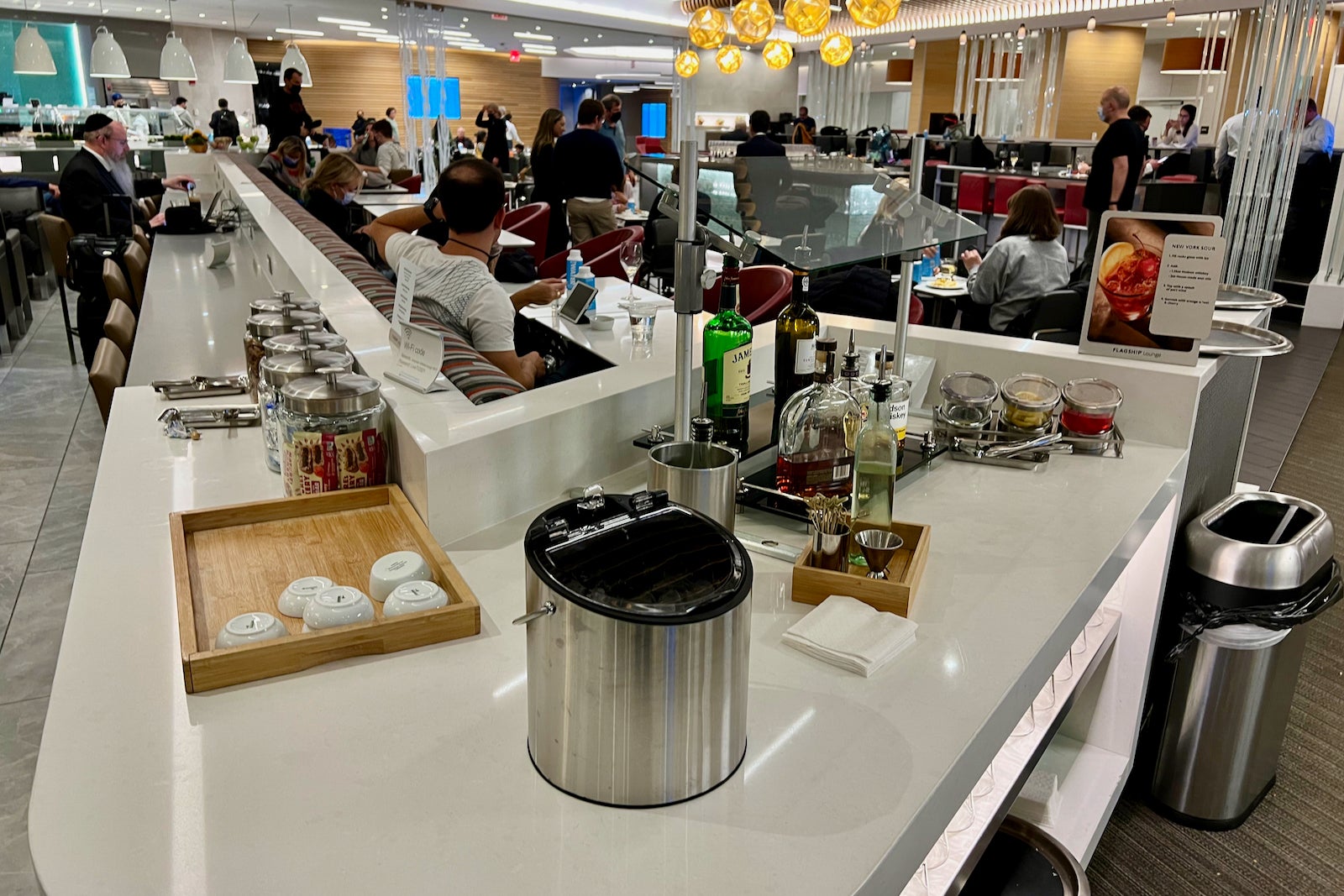
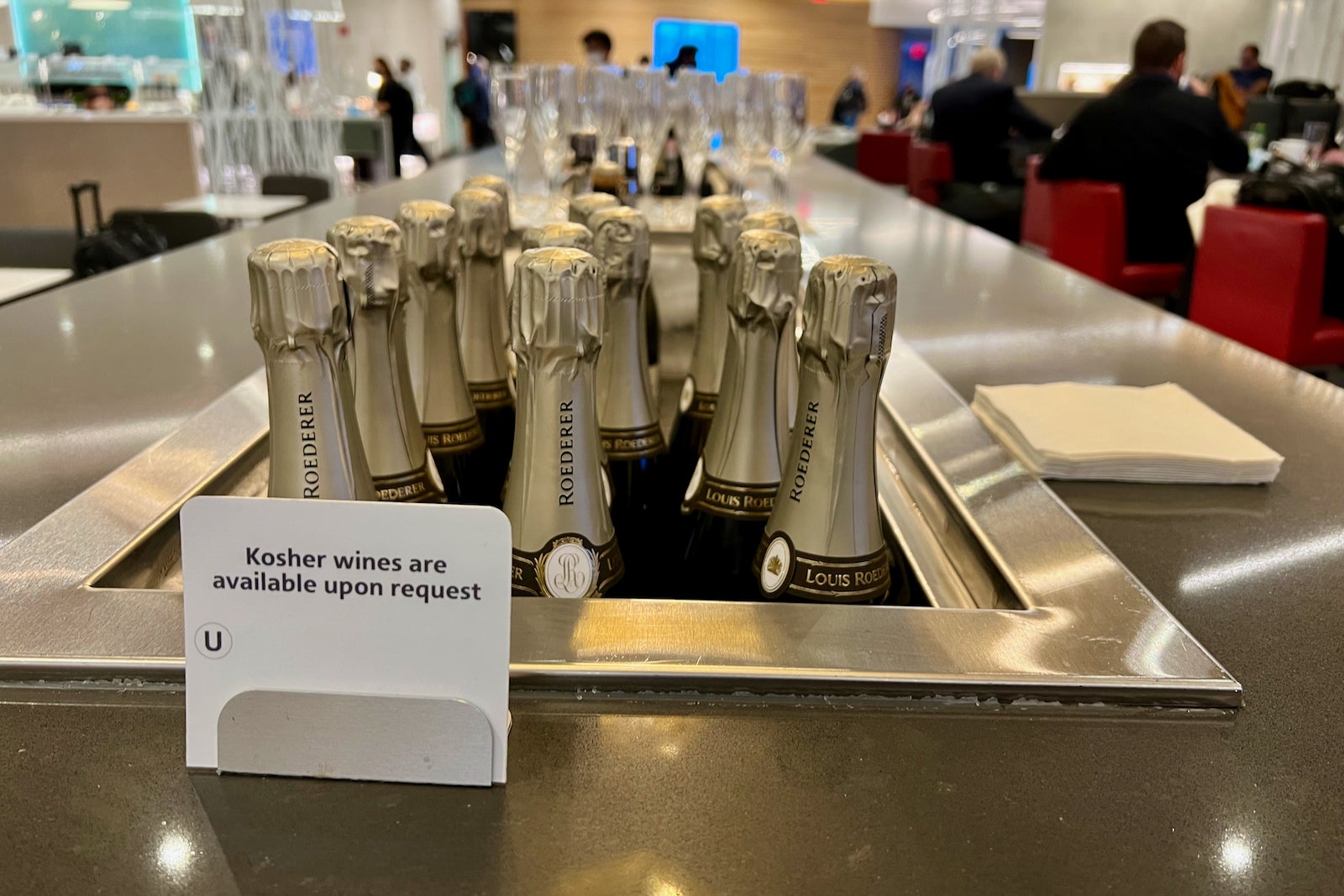
For those who abide by Kosher dietary laws, there were two microwavable meals available upon request — vegan stuffed peppers or baked lemon herb fish — as well as Koshers wines.

The Flagship Lounge offers shower suites on a first-come, first-serve basis. They’re stocked with D.S. & Durga products, as well as top-notch Dyson hair dryers.
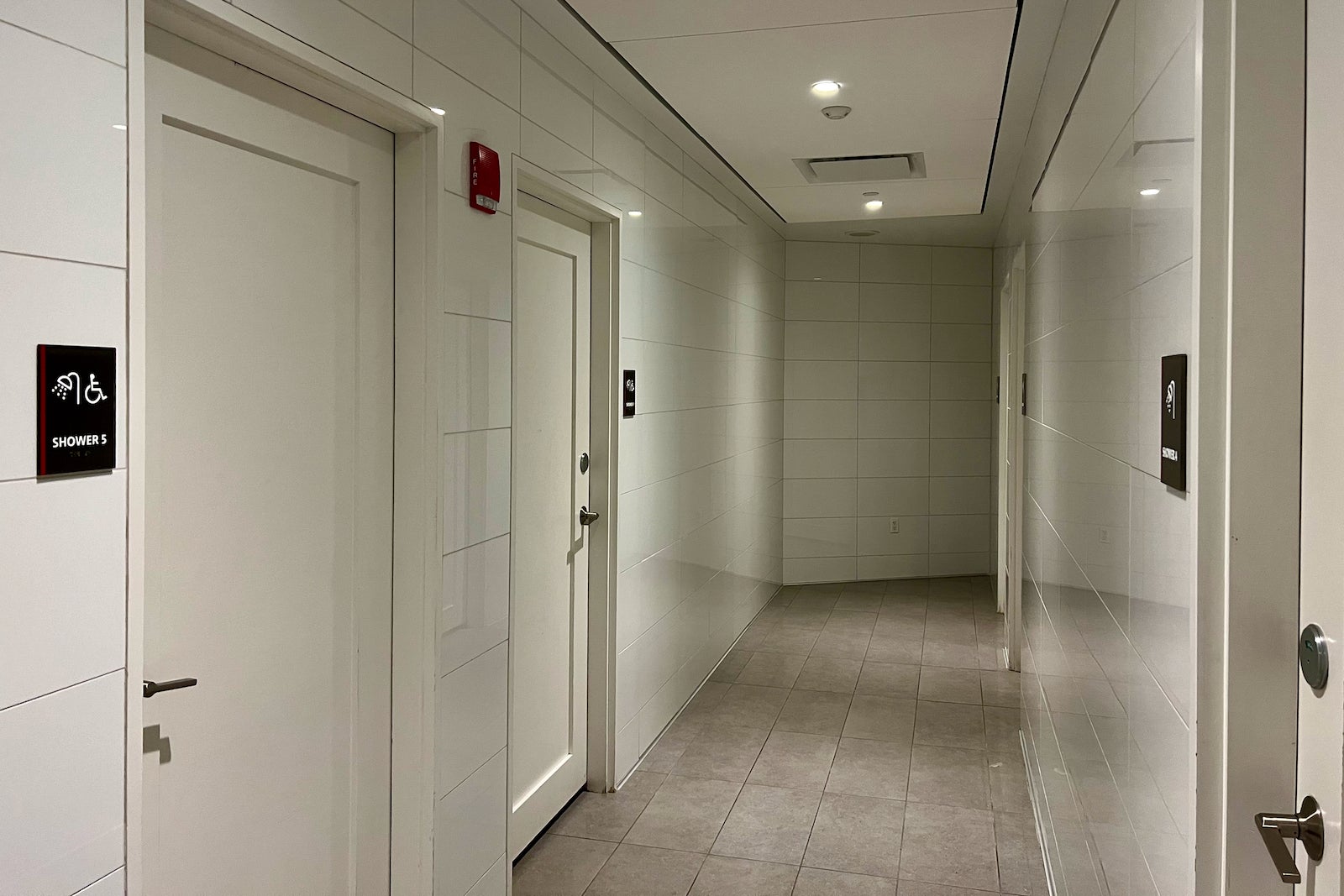
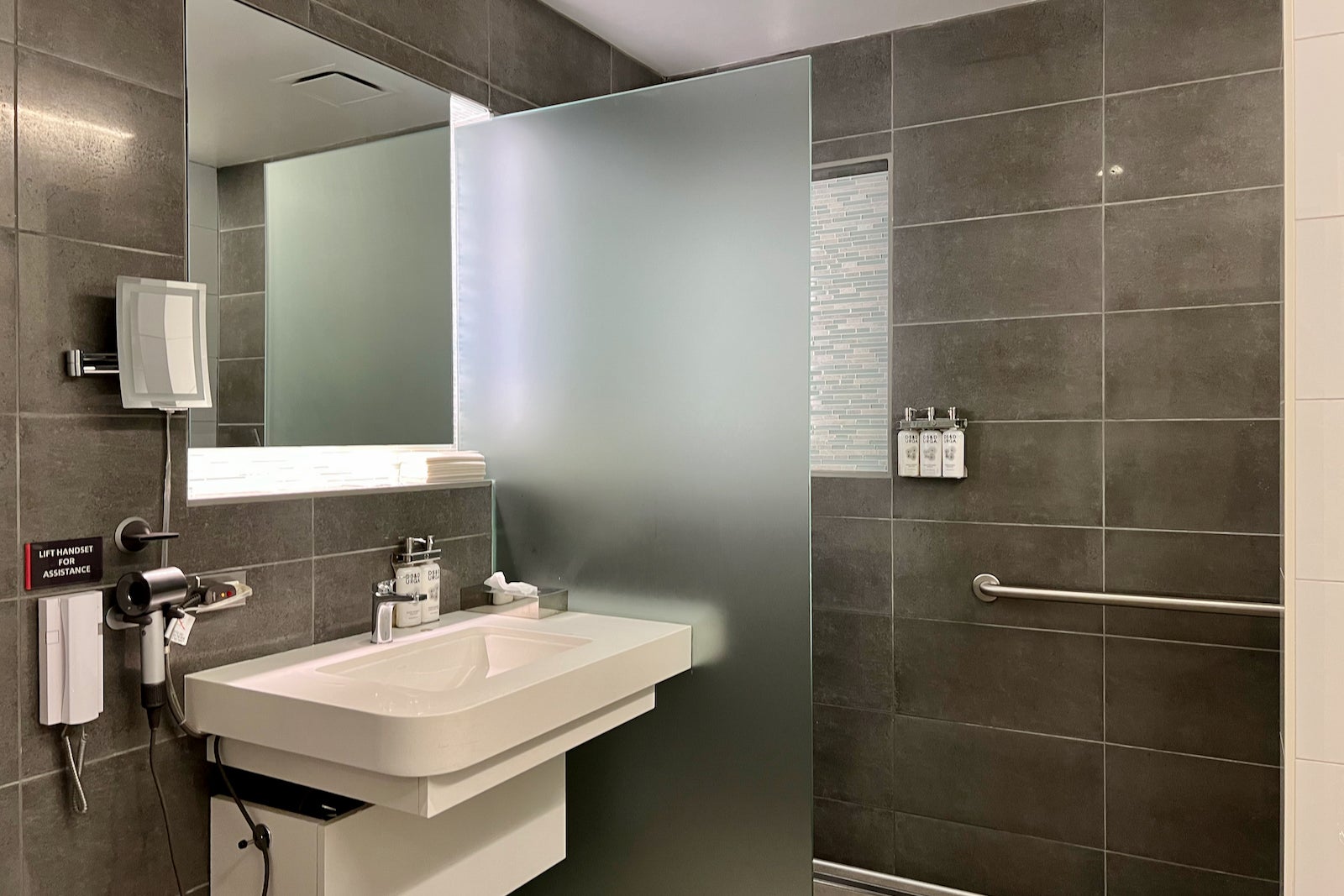
I spent about 30 minutes in the Flagship Lounge (which is open until 11:15 p.m., just 10 minutes after the Tel Aviv flight starts boarding).
From there, I made my way to the satellite concourse, which is where you’ll find American’s dedicated Tel Aviv gate.
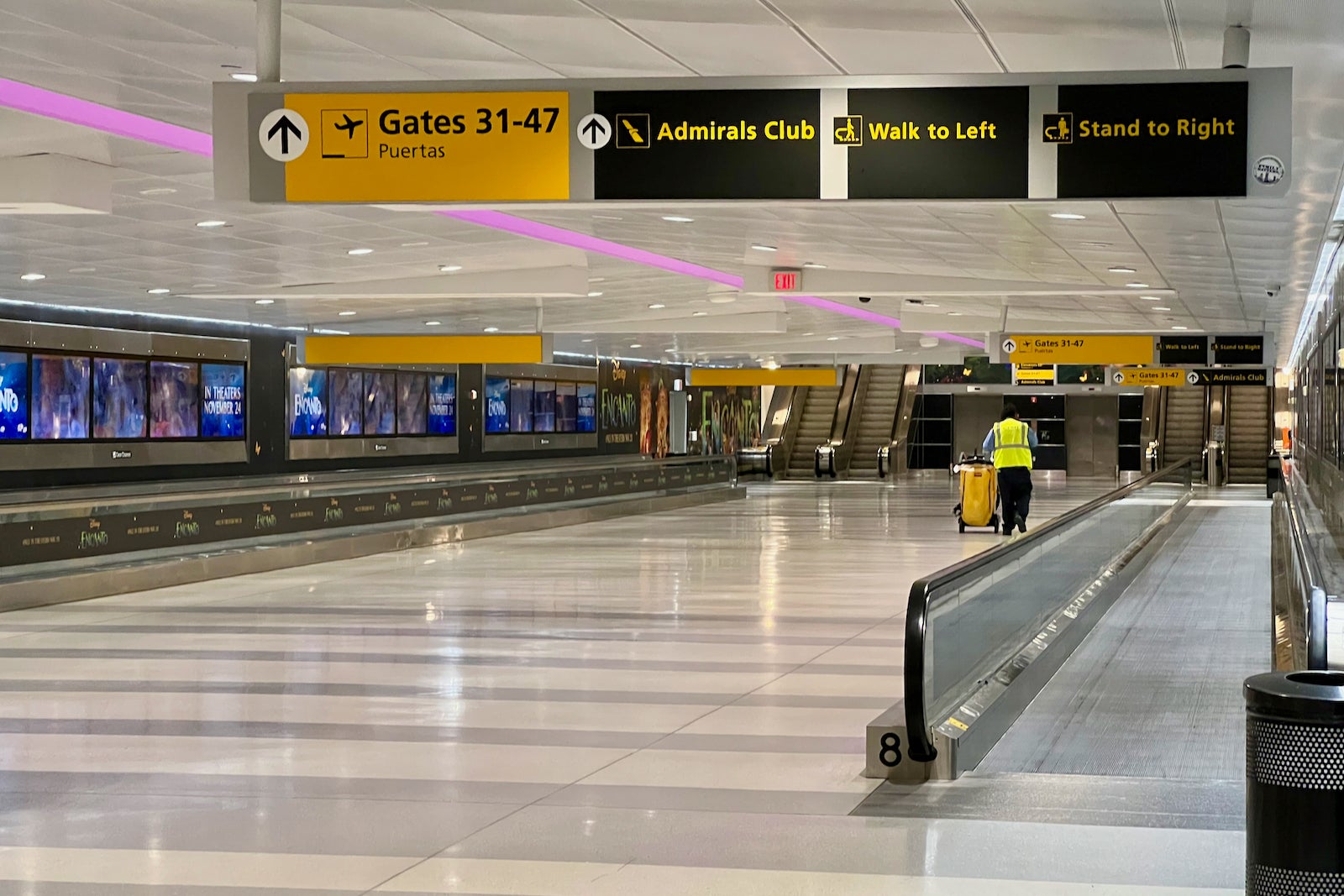
This required walking in the underground tunnel below the taxiway.
Once in the satellite terminal, I arrived at Gate 47, where I found a secondary security screening set up for the Israel flight. I was asked to present my passport and boarding pass and confirm my name. Some passengers were then instructed to proceed to an additional bag check, but I wasn’t selected as one of the lucky few.
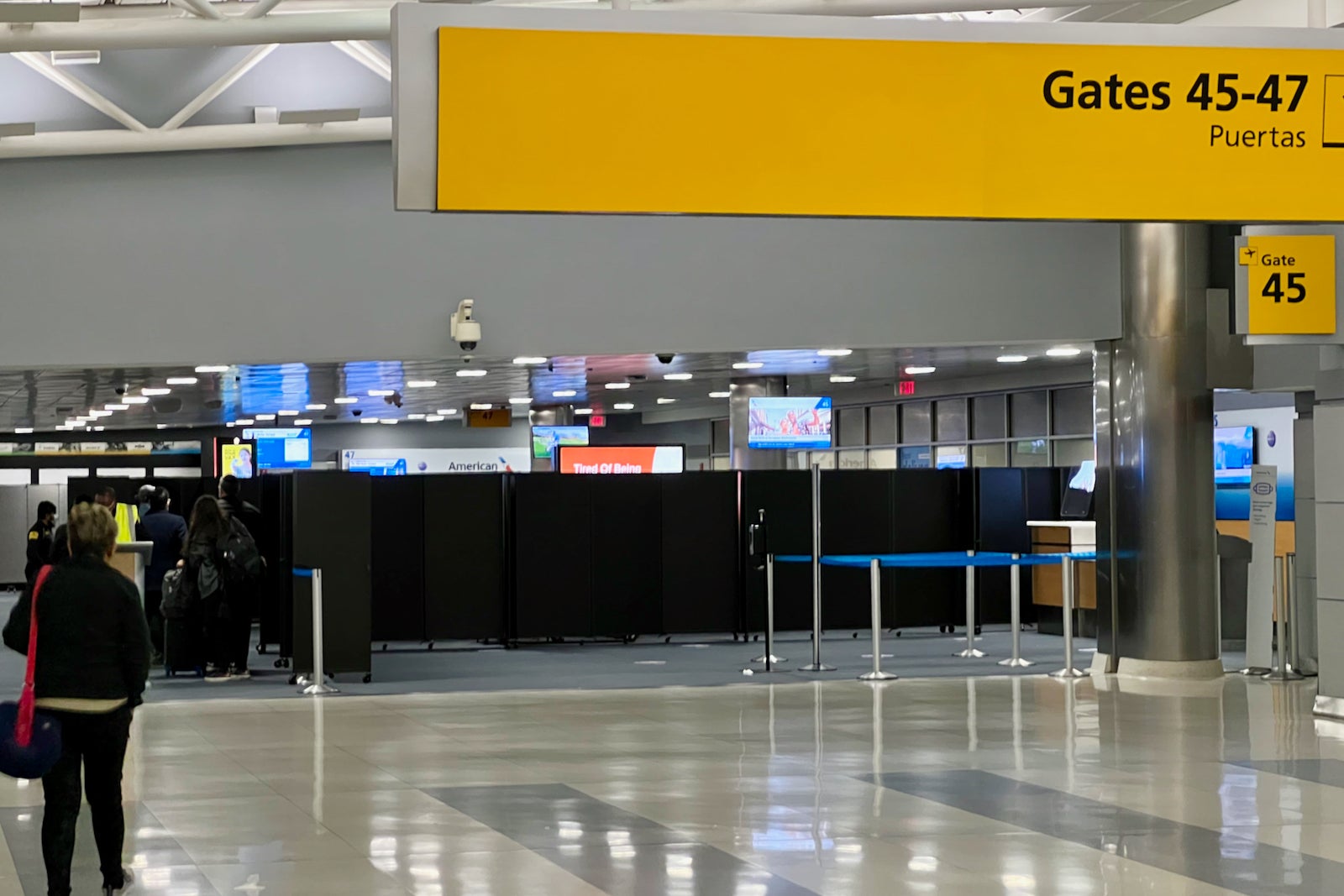
I waited patiently for boarding to begin. As departure grew closer, the gate area got progressively more crowded.
Lines started forming near the boarding doors, and when Group 1 boarding was called, I was one of the first on board.
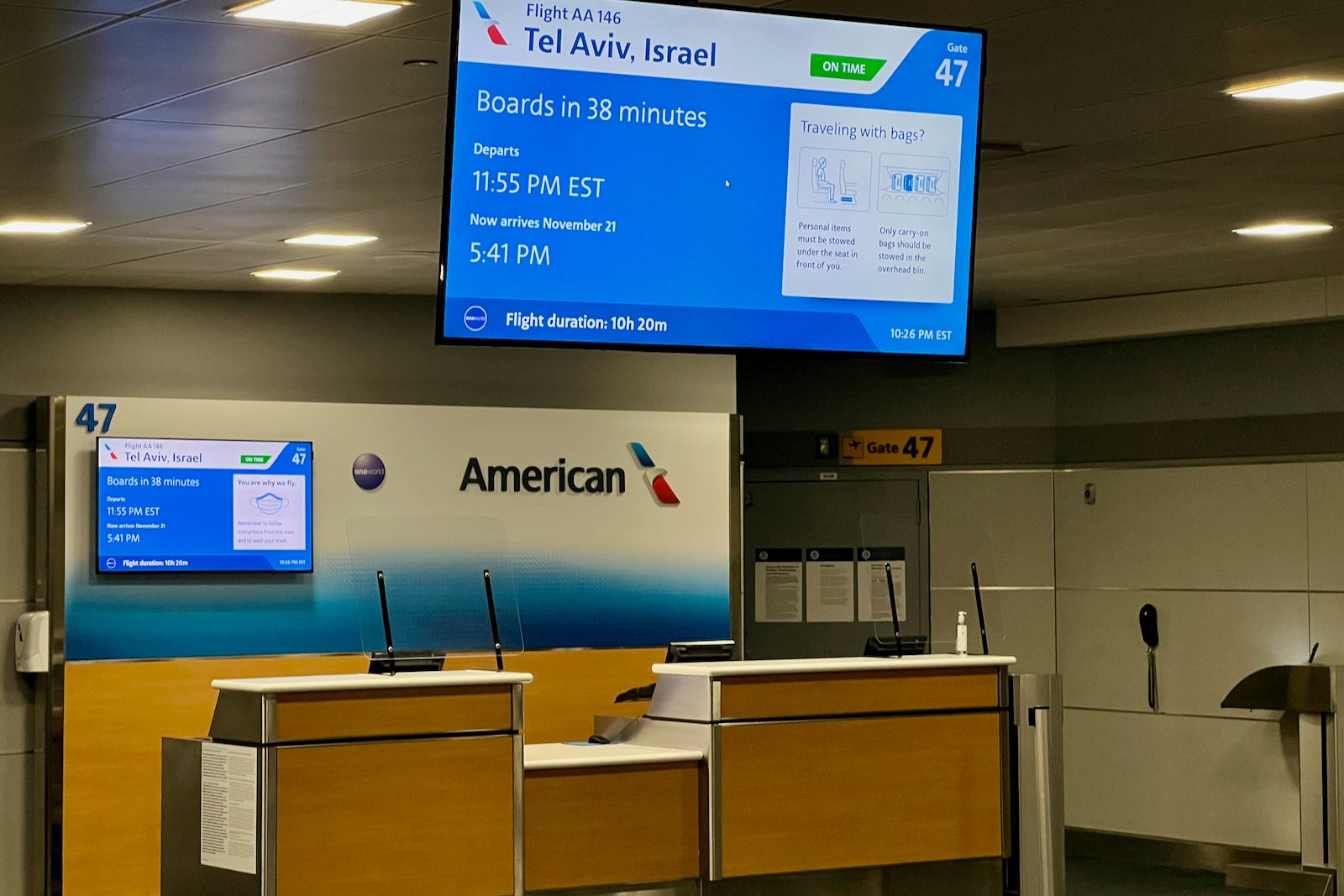
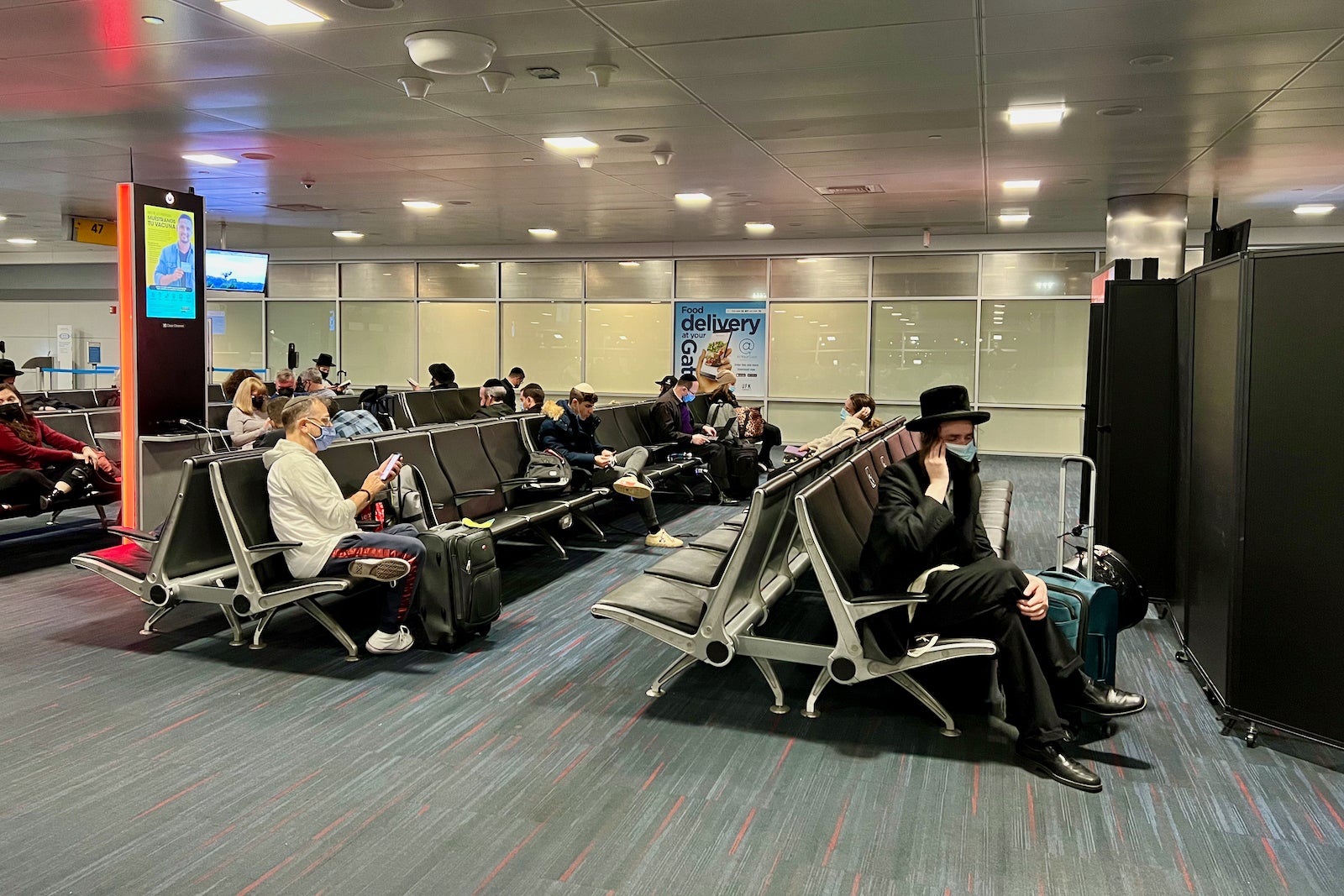

The boarding process began on time but was delayed moments later due to aircraft catering.
This short delay turned out to be great for me — I was one of the few who had already made it on board, and I managed to snag some empty cabin shots before others started passing by.
Cabin and seat
American’s New York to Tel Aviv flight is operated by a Boeing 777-200. American’s 777-200s are outfitted with one of two business-class products: either the alternating forward- and rear-facing Safran Concept D, or the far superior Rockwell Collins Super Diamond product.
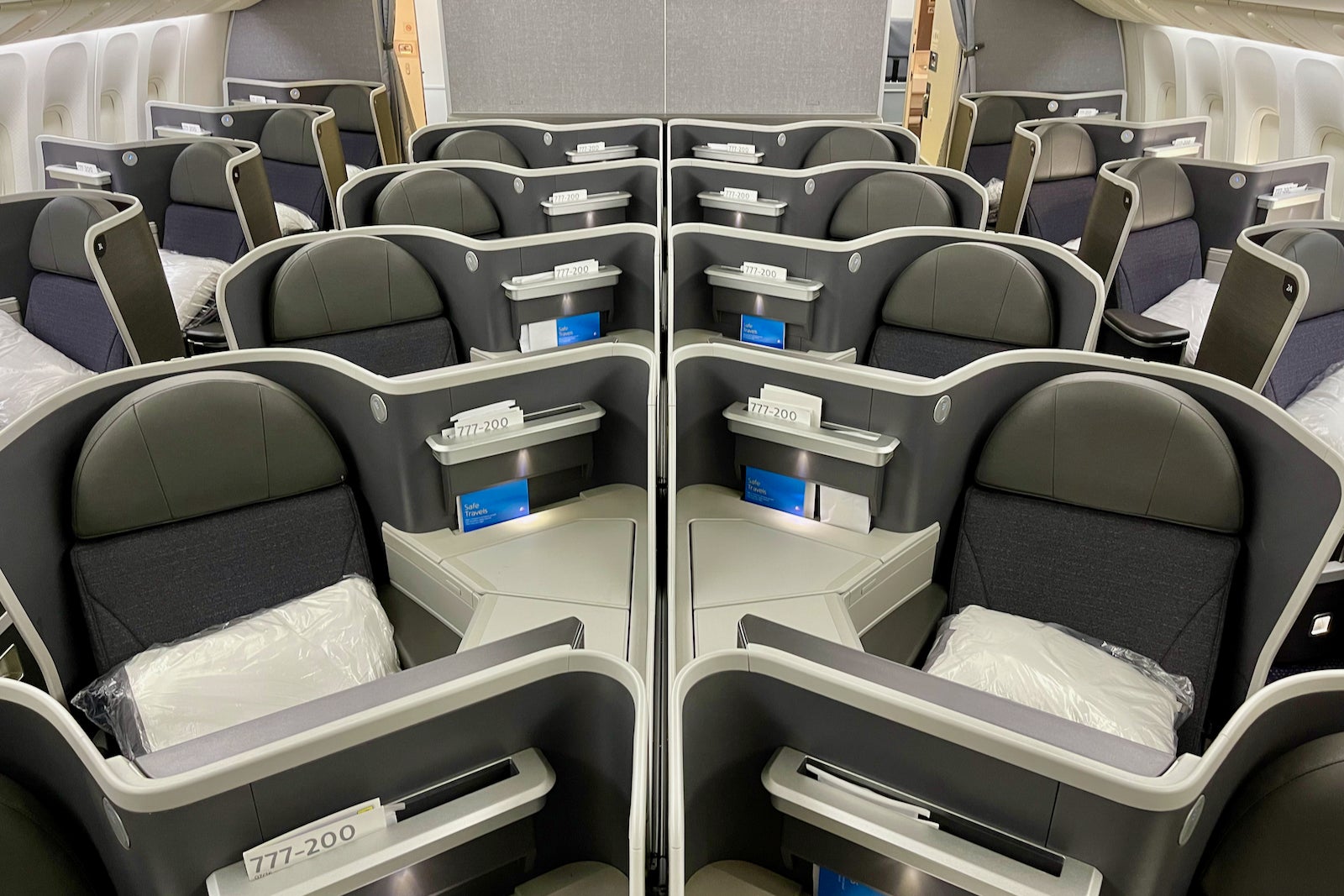
While they both offer lie-flat beds with direct aisle access, the Rockwell Collins reverse herringbone product is much better than the zig-zag-style Safran product.
Each row of Safran seats faces the one in front of or behind it, meaning that you’re going to be staring at your neighbor for most of the flight. Additionally, the seats are some of the narrowest business-class ones in the fleet. But perhaps the biggest drawback is the way the seats are designed. Each pair of forward- and rear-facing pods are attached to one another, and these connected seats are known to physically rock. So when your seatmate gets up, or even rolls over in lie-flat mode, you’re probably going to feel it.
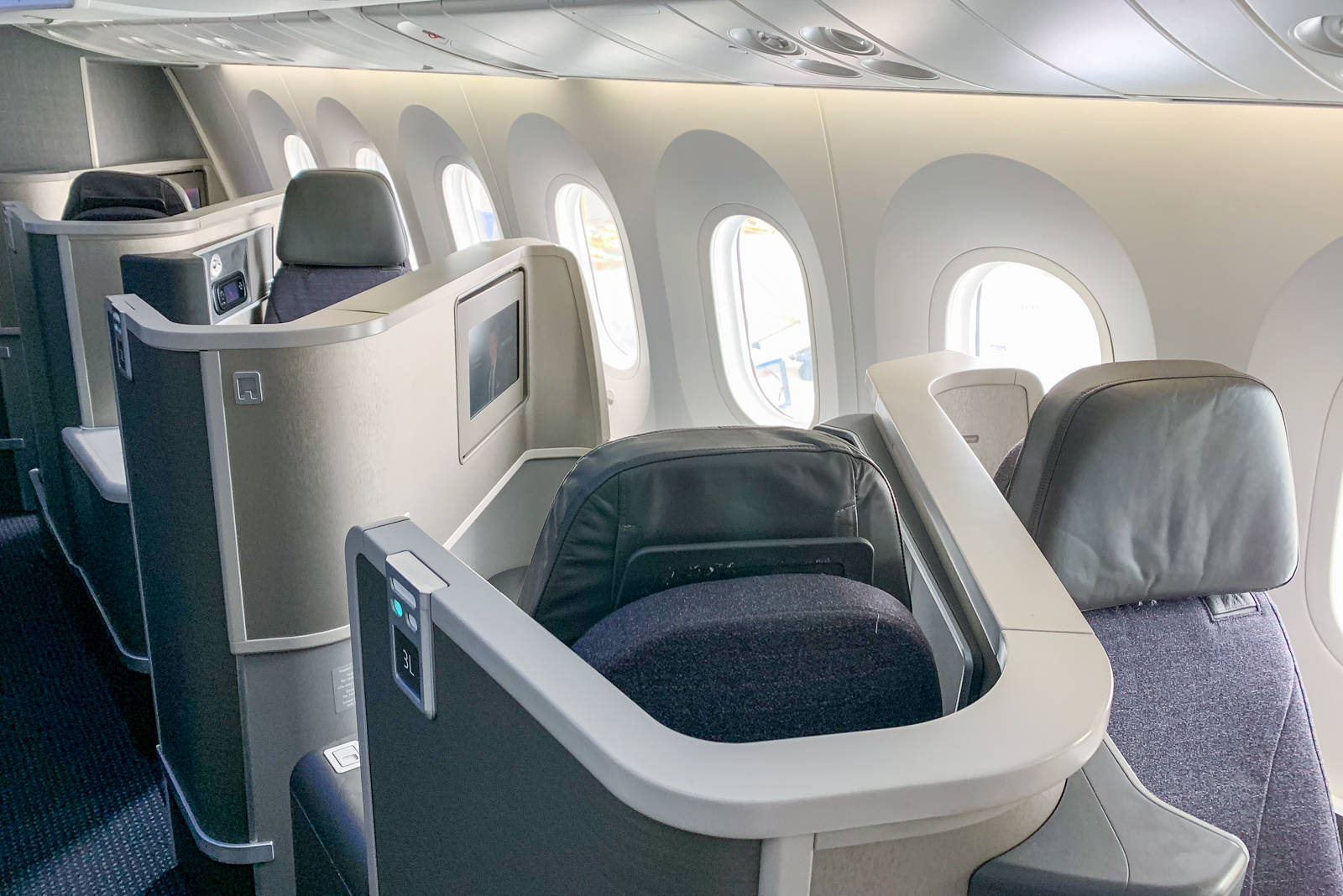
Unfortunately, there’s no easy way to know for sure which product you’ll receive until a specific plane is assigned to your route, roughly two days before departure. At that point, you can take a look at the online seat map for your flight and see if there are arrows on the open seats to indicate a rear-facing seat. Alternatively, you could track your flight using FlightRadar24 to pull up the aircraft registration and check the configuration on American’s unofficial fleet site.
On that Saturday night, I hit the jackpot, as our aircraft, N799AN, was one with the Rockwell Collins seats.
There are two business-class cabins on this jet, one that spans rows 1 through 6 and another, smaller cabin from rows 7 through 10.
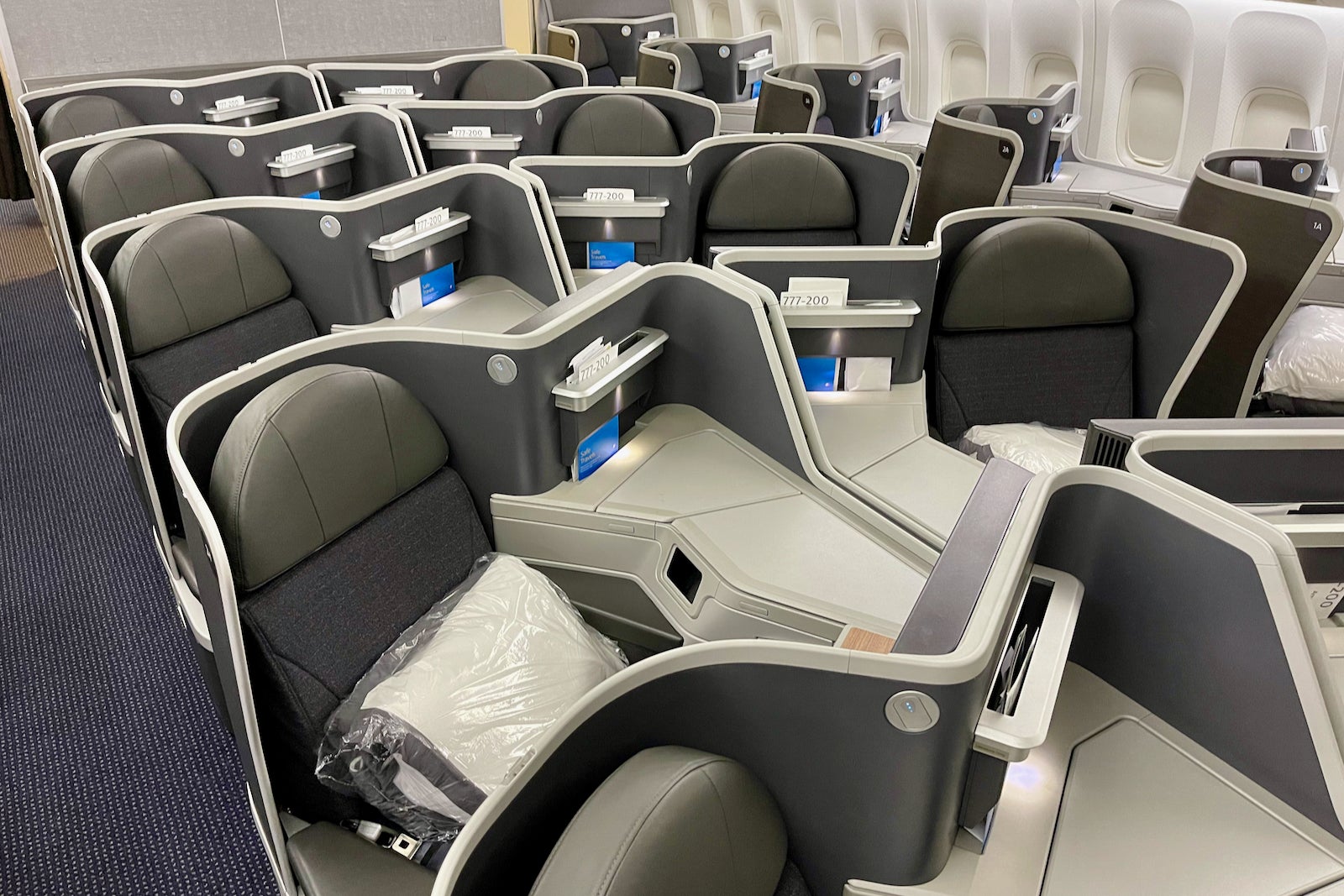
All pods are angled away from the aisle in a 1-2-1 configuration. There’s ample privacy for the window seats.
The seats themselves are supremely comfortable. I quickly settled into Seat 8L, a window pod on the starboard side of the plane in the mini-cabin.
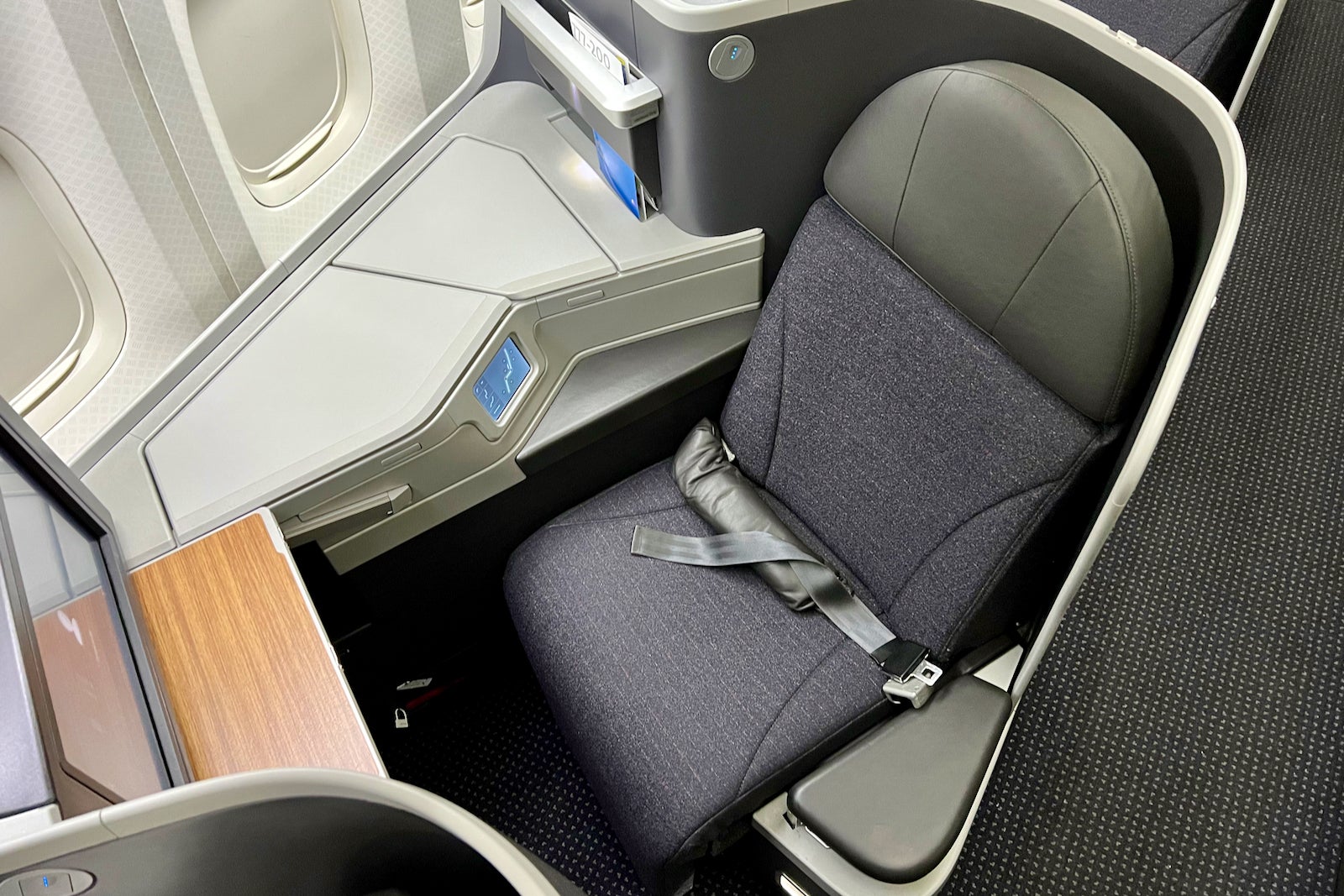
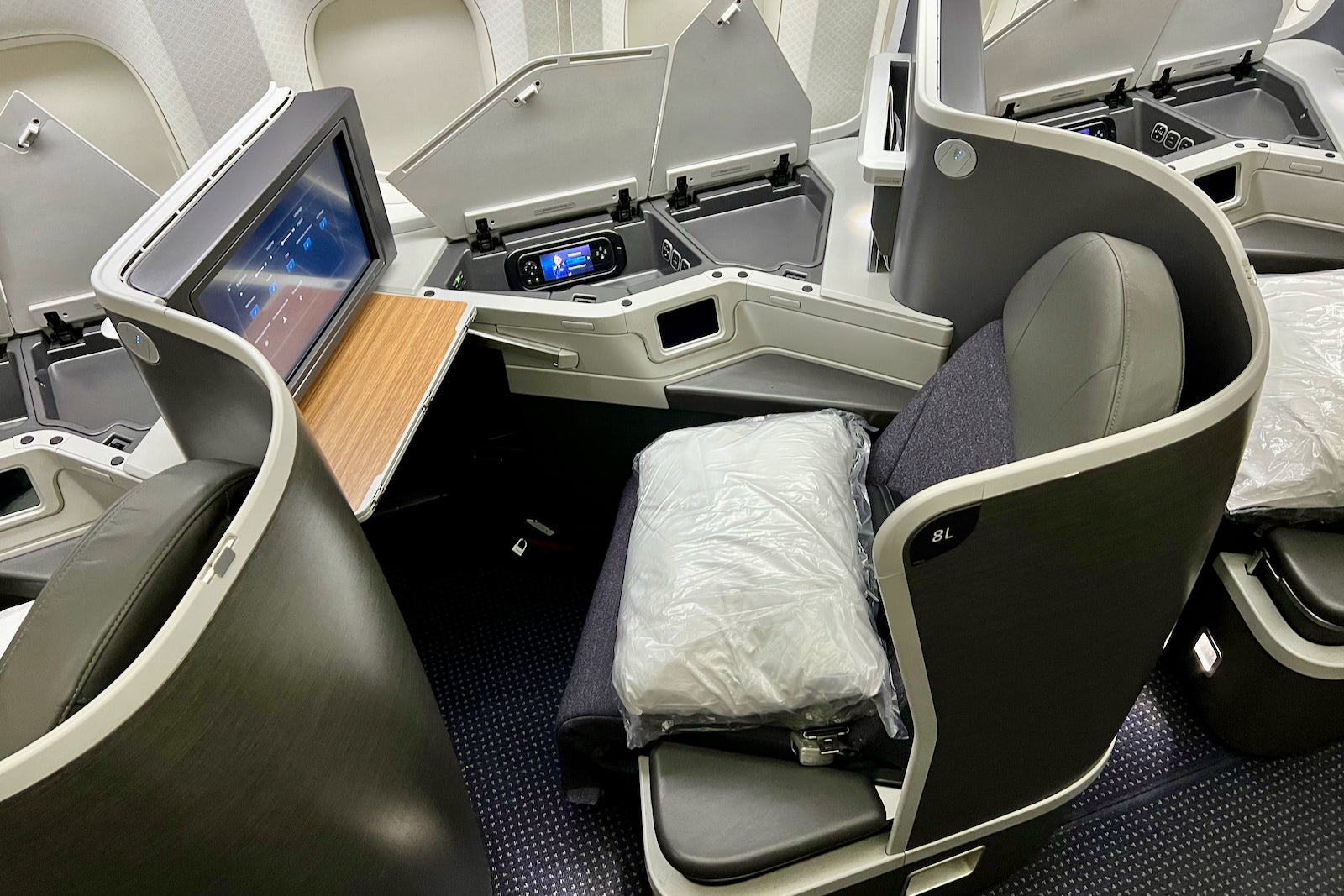
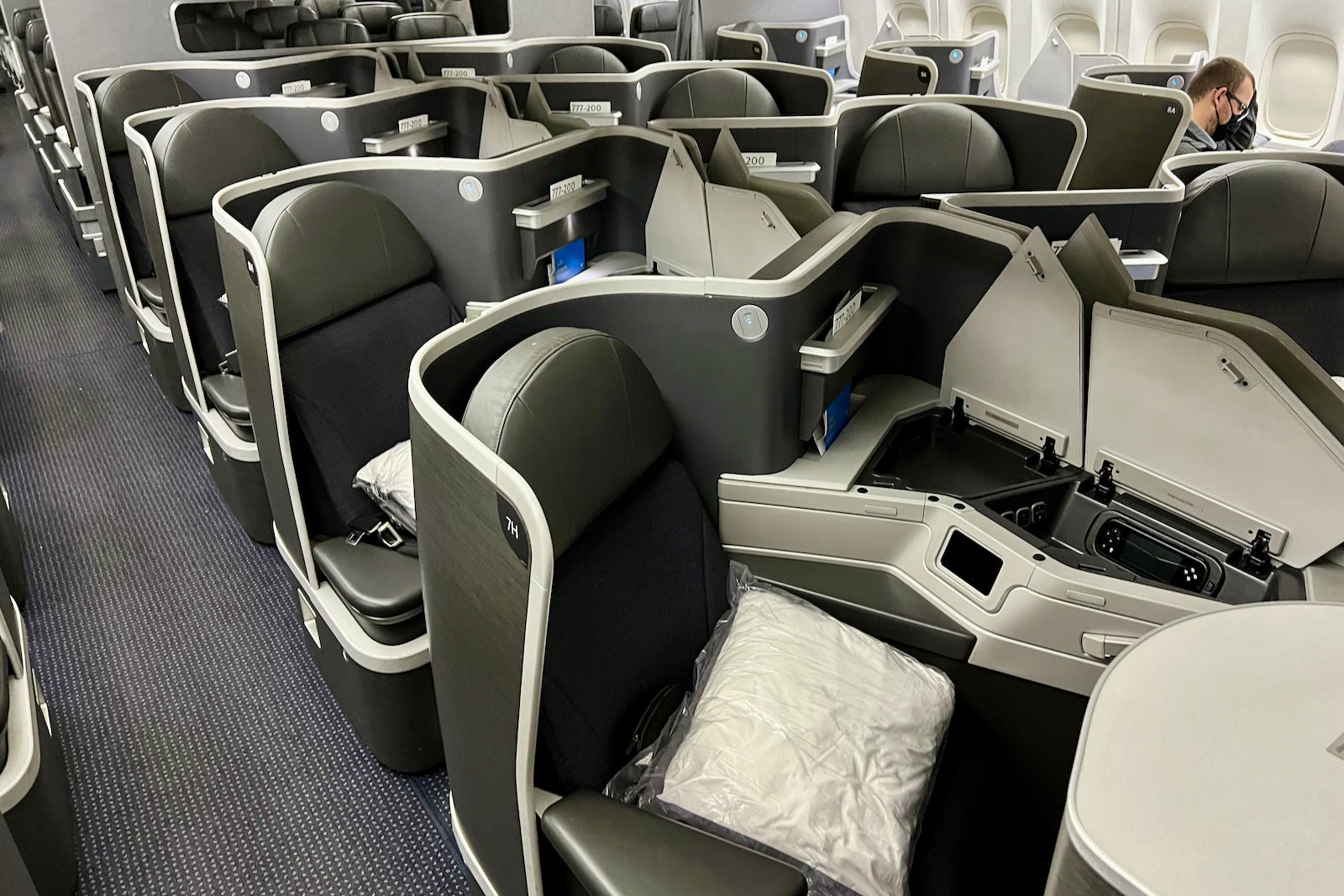
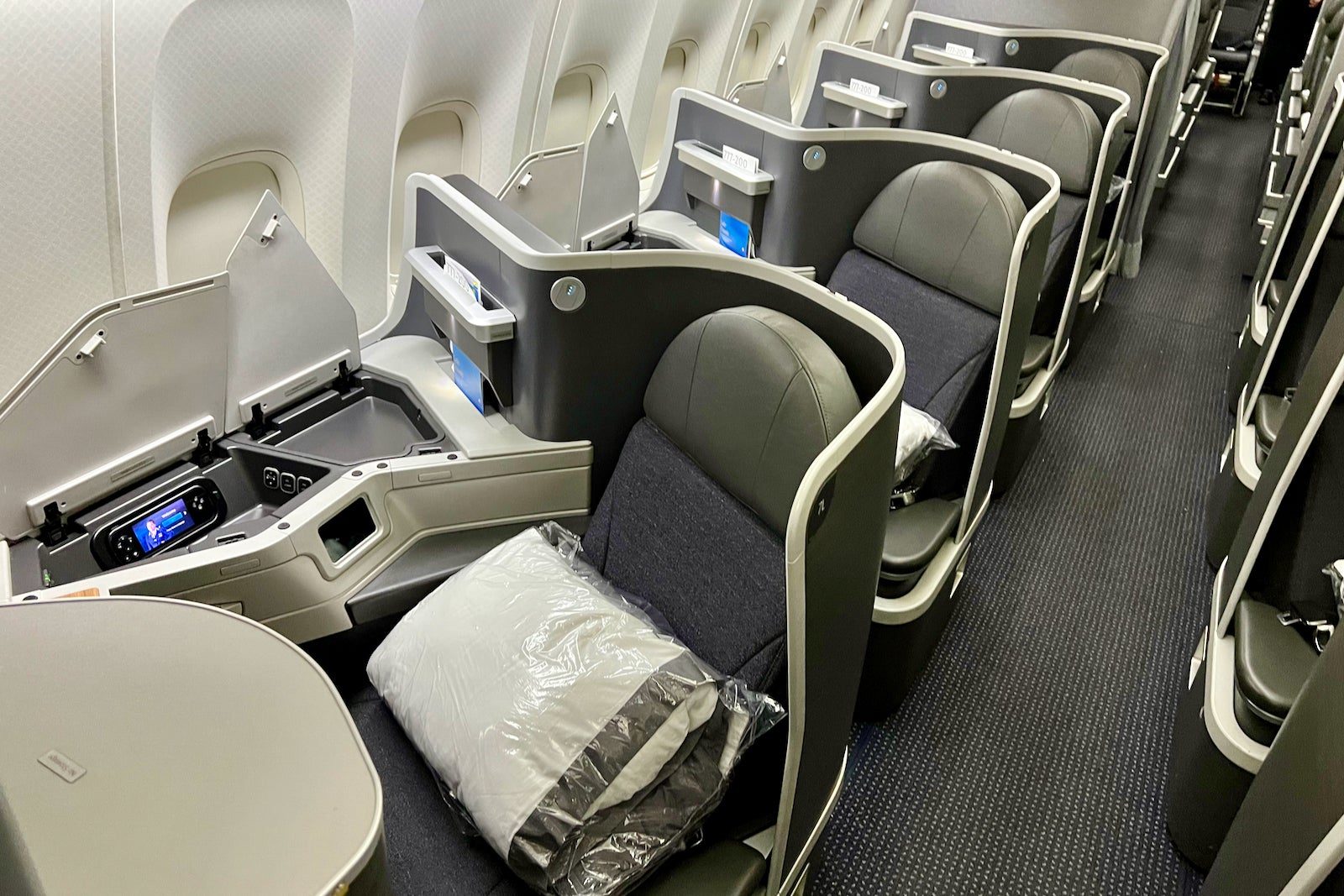
The downside to sitting in the rear four rows is that the entire plane boards through the plane’s second door and passes right next to your seat.
The upside, of course, is that the mini-cabin is more intimate than the one up front.
While all seats share the same bones, I’d avoid row 6 and the bulkhead row 7. The former is practically adjacent to the galley and row 7 is missing a window.
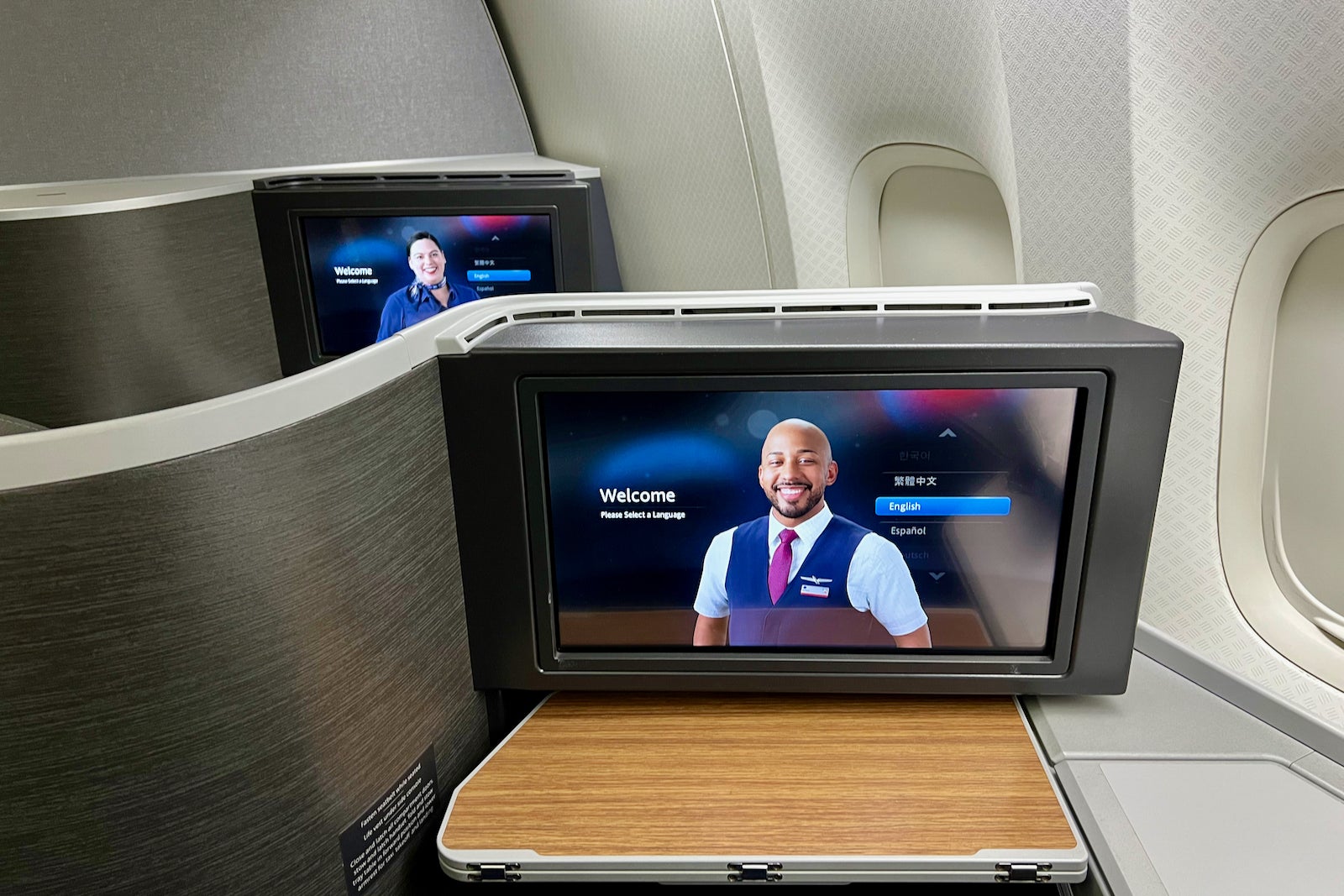
The seats are very well padded and, at 21 inches wide, quite spacious, too.
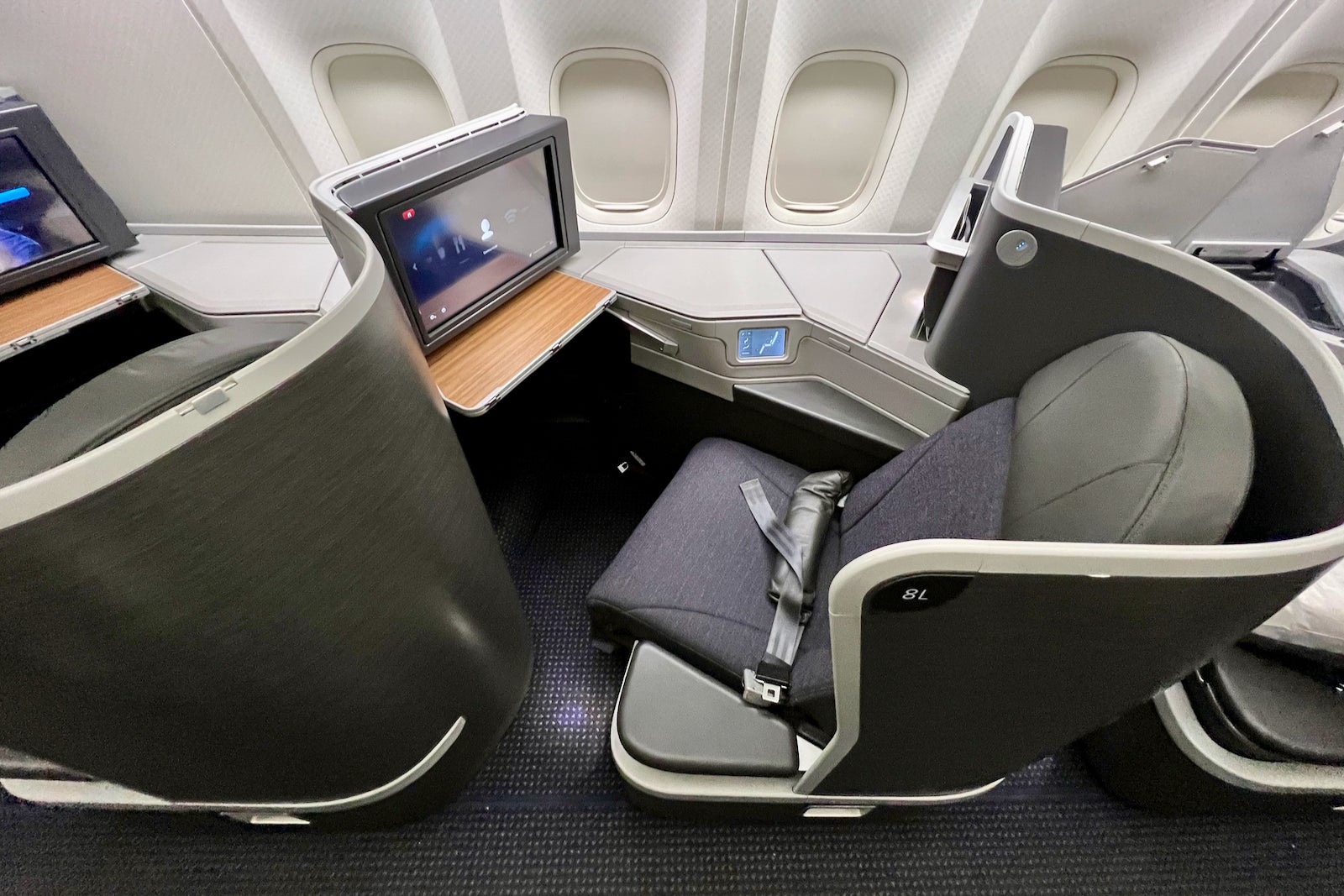
Plus, the armrest raises and lowers to create an even larger sleeping surface.
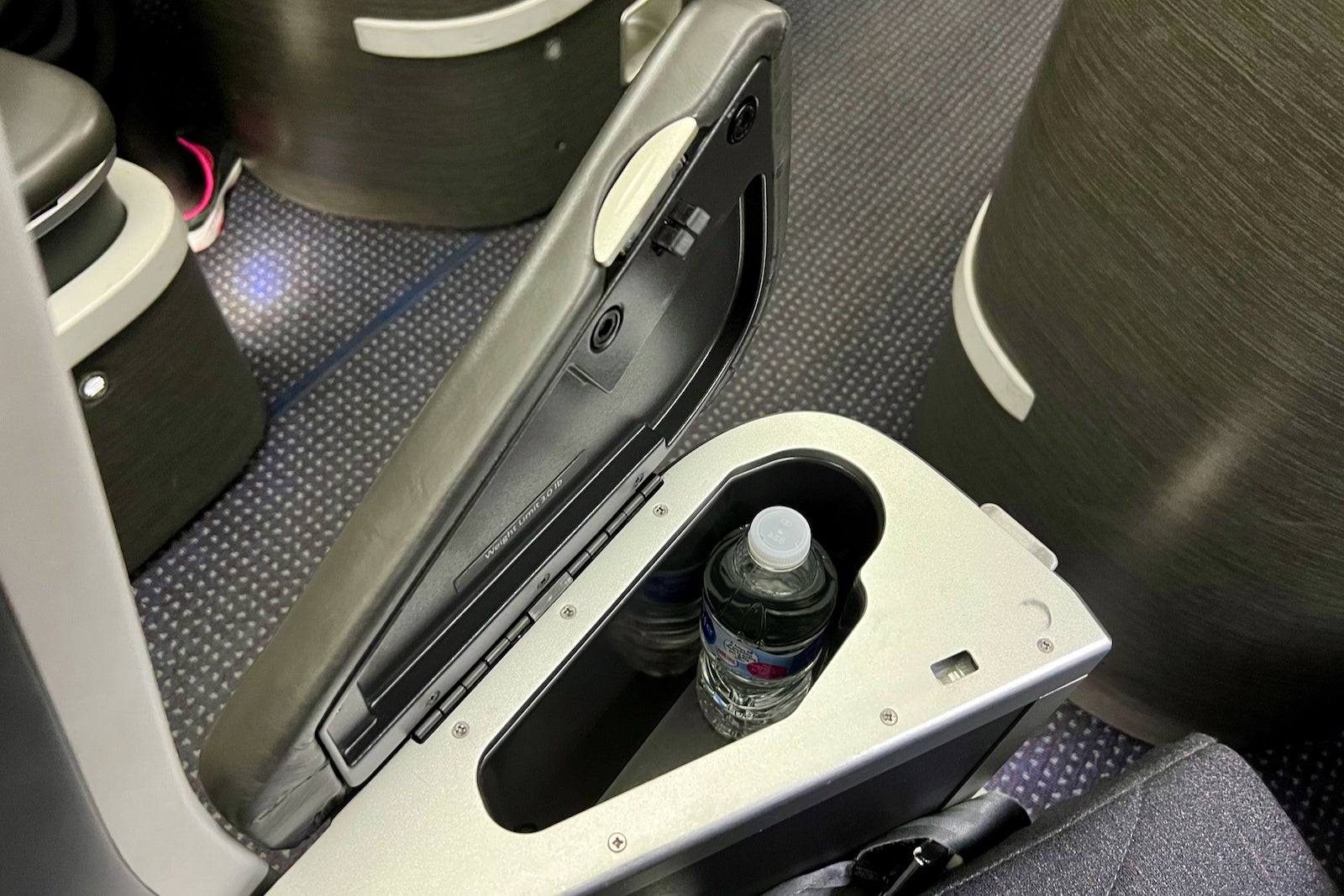
The armrest also doubles as a handy storage compartment for a small book or a water bottle.
Speaking of storage, there’s plenty of room to place your belongings in this seat.
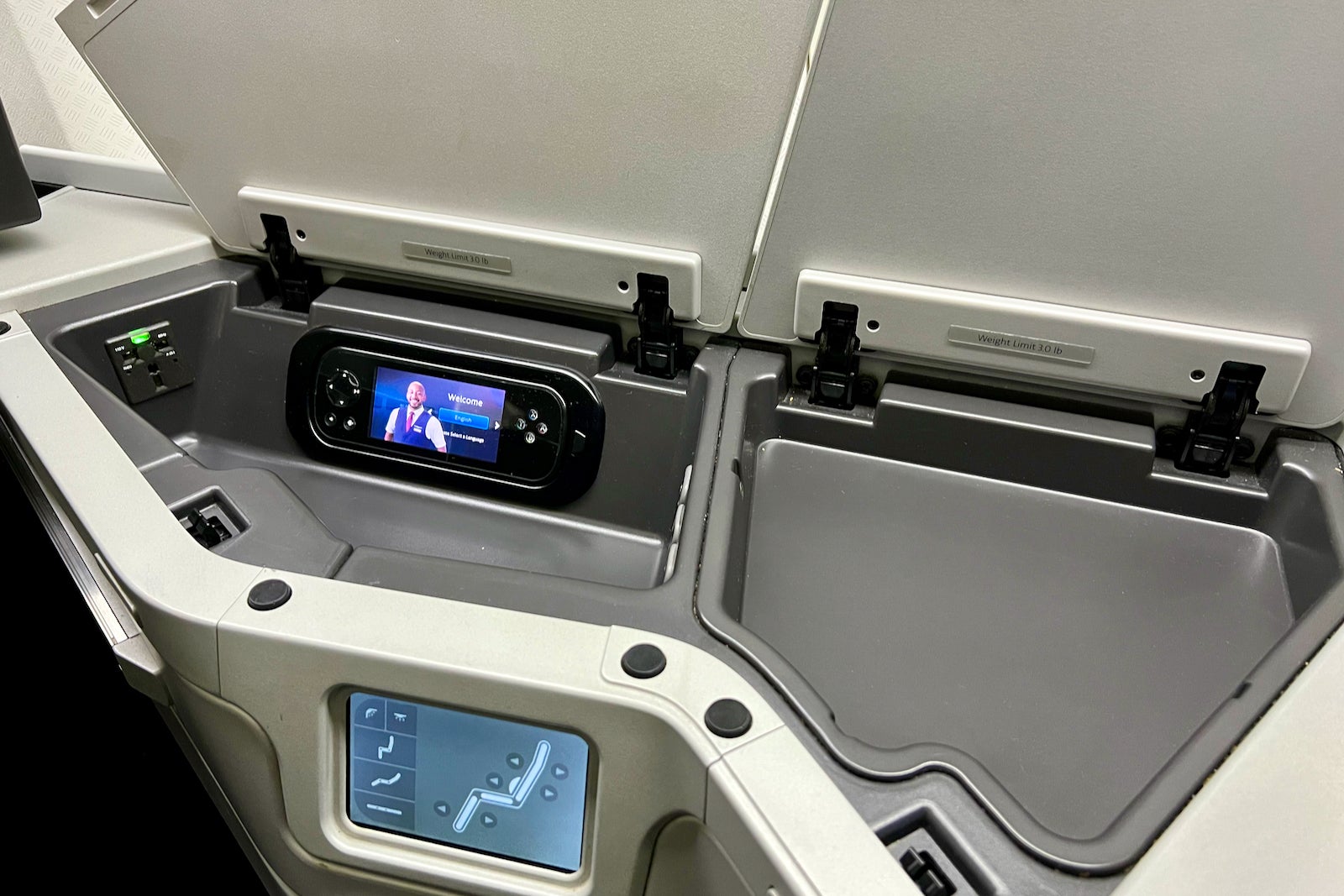
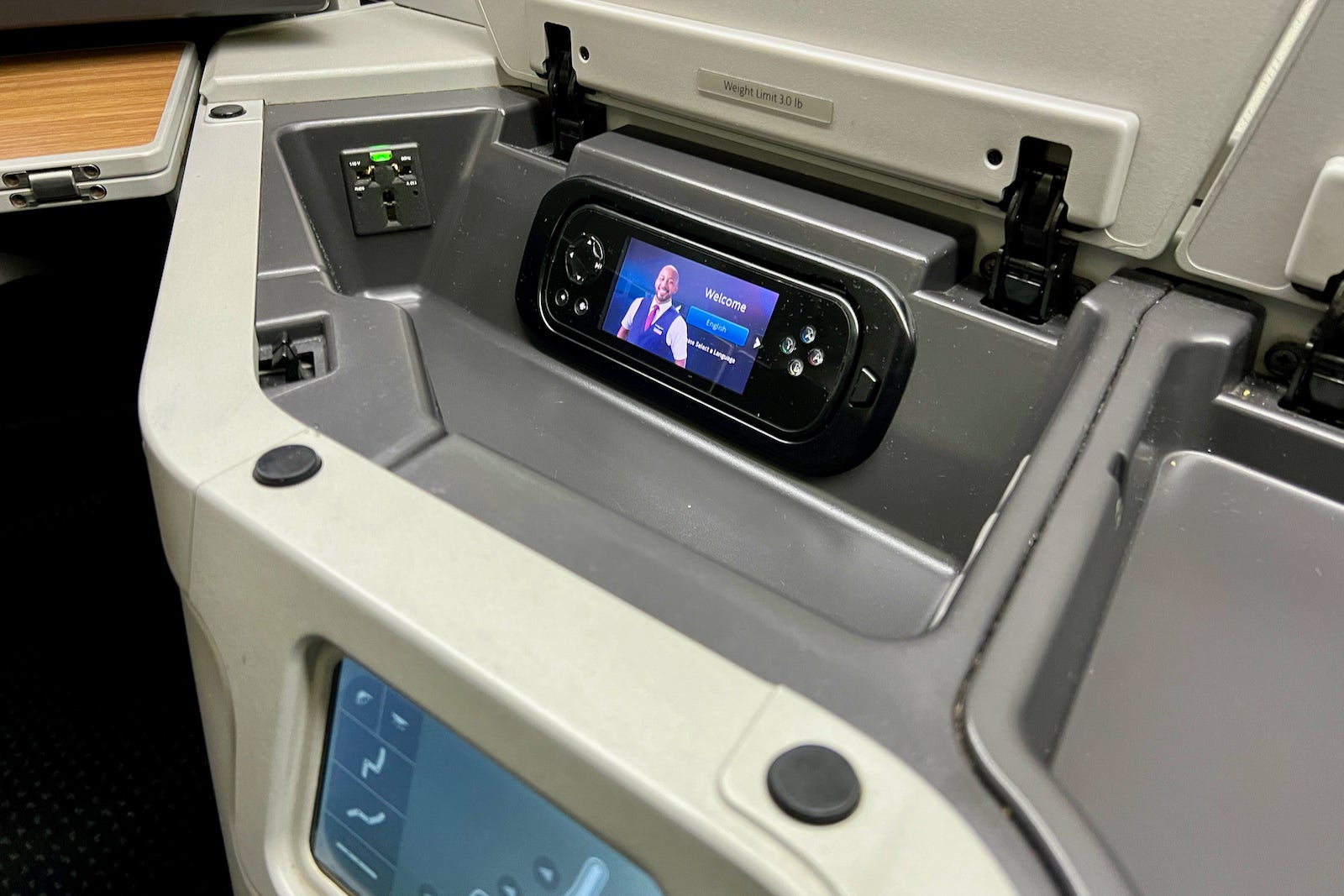
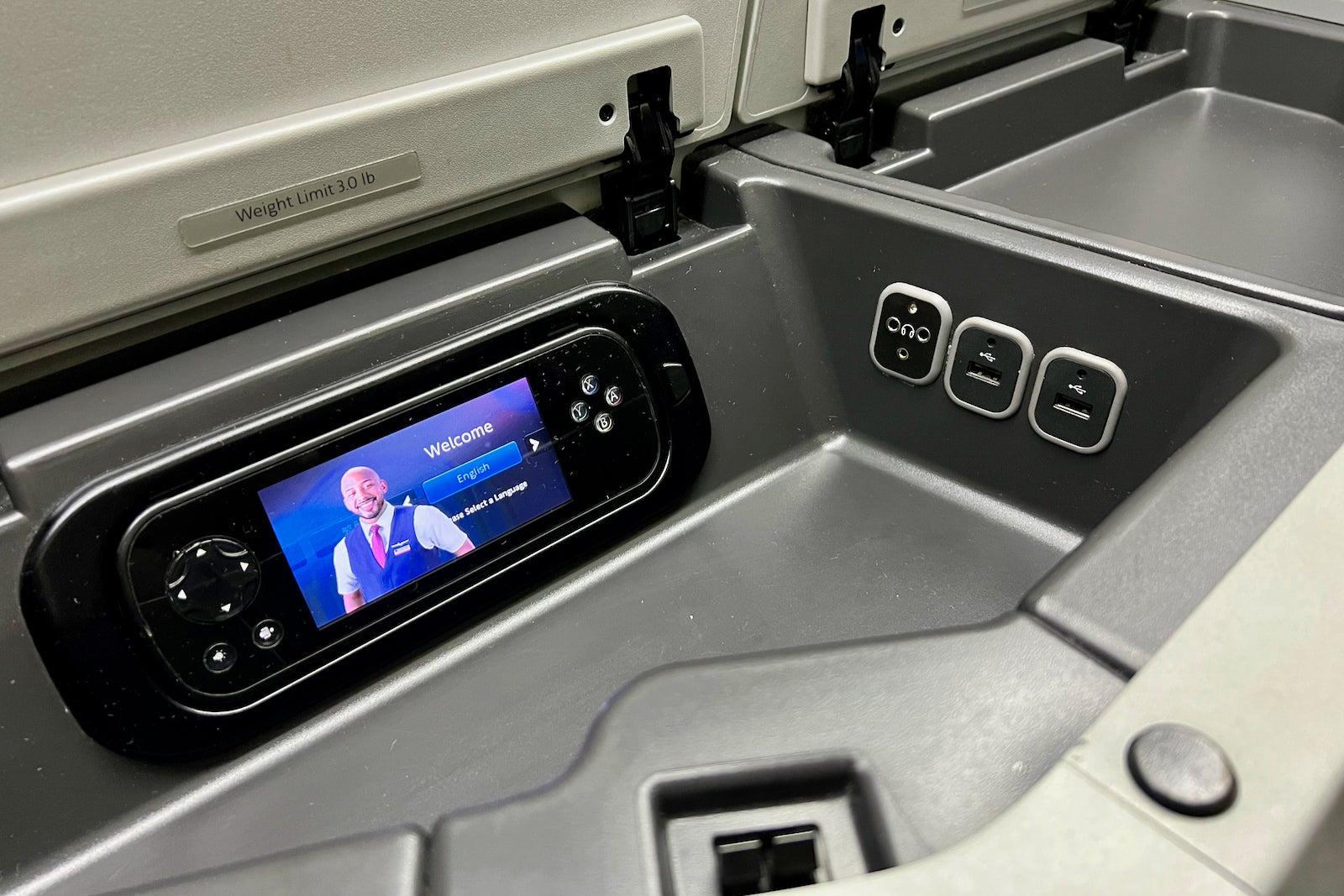
There are two enclosed storage compartments, one of which is larger and deeper. The second is more shallow, and it was the perfect place to keep the amenity kit.
When the compartments are closed, you can stow your laptop or larger electronics on the side table. The exposed literature pocket was large enough to hold my iPad.
The seat is controlled via a small, 3.5-inch digital display at elbow level. The controls are intuitive — there are three presets and three fine-tune adjustments — and the display is responsive to touch.
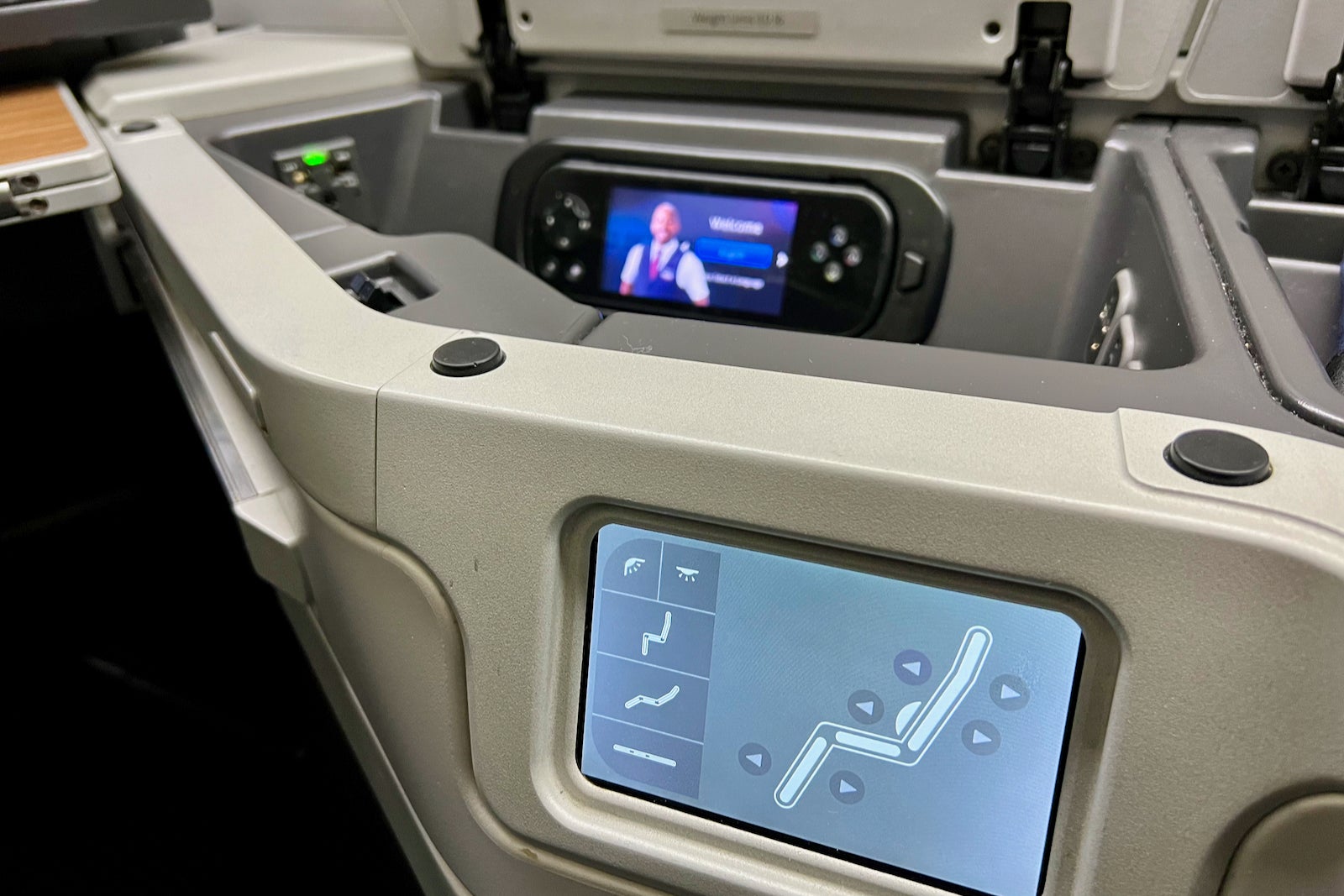
The bi-fold tray table can be found under the seat-back monitor and slides on its track at the click of a button. Measuring 17 inches wide by 18 inches long, the tray table is plenty large for most laptops, including my 13-inch MacBook Pro.
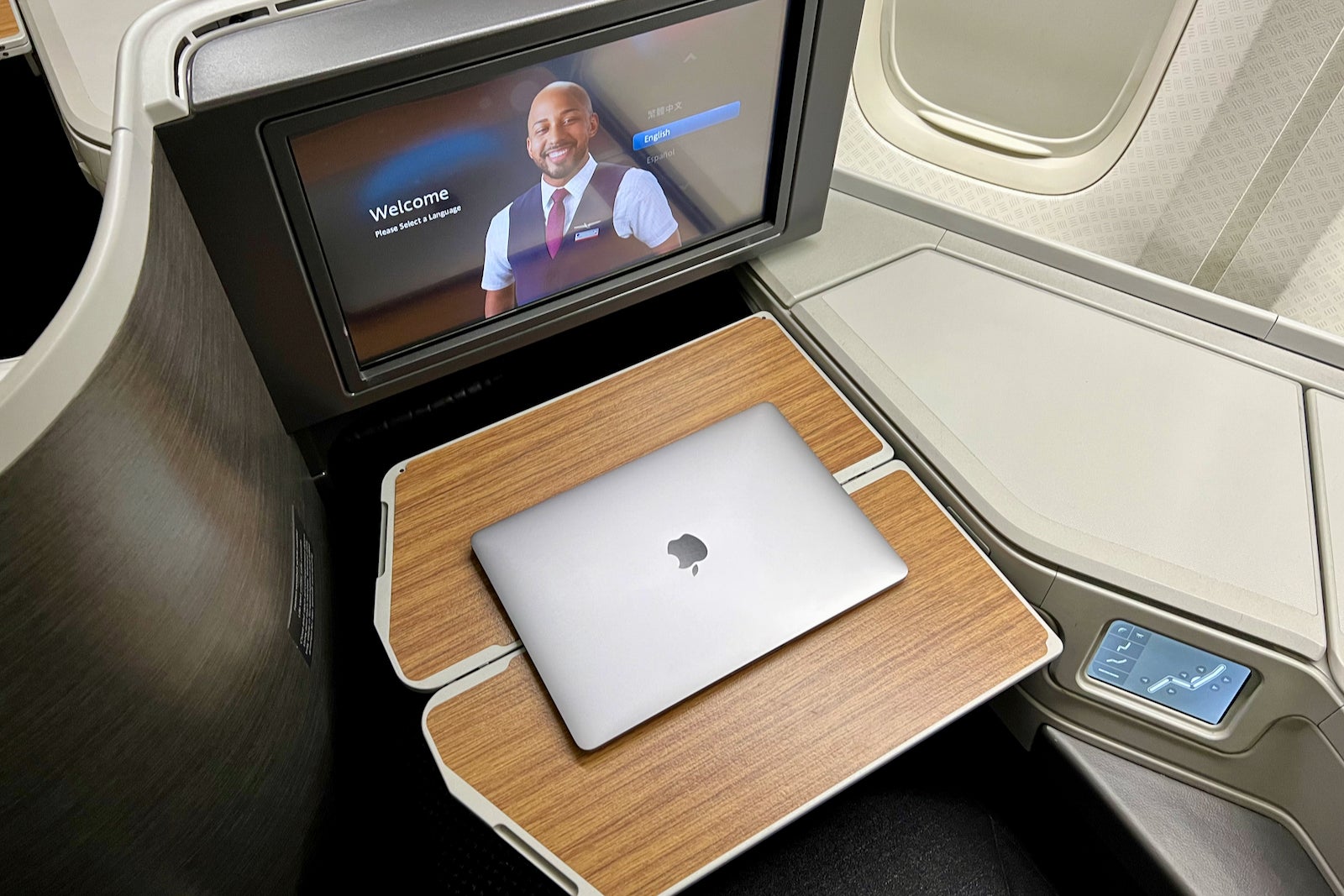
When it’s time to snooze, the seat converts into a fully flat bed that measures 81 inches long. The bed was incredibly comfortable, and I particularly appreciated the extra sleeping surface when I lowered the armrest.
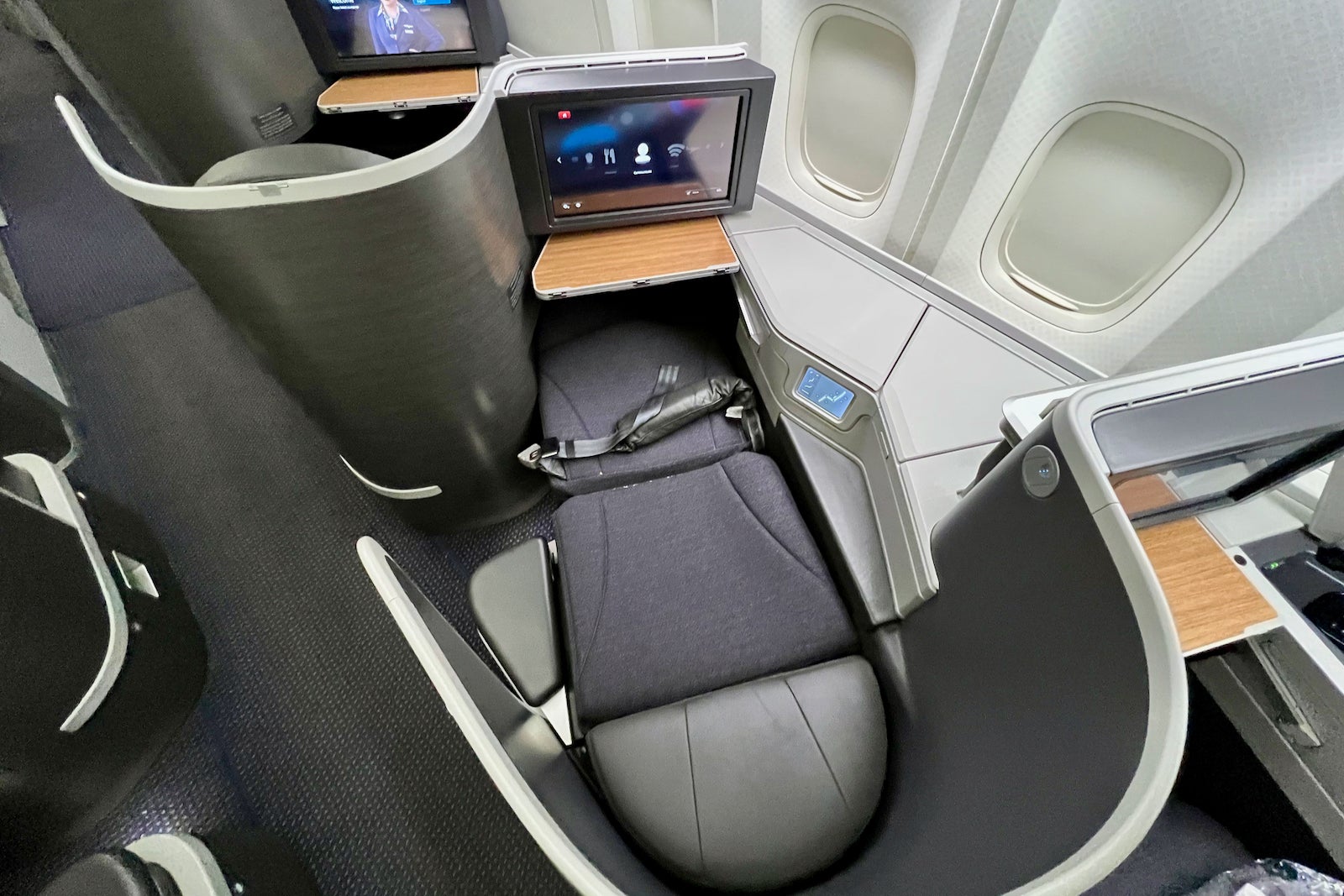
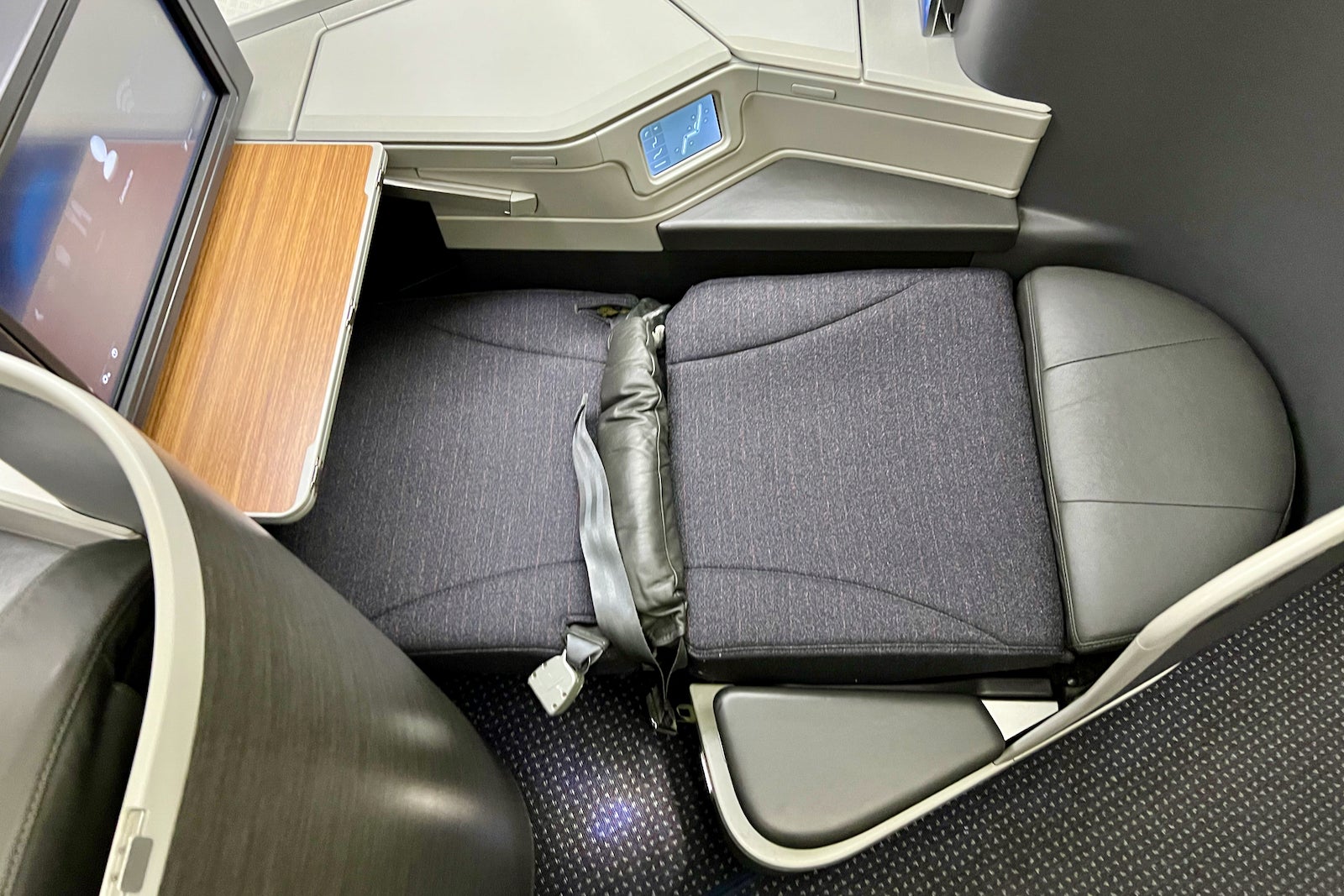
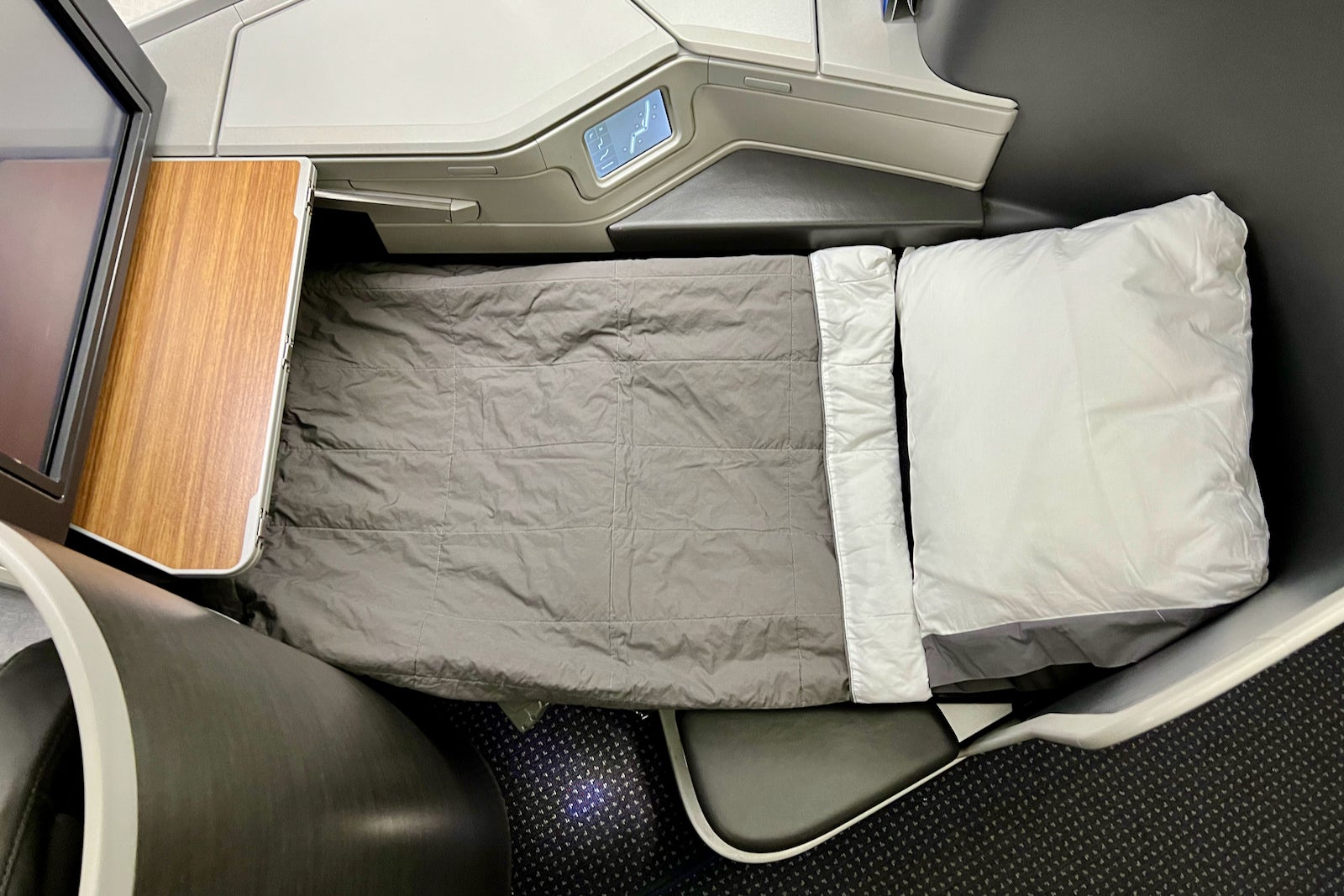
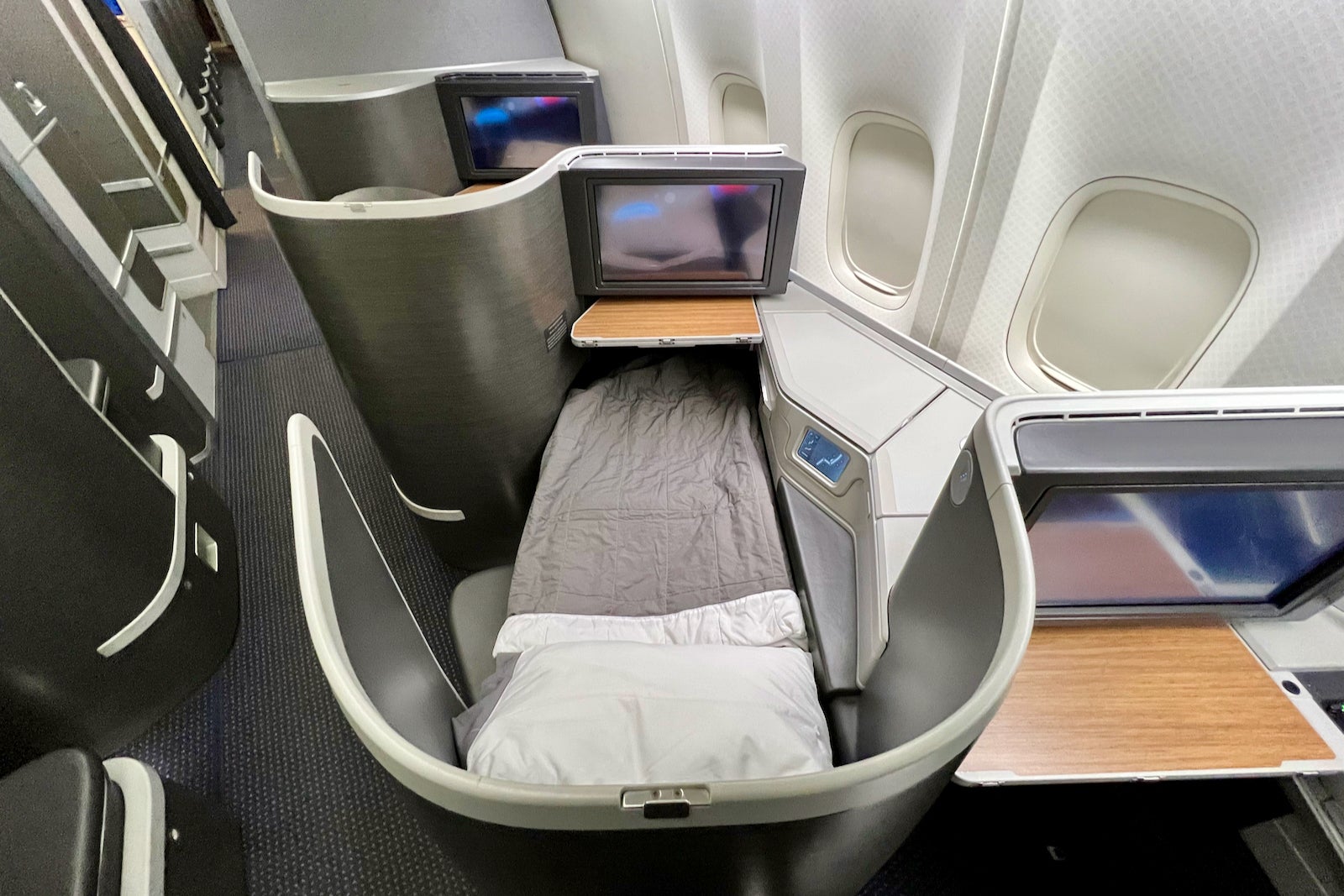
The footwell is quite large, with plenty of space for my size 11 feet. There’s even a shoe storage cubby next to the footwell.
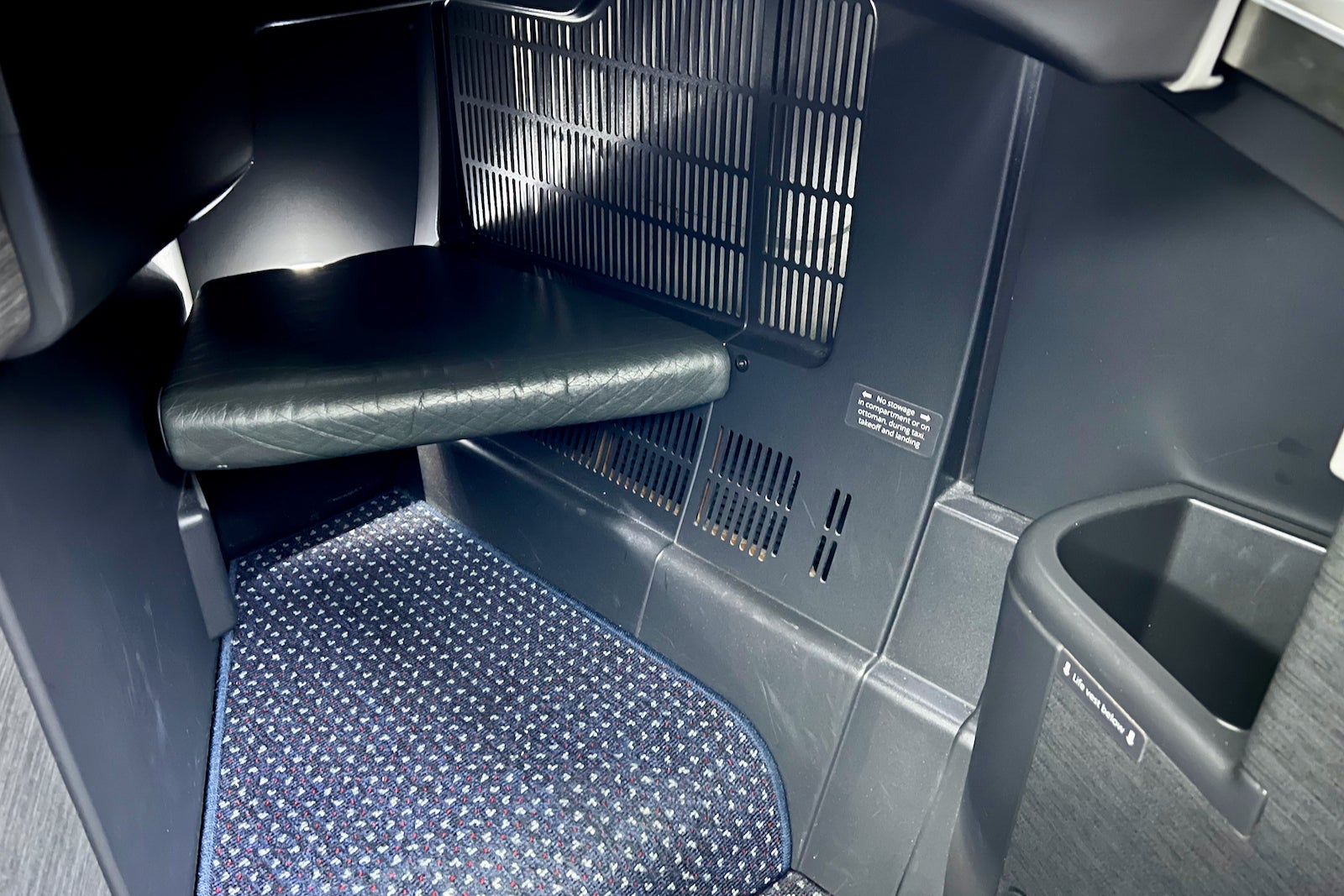
There are three lavatories for business-class passengers, each stocked with C.O. Bigelow hand soap (one of American’s previous suppliers of soaps and bathroom amenities).
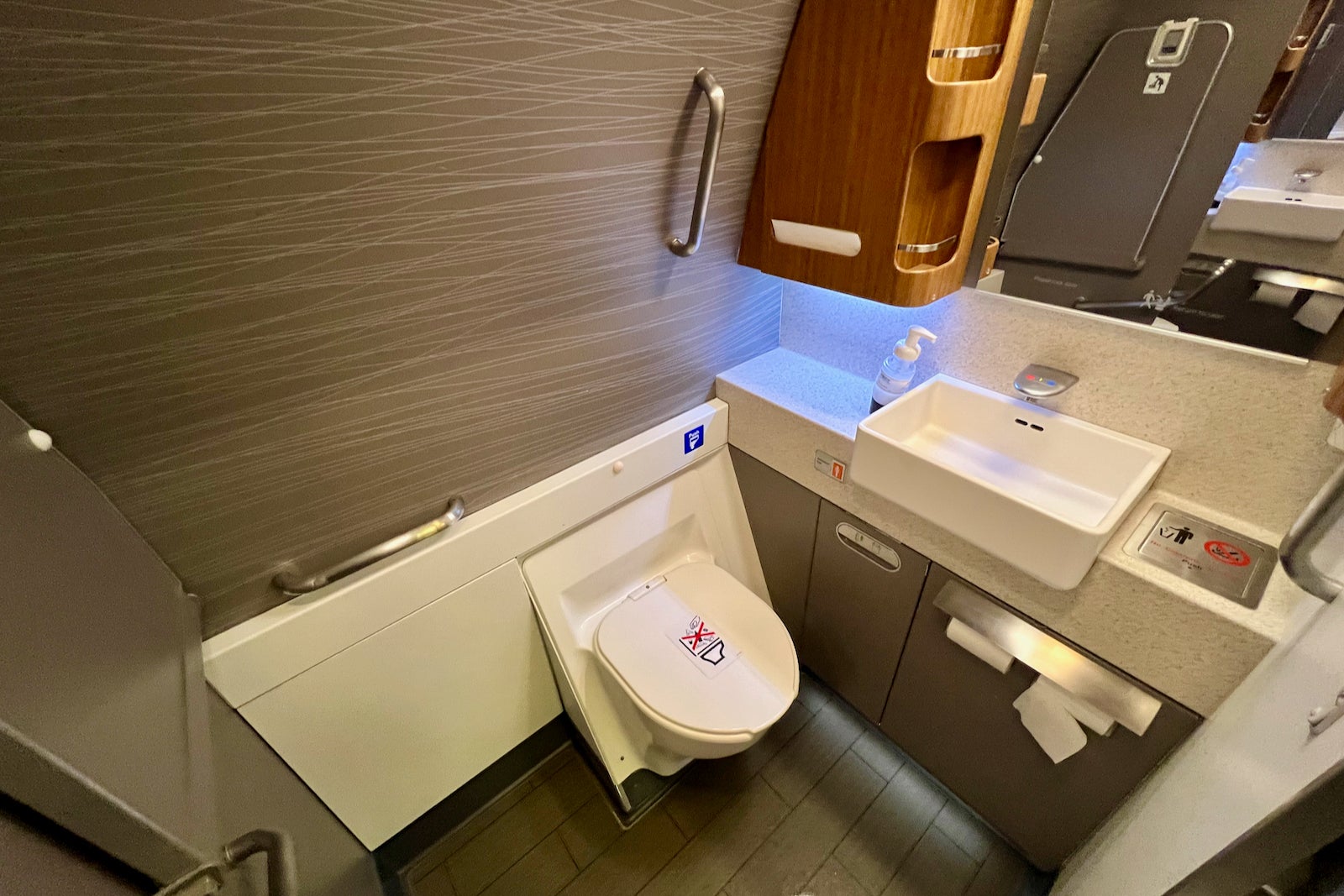
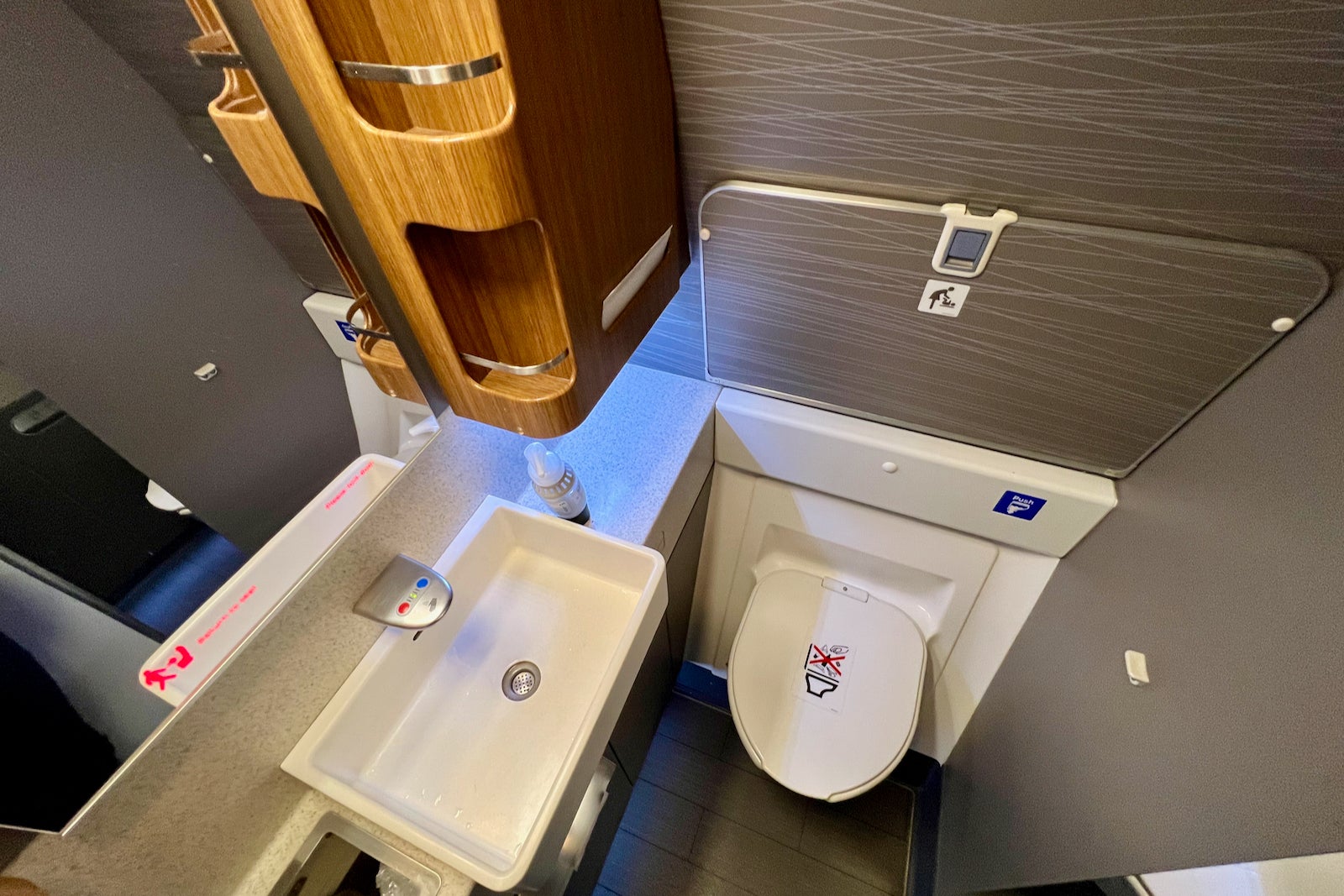
The bathroom next to Door 2L is oversized to accommodate those who use a wheelchair.
One feature which I particularly appreciated was the individual air nozzles in the passenger-service unit. This way, I didn’t need to rely on the purser’s temperature preferences to get comfortable.
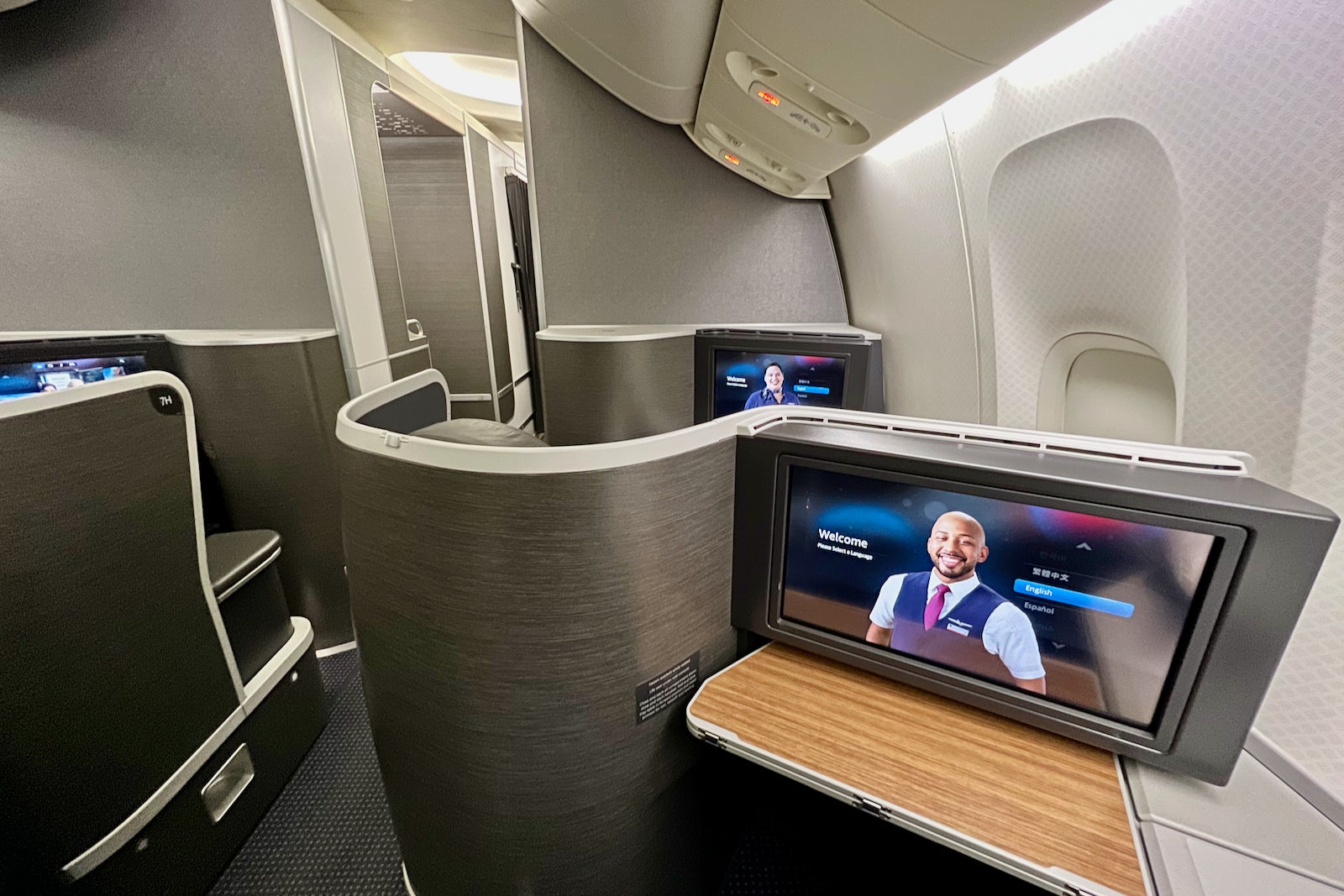
All in all, the Rockwell Collins seat is a top-notch product.
Unfortunately for American, the carrier is up against stiff competition flying from New York to Tel Aviv. Delta sends its flagship Delta One Suites-equipped Airbus A330-900neo to Tel Aviv, and El Al and United deploy 787-10s with a similar-style direct-aisle-access Polaris product to Israel.
While American’s best 777-200 can give the others a run for its money, the fact that you can’t predict which specific type of seat you’ll experience is a big drawback to flying with American.
Amenities and IFE
Just like the seats, American’s inflight entertainment is inconsistent.
The carrier’s long-haul fleet is outfitted with seat-back entertainment screens, loaded with a robust media library.
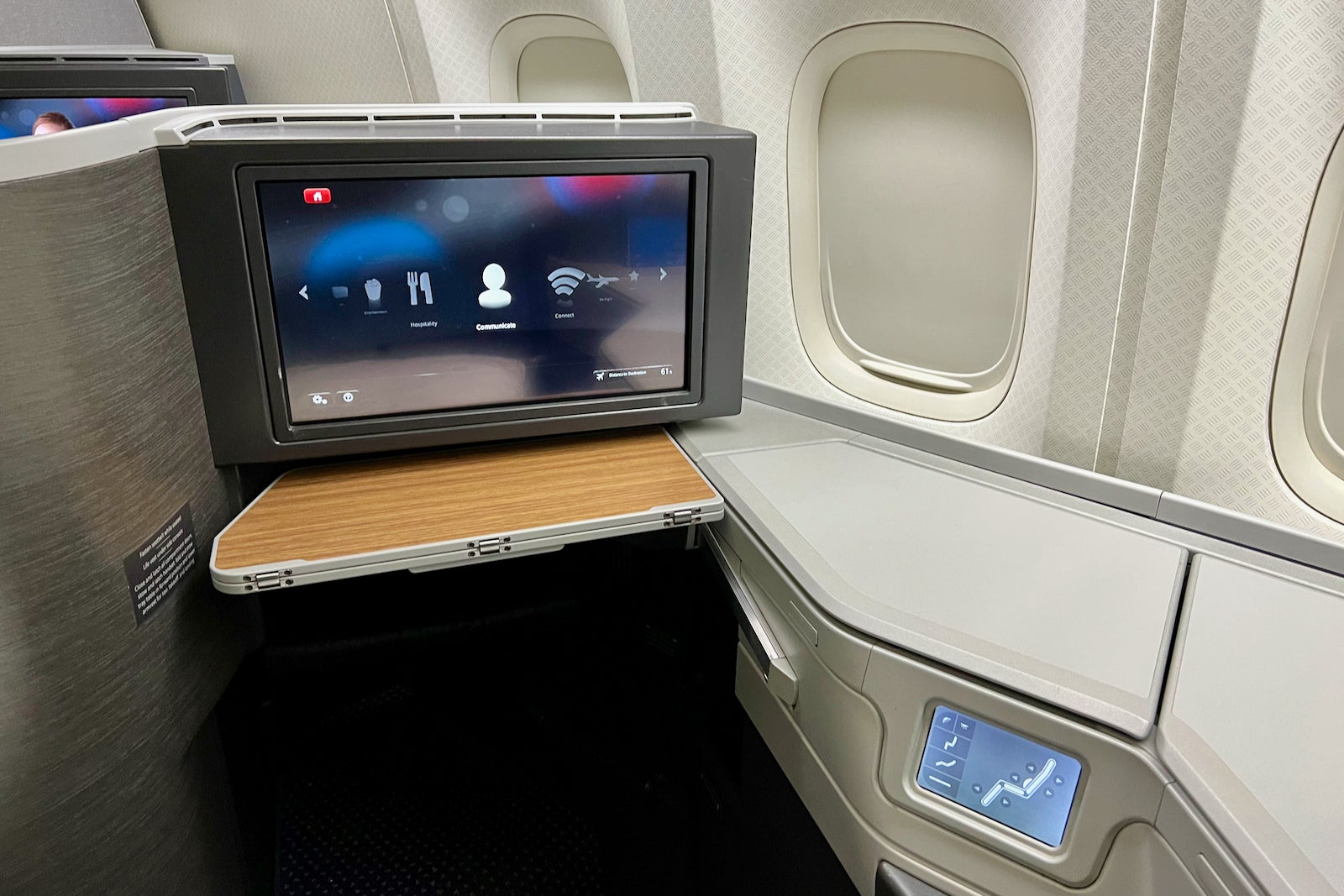
Contrast that to the majority of the domestic fleet, where American is actively removing screens in favor of streaming entertainment.
On the Boeing 777-200, each business-class pod is equipped with an 18-inch touchscreen monitor. The user interface is intuitive — it’s based around a carousel and clicking into each category brings up a sub-menu.
You can control the screen using your finger, or with the retractable touchscreen remote that’s located in the larger storage cubby.
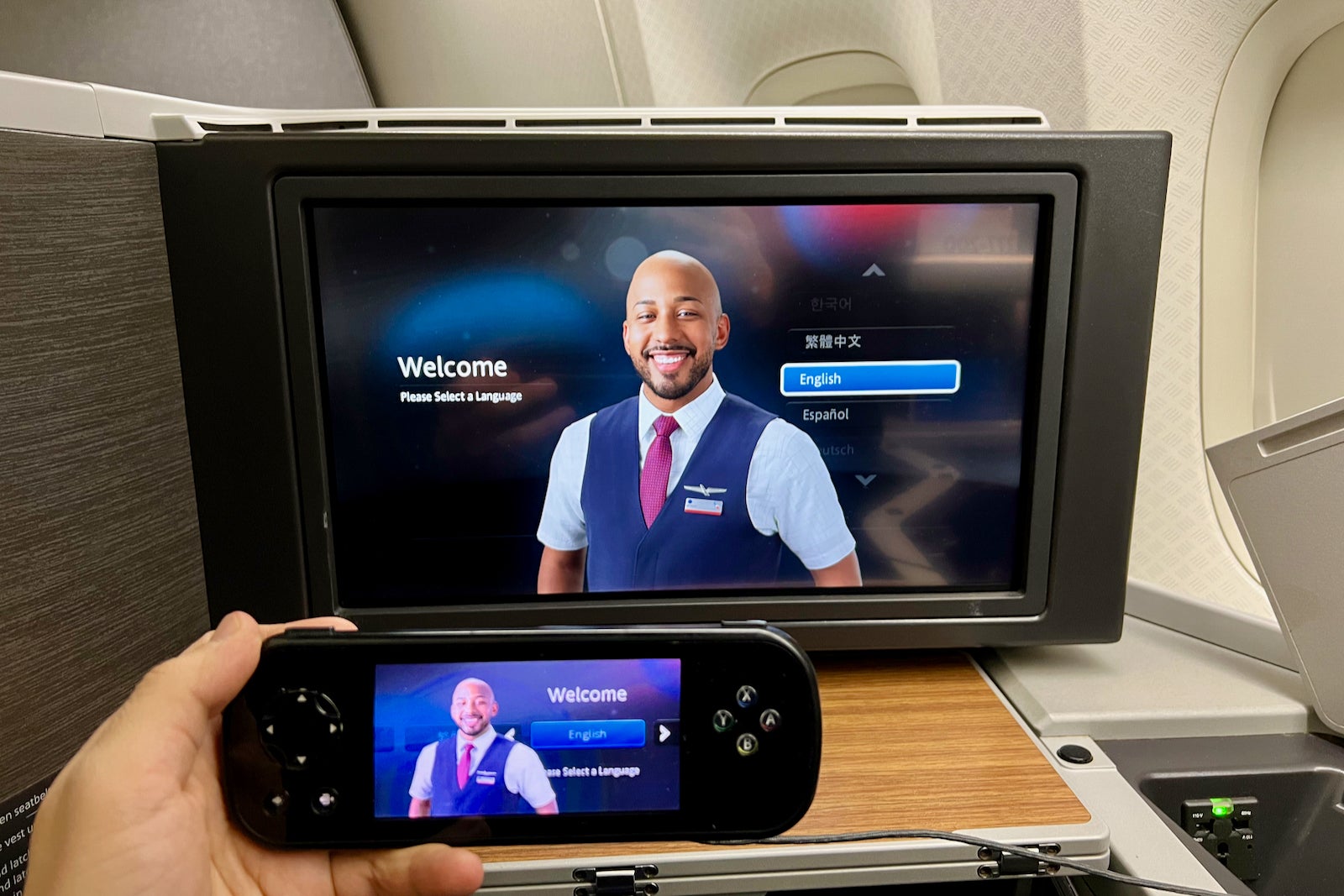
There were 336 movies on demand, including plenty of new releases like “Feeling Through” and “Disney’s Jungle Cruise.” Many of the 234 TV show titles were available with more than one episode, and some even had full seasons.
My new favorite inflight entertainment option on American is Apple TV+, which launched recently as part of an expanded tie-up with the tech giant.
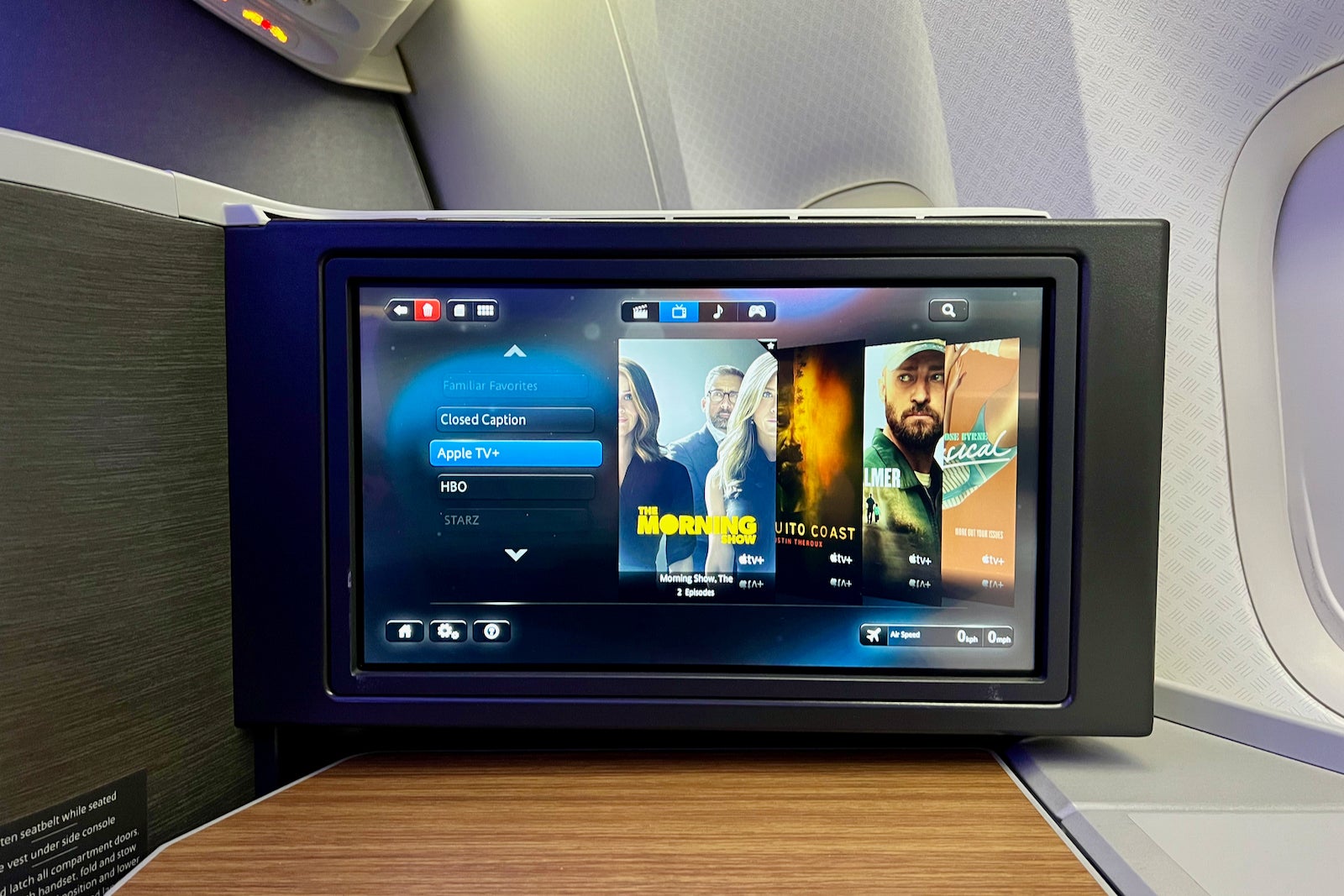
There were select episodes of two of my favorite shows, “Ted Lasso” and “The Morning Show,” available on demand. Several full seasons of HBO classics were also on offer, including “Curb Your Enthusiasm” and “The Sopranos.”
When I wasn’t watching “Ted Lasso,” I was tuning into the airshow to monitor our progress along the 5,677-mile route.
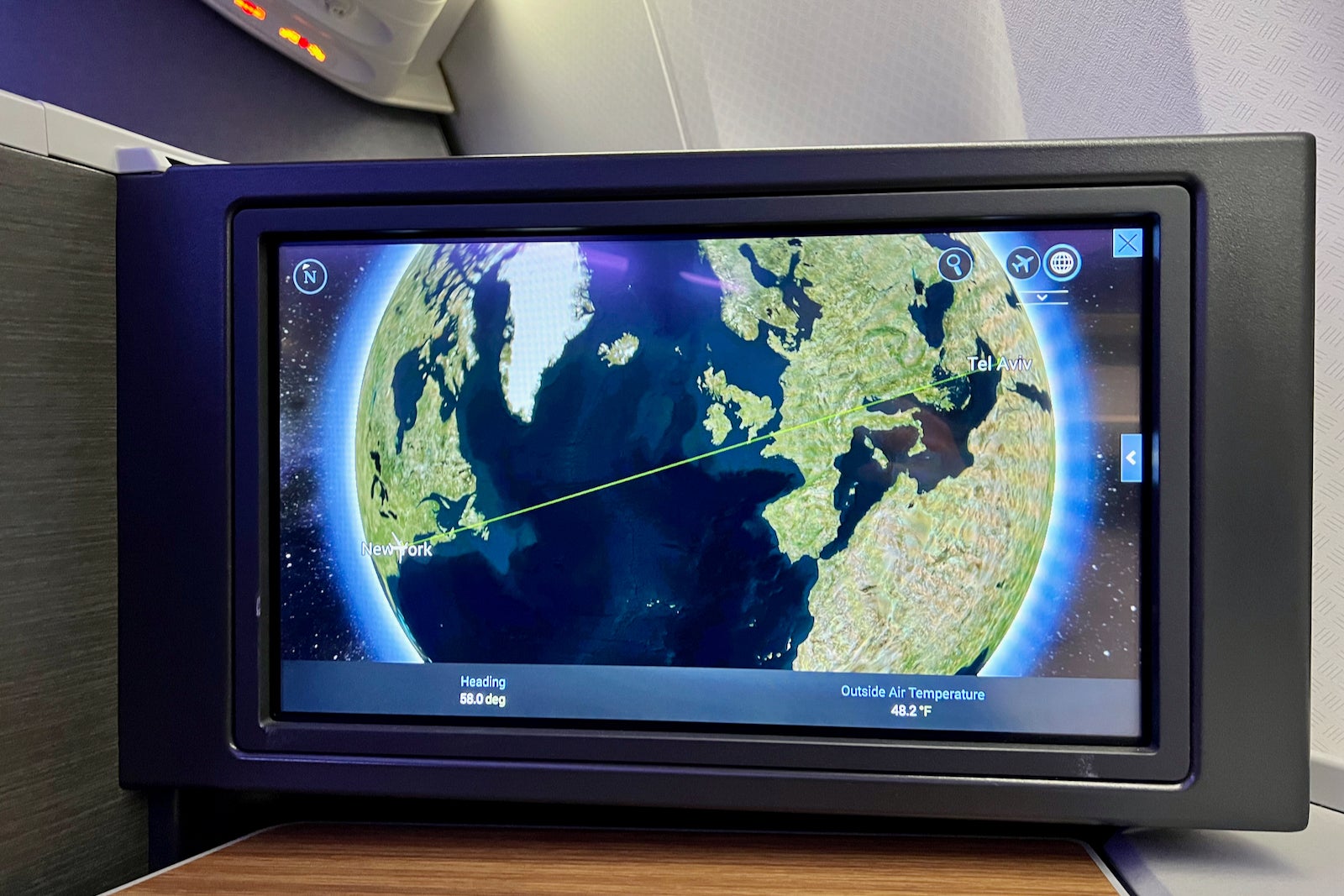
To enjoy the content, American lends each business-class passenger a pair of Bang and Olufsen H9i headphones, some of the nicest headphones you’ll find in any business-class cabin worldwide. (It’s just too bad they were collected a full hour before landing.)
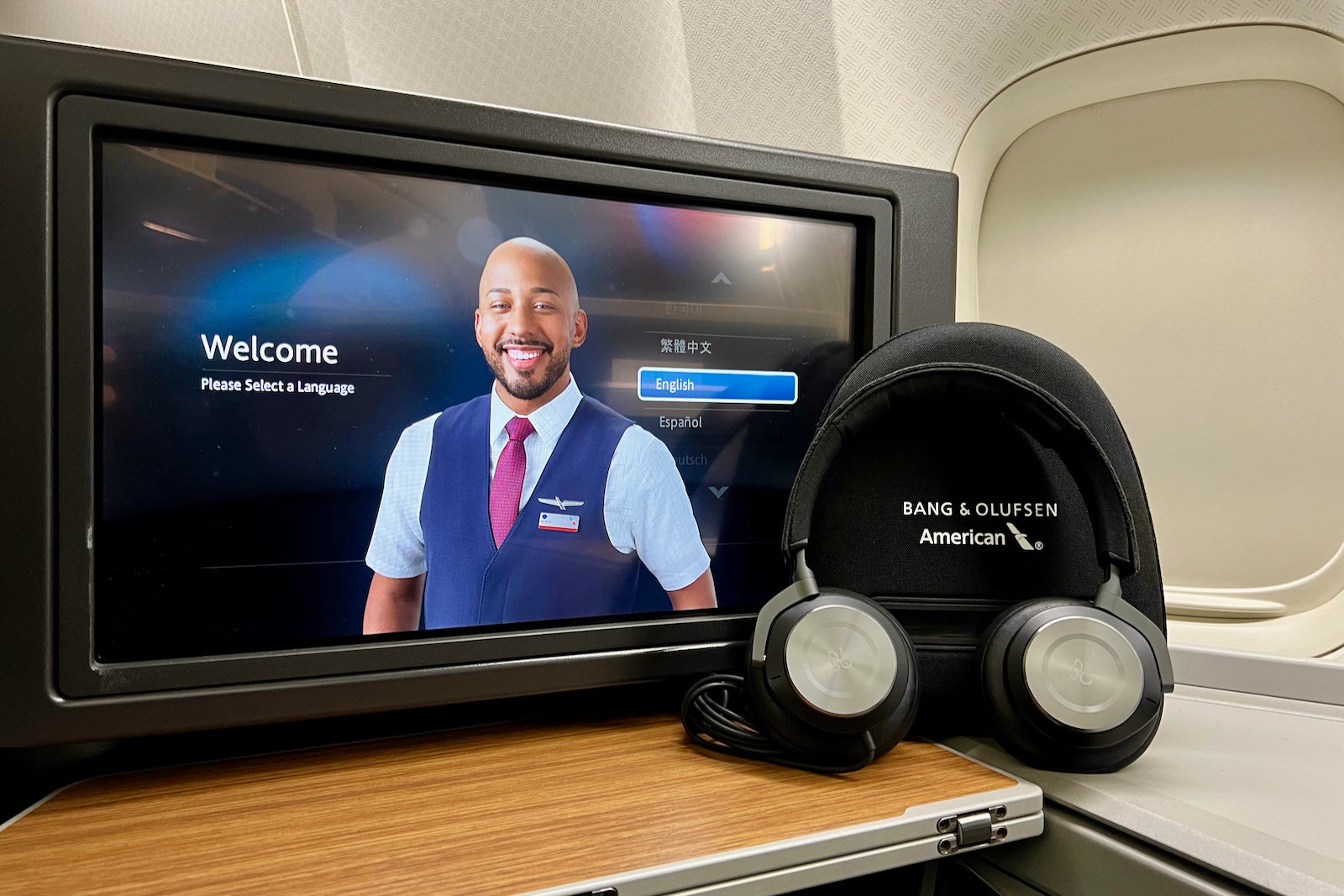
Each seat is equipped with a universal AC outlet, as well as two USB-A charging ports.

Satellite-based Wi-Fi, powered by Panasonic, was available on this flight for $35 for a full flight pass without data caps. Download speeds measured nearly 30 Mbps, though upload speeds failed to exceed 1 Mbps during the flight.
In terms of amenities, flight attendants distribute a flimsy Shinola-branded amenity kit during boarding. It is stocked with the bare essentials, including an eyeshade, earplugs, dental kit, hand lotion, pen and socks.
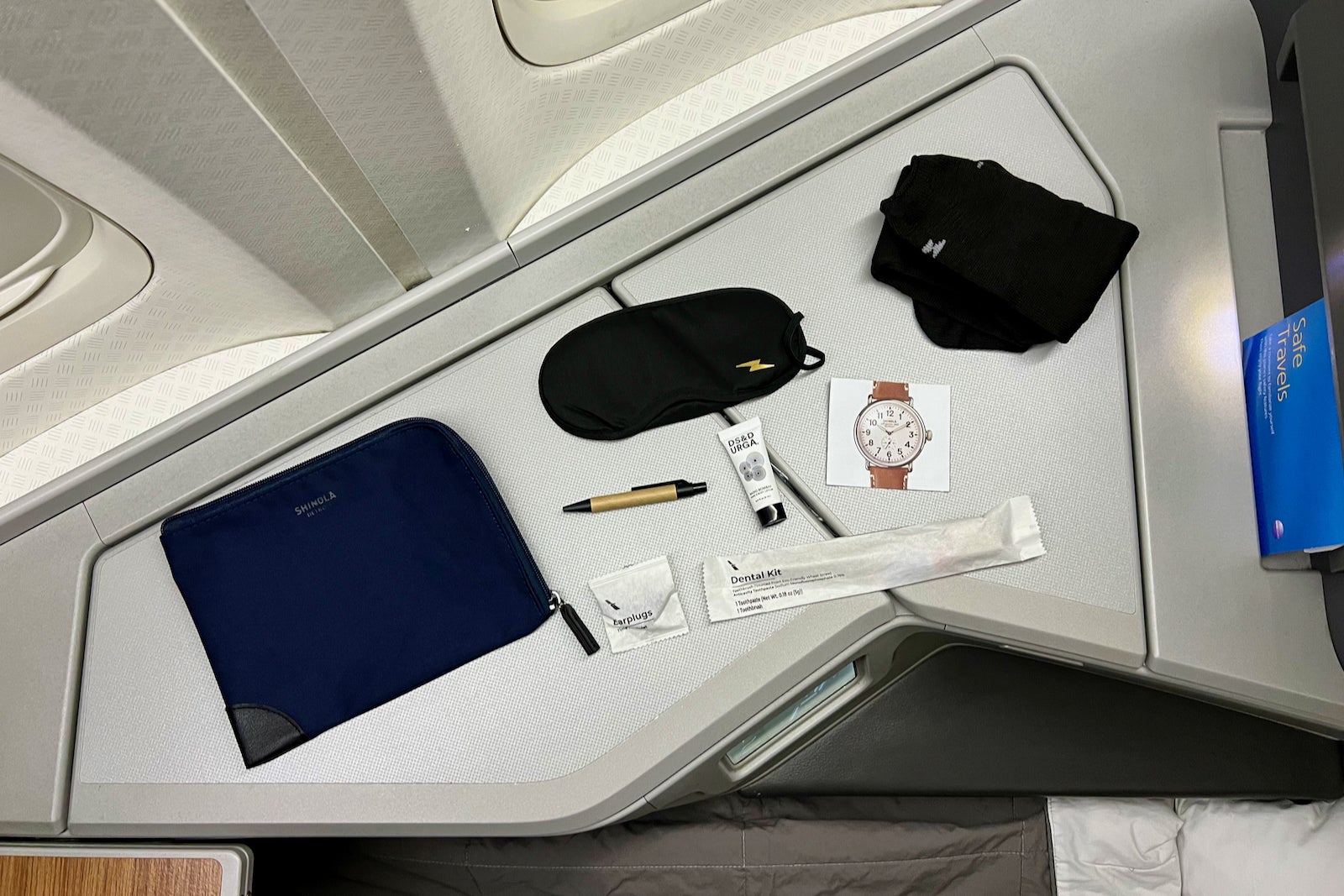
There was a plastic-wrapped Casper-branded pillow and duvet waiting at each pod during boarding. While the pillow was plush, the blanket was a bit scratchy, and not nearly as comfortably as the duvet you’ll find in Delta One (Westin Heavenly bedding) or United Polaris (Saks Fifth Avenue).

Notably, there aren’t any slippers, mattress pads or pajamas available, three comfort items that you’ll find in United’s Polaris business class on this route.
While American’s wide-body jets offer an above-average entertainment selection, the amenities pale in comparison to what Delta and United offer.
Food and beverage
If you’re after a pre-pandemic inflight service experience, then look no further than American Airlines. Except for a couple of minor changes, American’s inflight dining offerings are largely back to pre-pandemic norms.
It starts on the ground, as you can pre-order your preferred meal between 30 days and 24 hours in advance of your flight.
As someone with dietary restrictions, I love this feature. This way, I can know if one of the entrees fits my preferences or whether I need to order a special meal.
American is offering a full selection of special meals on long-haul flights. That stands in contrast to United, which has still suspended them except for kosher food on Tel Aviv routes.
During the boarding process, the flight attendant taking care of the starboard aisle, Caroline, came through the cabin with printed menus — the first sign that things are “back to normal.” (Neither Delta nor United is currently printing menus.)
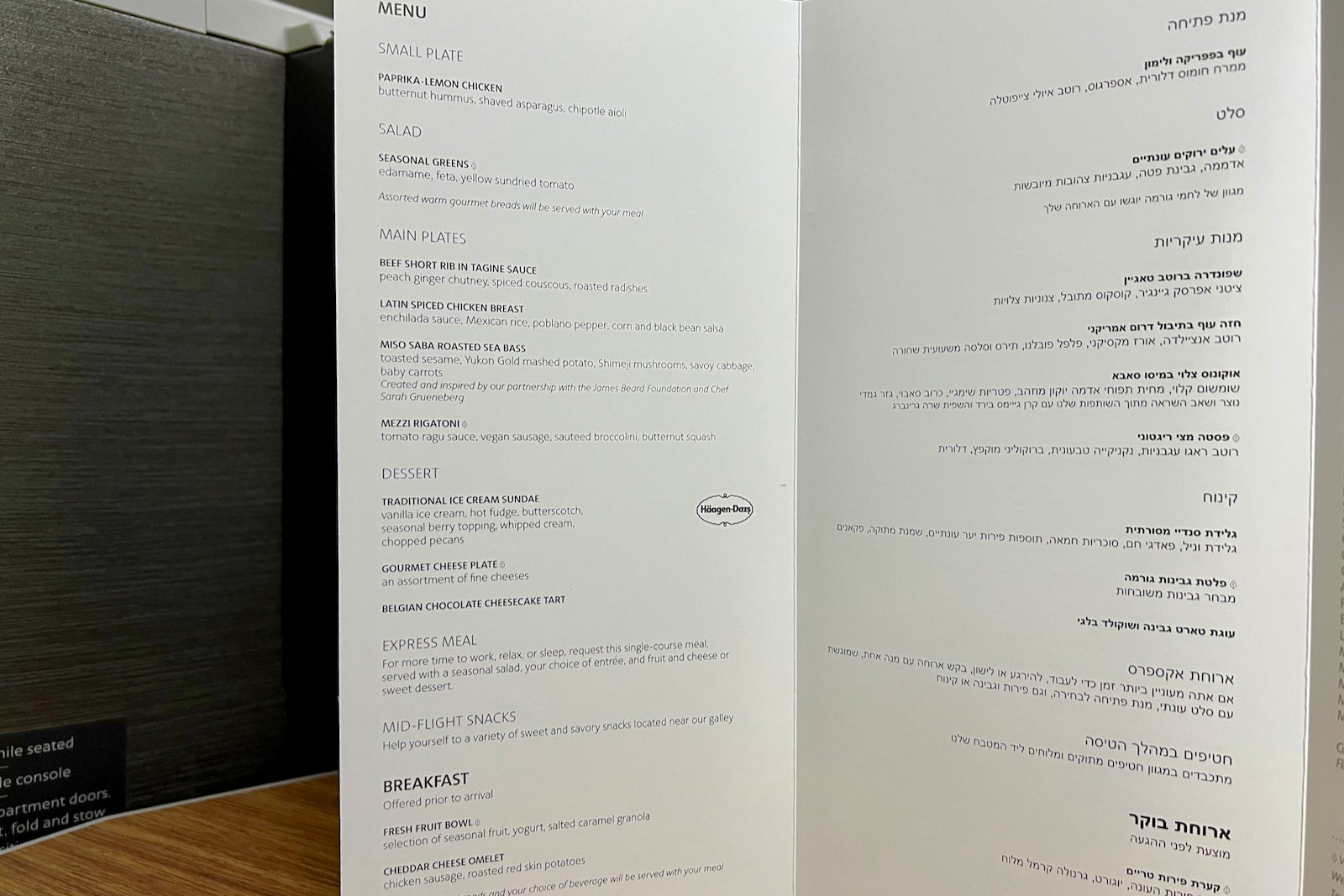
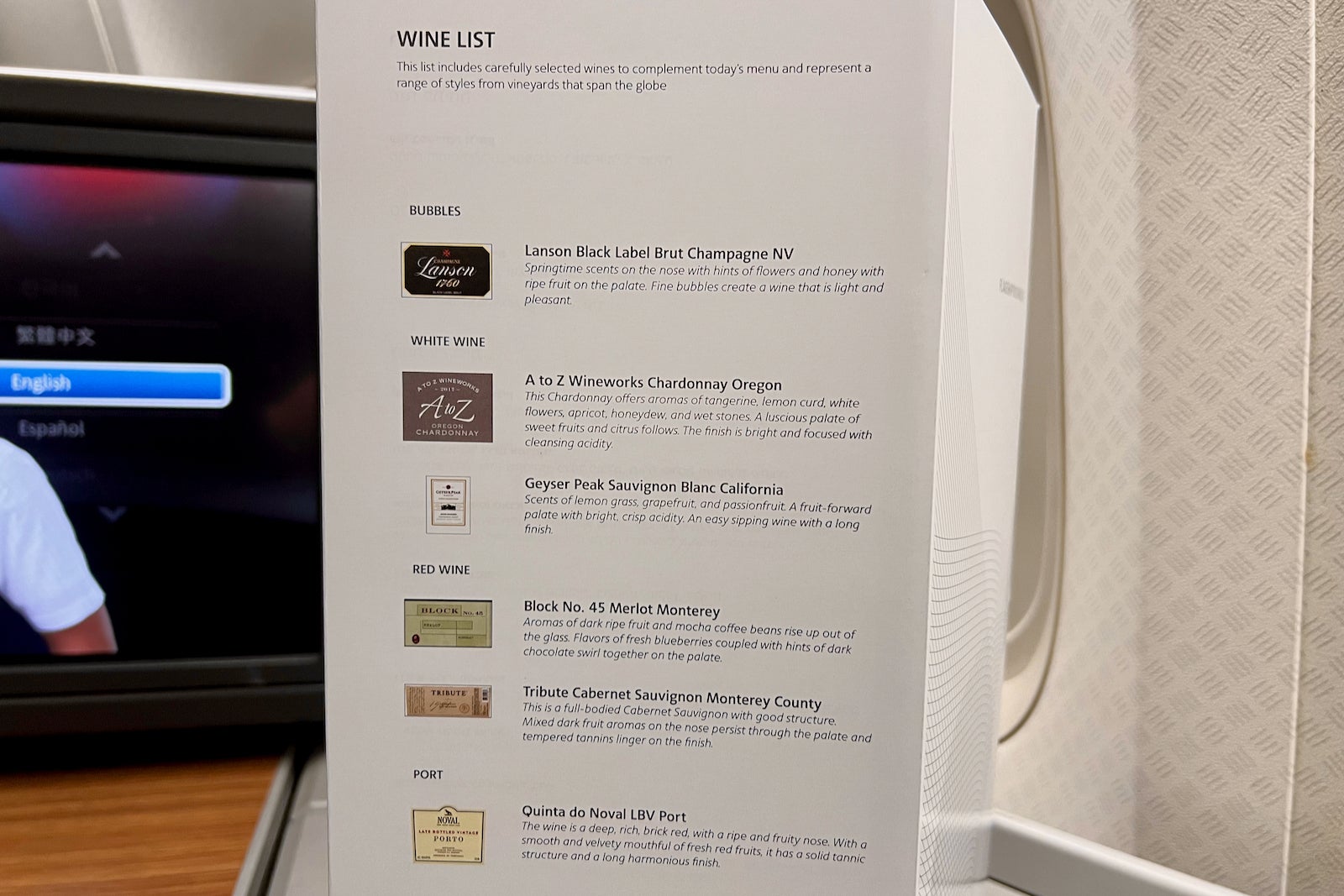
Once airborne, the flight attendants passed through the aisles with a drink service. I selected a glass of ice water and Lanson Black Label Brut Champagne, which you’ll typically find on Virgin Atlantic Upper Class, too.
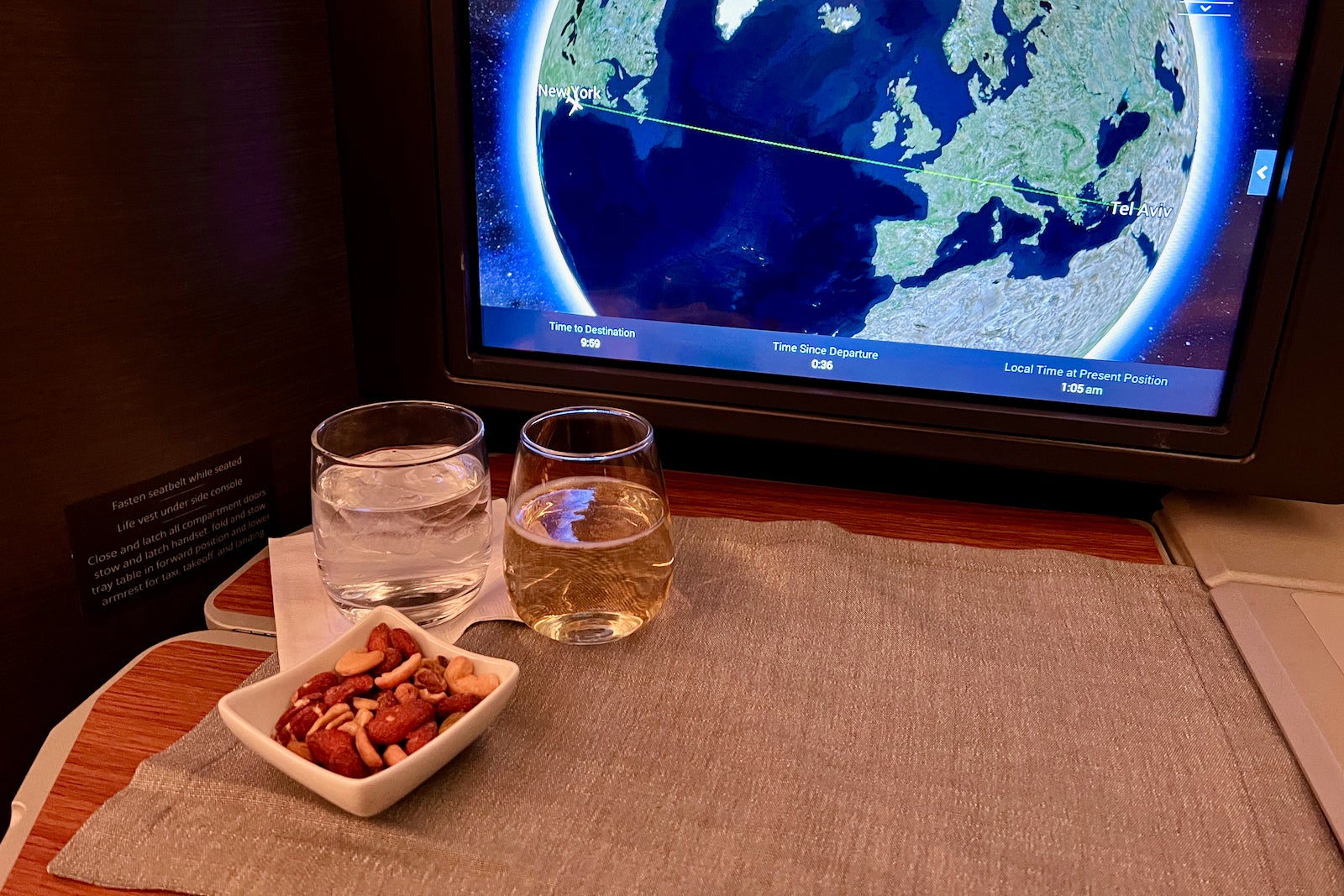
Drinks were served in glassware — American was the first of the Big 3 to restock glasses, on Nov. 10 — along with a ramekin of warm nuts.
The starter (paprika chicken) and salad course came shortly thereafter, also served from a cart.
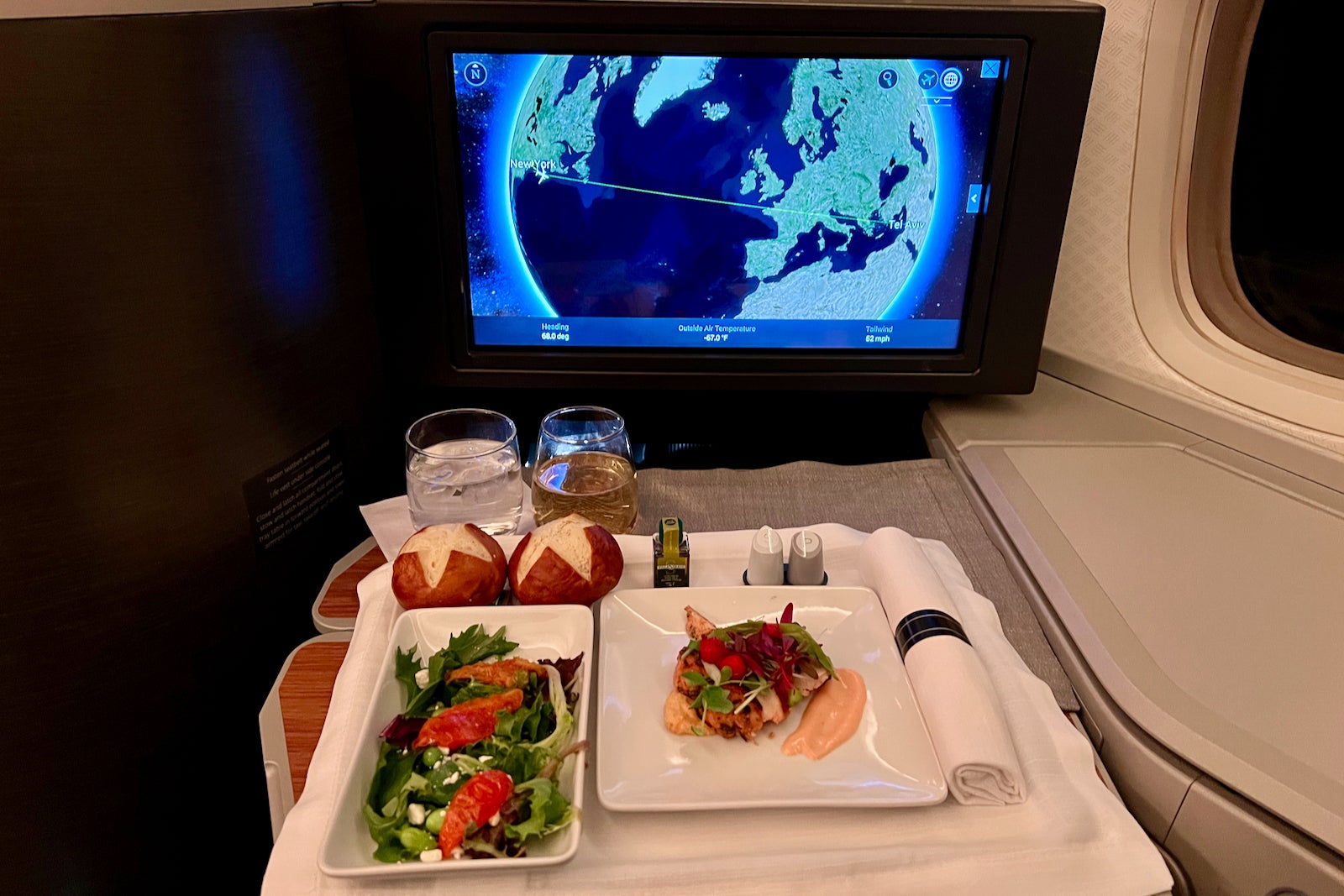
The pre-plated appetizer was served wrapped in plastic, and I was offered a selection of bread — pretzel, white or multigrain — from a plastic bag, as the flight attendant couldn’t find where the metal bread basket was stored.
The starters were delicious, and I particularly enjoyed the salad. The portion was tiny, but I appreciated that it was more than just a boring garden salad.
More than anything, though, I’m always a happy camper with some pretzel bread.
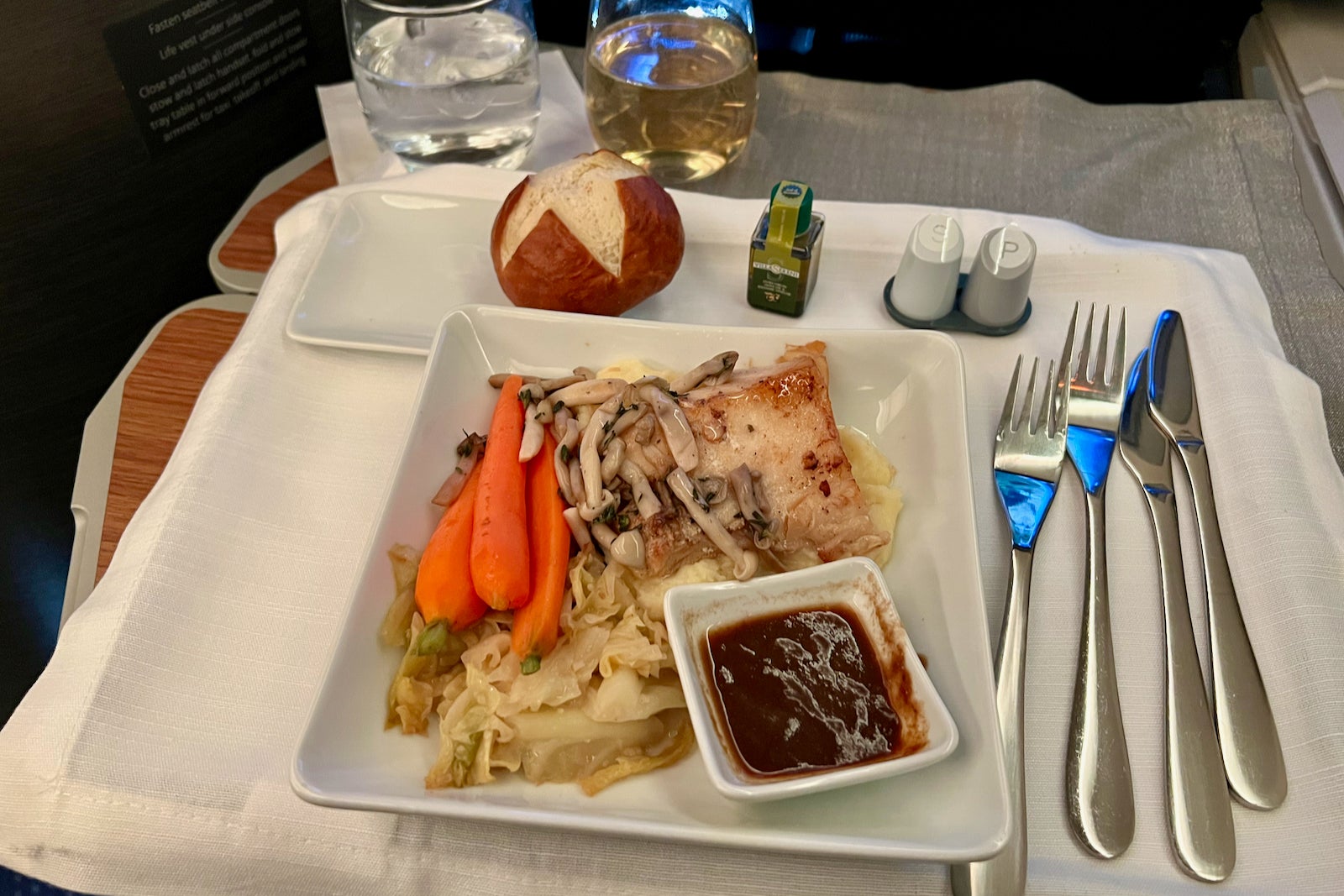
Entrées were served tableside moments after finishing the appetizer.
I selected the miso saba roasted sea bass, which was served lukewarm but somehow overcooked on the edges. The side of mashed potatoes was bland, though the sauce helped give it a good kick.
Dinner concluded exactly an hour after takeoff with the airline’s signature Haagen Dazs ice cream sundae.
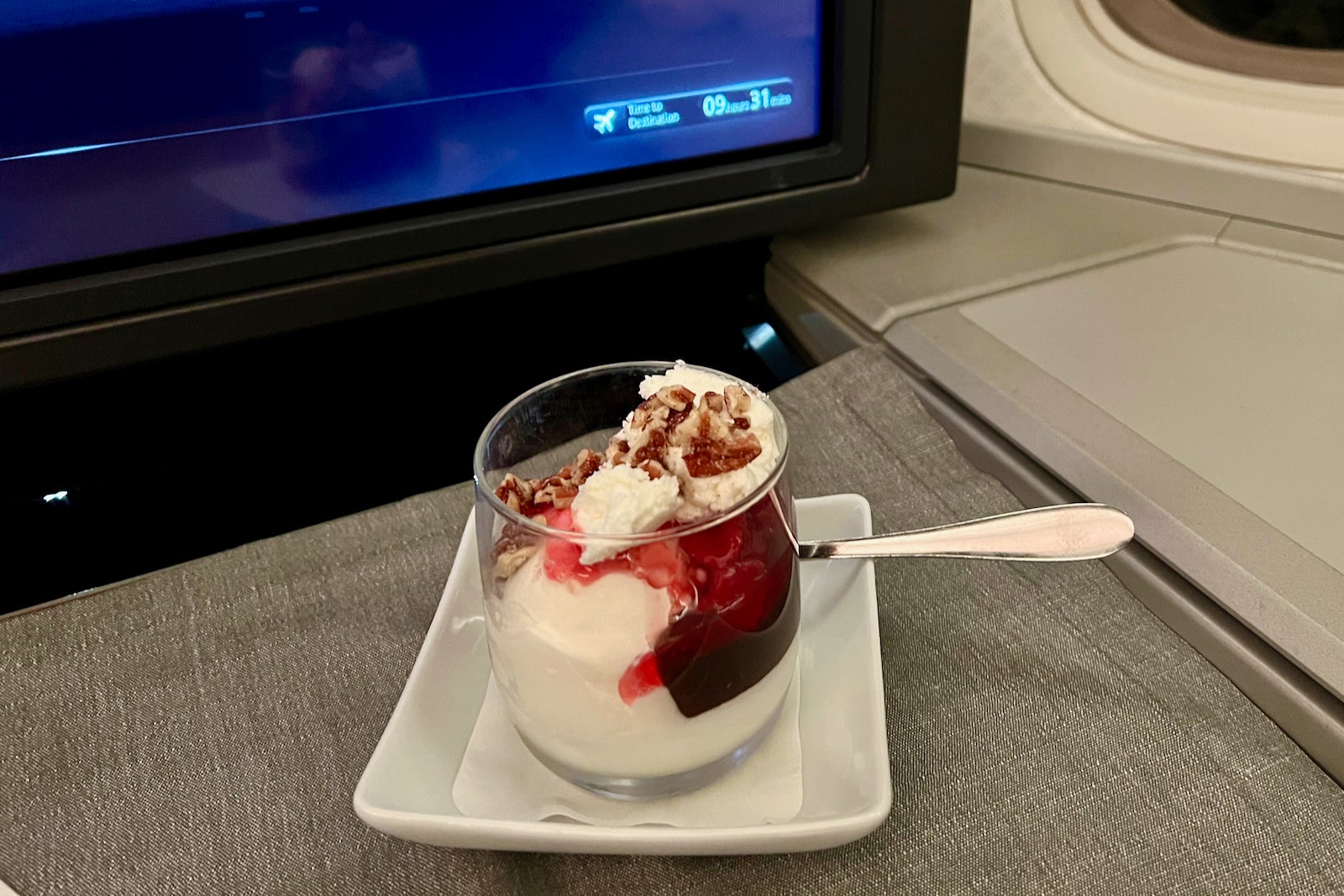
Orders were taken verbally — hot fudge, seasonal berries, whipped cream and pecans for me — and moments later my confection appeared from the galley.
Ice cream is my favorite dessert and flying is one of my favorite activities. Combining the two is a recipe for a very successful trip, and I’m personally thrilled to see the ice cream sundae make a comeback on American.
In between meals, a selection of packaged snacks (similar to what you’d find in domestic first-class) along with some hard fruits and 8-ounce bottles of water were available in the galley between the two business-class cabins.
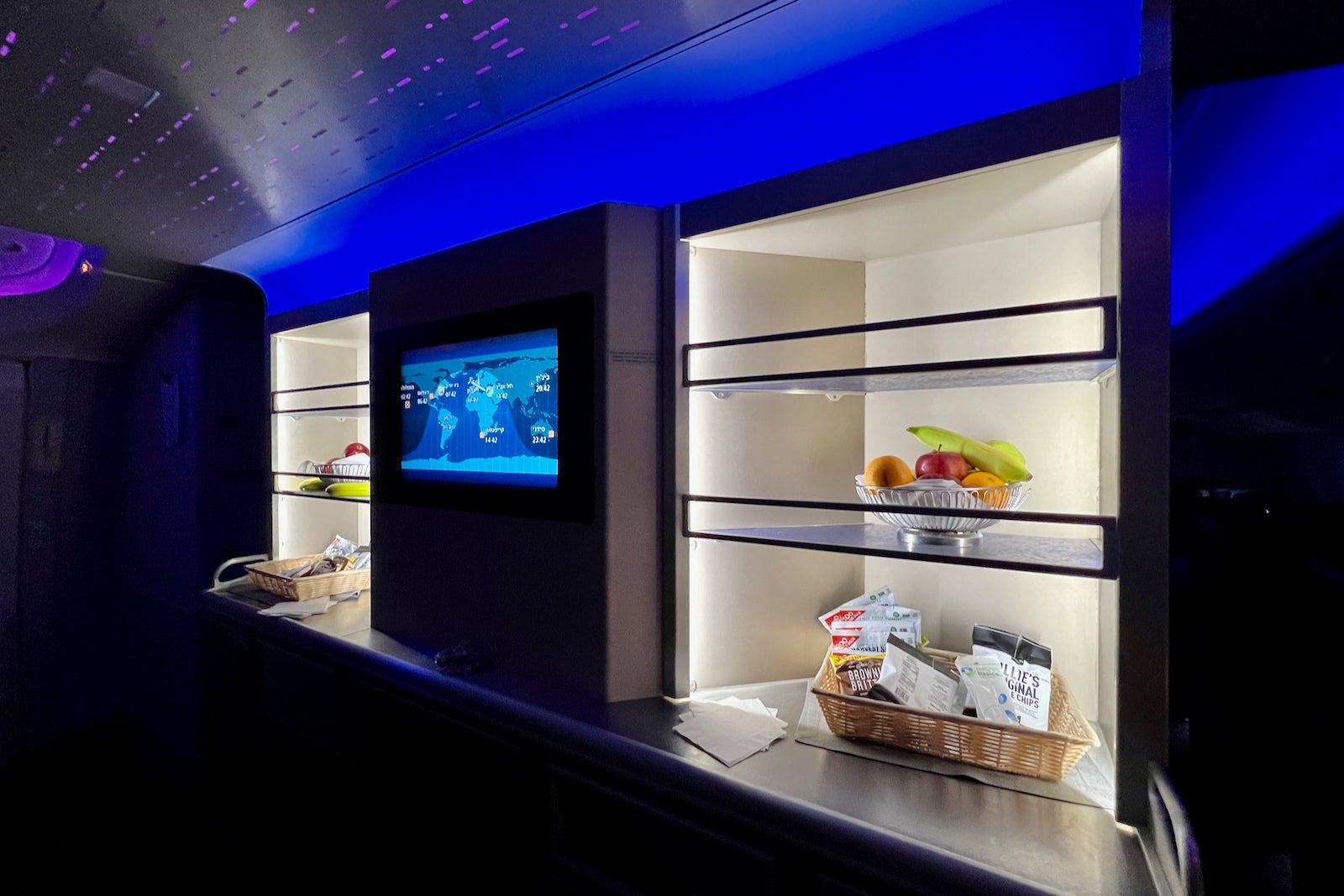
About an hour before landing, flight attendants passed through the aisles with carts to serve breakfast.
Options included a cheddar omelet or a fruit plate. I selected the latter — I usually avoid eggs on planes — and I was impressed with the size of the fruit plate. (It wasn’t just the classic three pieces of fruit that are often served on planes.)
The meal was served with a choice of breakfast bread (biscuit or croissant), and a Chobani yogurt.
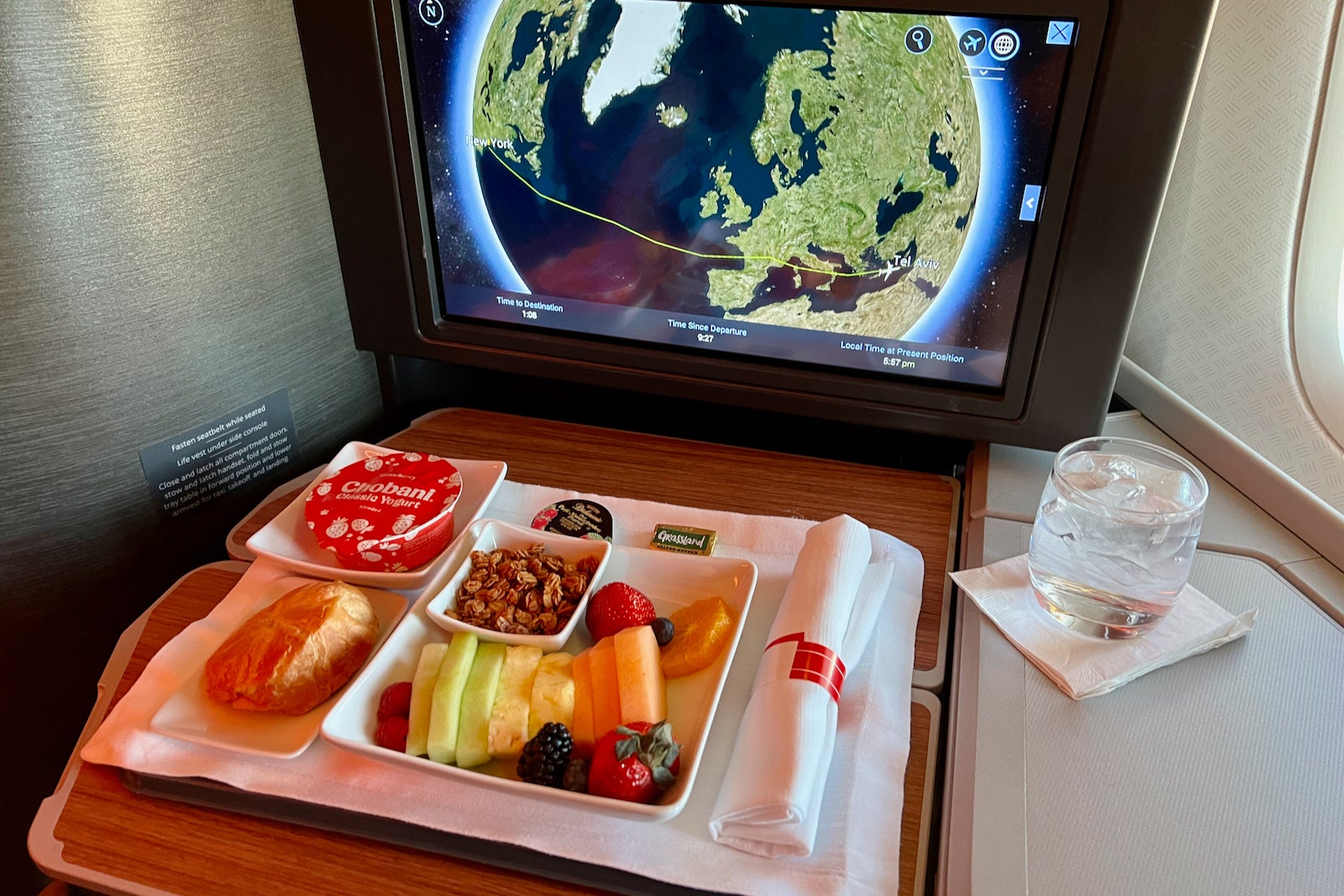
American’s catering was a notch above average for this route, and especially generous for a mid-pandemic flight.
I appreciated the return of glassware and ice cream sundaes, along with dinner service that was plated in multiple courses at a time when many airlines have gone to single-tray service only.
Service
In my experience, service is generally hit or miss when flying on U.S. carriers, especially on American Airlines.
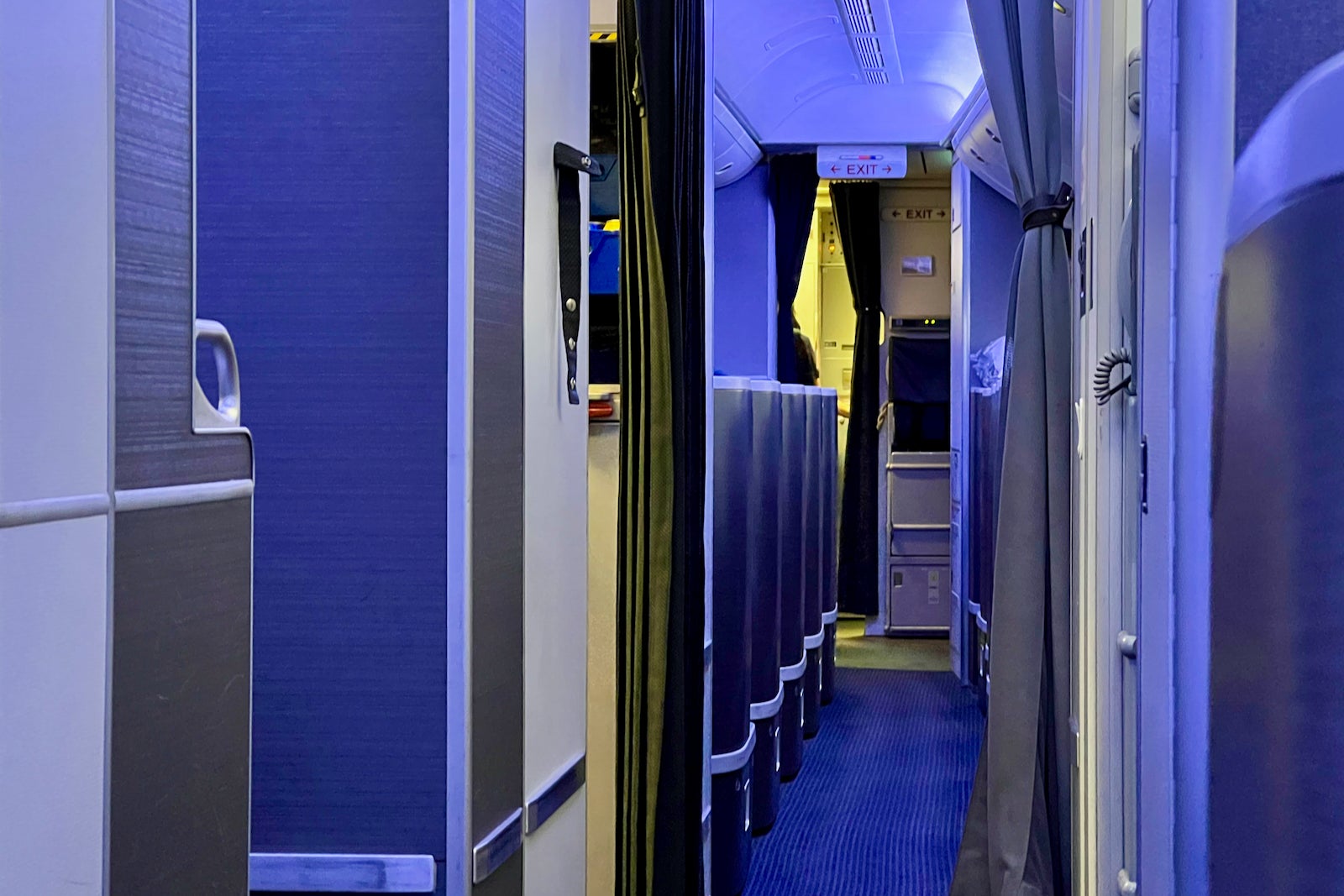
This crew was well above average compared to other recent flights I’ve taken on the carrier, though. I was addressed by name at times, and the flight attendant taking care of my aisle, Caroline, was quite friendly and engaged me in conversation during the meal service.
In terms of the service flow, there were no pre-departure beverages. Hot towels have made a comeback, though — they were distributed before dinner.
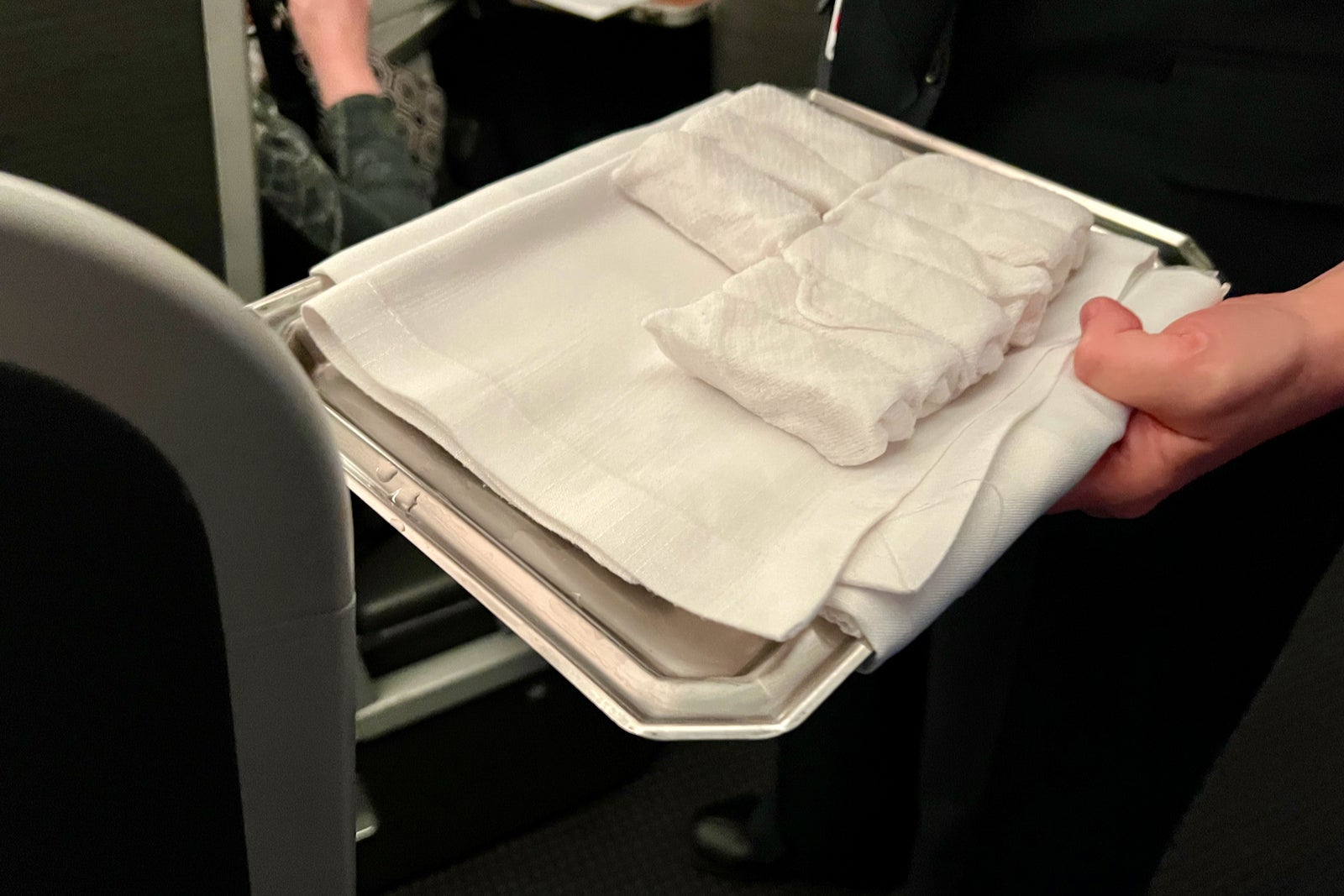
I particularly appreciated how fast the crew hustled to serve dinner after the 11:55 p.m. departure from New York. The cabin lights were out one hour after takeoff — pretty impressive for a three-course meal. (It helped that many passengers skipped dinner entirely.)
All service, except for the dinner entree and ice cream sundae, was performed from carts, which also helped speed up the process.
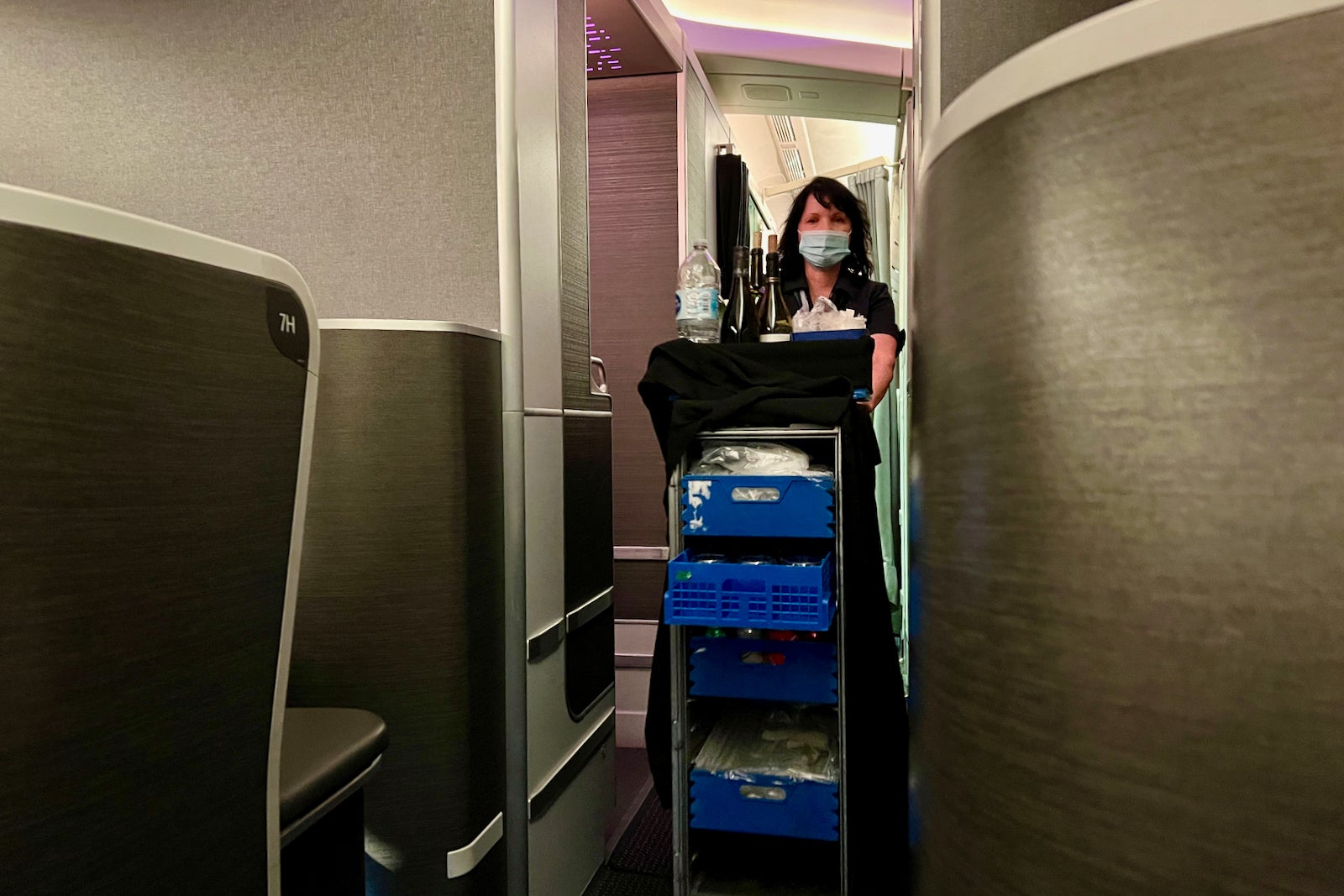
While this didn’t affect my flight experience, the biggest surprise was that American didn’t staff any Hebrew-speaking flight attendants on this flight. All pre-recorded announcements and videos were read in English and Hebrew, but the flight attendants themselves couldn’t speak to a sizable portion of the passengers.
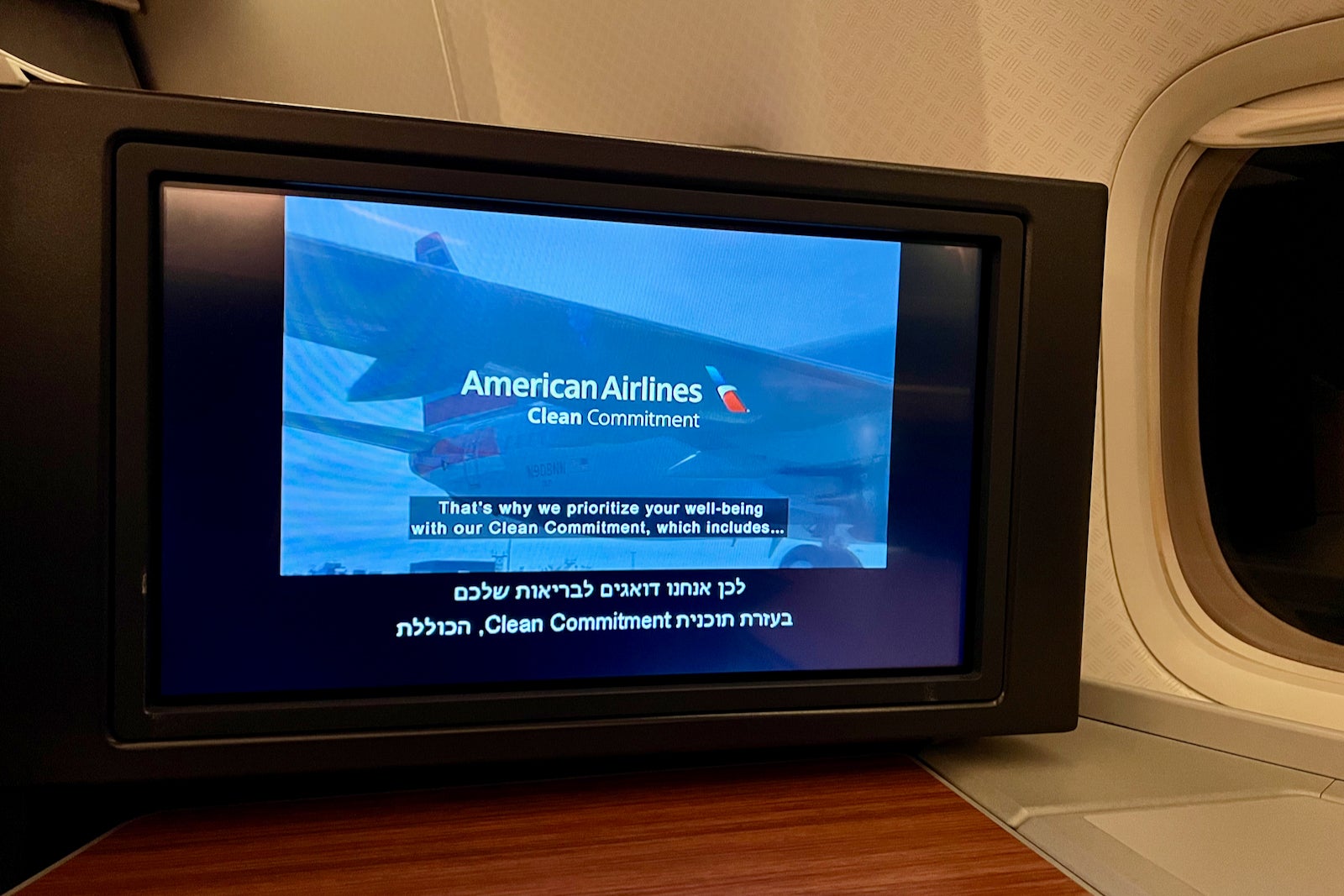
I’m not sure if this is a temporary issue with staffing or a strategic decision on American’s part.
Bottom line
American Airlines’ return to Israel is marked with a bit of inconsistency.
If you luck out with the top-notch business-class product that I experienced, you’re poised to have a great flight. The seats are incredibly comfortable and offer a substantial amount of privacy, even without having a sliding door.
American’s ground experience from its hubs includes access to the Flagship Lounge, a cut above the traditional Admirals Club. The inflight entertainment software is robust, though the amenity kits and bedding pale in comparison to American’s competitors.
The big question, however, is which plane configuration will you get? If you wind up with the far inferior rear- and forward-facing seats, you’re bound to have a completely different experience than I did.
If you’re willing to chance it though — and you end up hitting the jackpot — you’ll be in for a treat.
Featured photo by Zach Griff/The Points Guy.
